THE WINE MERCHANT.





Clitheroe merchant hopes original King Street premises will be refitted by Christmas following three years of closure
The famous Victorian cellars of D Byrne & Co could be reopened before Christmas.
During the pandemic the Clitheroe wine merchant vacated its labyrinthine shop, where the business was originally established in 1879, and began retailing from its nearby warehouse.
“It was purely out of necessity,” says director Joseph Byrne. “With social distancing, the cellar became one in and one out, so we would have been potentially crippled if we didn’t do something drastic.”
Having successfully traded from the spacious Brewery site in Shawbridge for the last three years, “it works better than we anticipated,” admits Byrne, who adds the business will continue to use the modern premises as its operational hub.
But the Byrne family hasn’t forgotten about its original and much-loved shop on King Street, which has been undergoing a bit of a facelift including some serious restoration of the cellars, all of which is edging towards completion.
“We’re now building towards getting the shop back up to full capacity and it’s good to see the original shop back up and doing,” says Byrne.
“The cellars aren’t in use at the moment, unfortunately. Over the past two years the shelves have been eaten by woodworm, so we’ve almost had to rip everything out and start again.”
Dog of the month: Gilbert D Byrne, Clitheroe KERB in Manchester is one of several independents which design and produce branded T-shirts to sell to customers. Read about how it's done from page 27“Despite the constant media doom and gloom, the trade is still there and people still want good wines.”
I read these words from Tony Howard, owner of Dickens House Wine Emporium in Rochester, in the current edition of Hallgarten’s entertaining Assemblage magazine. My first reaction was delight to hear such good news from a part of the world where the economy has a reputation for waxing and waning. But then I thought: I wonder if he’s talking about us?
The Wine Merchant has a vested interest in bigging up the independent wine trade. And, since launching in 2012, this hasn’t proved too difficult. We try to be honest about the challenges that indies are facing, and those seem to have been arriving on a conveyor belt for several years now. But we’ve always reported on more shops opening and growing than closing – until this year.

Even casual readers of our Comings & Goings section will have noticed some depressing stories of late. Debbie Gallacher, whose Rugby store recently closed after just under five years, sums up the main problems: “Low footfall, low sales but still high bills.”
One very experienced merchant I’ve been corresponding with reckons things will get worse. “It’s going to be the toughest year, from what I see coming down the line, with as many as 10% closures in the independent trade,” he predicts. “There have probably been too many openings.
“There is so much headwind: interest rates haven’t really hit yet, duty has increased massively, and the supermarkets have the ability to hoover up loss leaders,” he adds.
I don’t question anything he says. And yet, just as he reports that his own business is doing pretty well, so we hear similar stories from indies across the UK about summer sales being remarkably buoyant, all things considered (though September is traditionally a testing month for many).
We’re once again writing about merchants opening, or expanding. We’re not involved in any cover-up: we just haven’t picked up news of closures this month.
That’s not to underplay the problems that many indies still face, or to pretend there won’t be more casualties before the year is out. But it’s entirely possible that the worst is over, and that this innovative and resourceful sector is once again demonstrating its resilience.
Editor and Publisher: Graham Holter graham@winemerchantmag.com

Assistant Editor: Claire Harries claire@winemerchantmag.com

Advertising: Sarah Hunnisett sarah@winemerchantmag.com
Accounts: Naomi Young naomi@winemerchantmag.com

The Bottle of Hastings is now under new ownership and expected to reopen later this month.
Established in 2022 by James Hickson and Gina Hewitt, the shop is now owned and run by Victoria Wilken.

Wilken, a business psychologist and former teacher, says she first “dipped her toe” into the world of wine 10 years ago at a cellar door in Australia. Since then, she’s had “hobby jobs” as a tour guide at Ridgeview Estate and Sedlescombe Vineyard and later at The Bottle of Hastings.

“Again, that was part time,” says Wilken. “I thought, it’s quite nice working in a shop, but it would be great to actually have a shop. And then of course they were selling, so I’m just going for it.”
Wilken is studying for the WSET Diploma, having completed Levels 2 and 3 during lockdown, and is looking forward to putting her knowledge to the test when it comes to buying her own wines.
“I think part of the joy of actually having the shop is for me to choose the stock,” she says.
“I’m in the midst of looking what I want to do. They had a lot of suppliers and I will reduce that because I don’t want to have such a big range, and I want to build up those supplier relationships.
“I will offer more drinking-in and I want people, especially if they are on their own, to feel really comfortable to come in and read a book or browse a magazine. We’ll still be very much retail, but more of a destination place.
“I’m thinking about just having that one wine wall and I’m probably going to be offering something for everybody and then building up slowly, because obviously with any start-up business, it’s all about managing cash flow.”
Wilken has also added a coffee machine, extended the opening hours and will
eventually offer cheese and charcuterie to complement wine flights.
Drew Carr, the previous manager, will be staying. “He’s brilliant,” says Wilken.
“I totally believe in the shop. It’s a great location. I’m really excited about it – I almost can’t believe it’s happening. I’m trying to keep a lid on my excitement so that I don’t burn out.”
Sarah’s Cellar in Battle, East Sussex, is moving to a bigger premises in the town, incorporating a wine bar as well as retail space.
Owner Sarah Truman, who launched the business in 2020, says she’s been looking for a larger location for some time.
“There is a risk in going bigger, but I think in the current climate, if you’re just relying on retail footfall, you’re going to struggle,” she says.
“I love my shop but, with its size and the way the market is at the moment, I think I’ve reached my limit.
“[The new shop] is slightly off the high
street, which is just perfect for deliveries.
“It’s going to feel quite different because I’m going from a beamed, small, lowceiling place to a more industrial feel with quite high ceilings and brickwork, so I’m embracing that aspect. I’m doing a full refit so it’s going look amazing. I want all my current customers to walk in and be wowed. That’s what I’m aiming for.
“The retail space will be really clear to people, because retail is predominantly what I do and that’s what I want to stick with. But having that hybrid option, being able to offer something a little bit more … I think there’s space for it in Battle, because there isn’t anybody doing it like this.”
Truman has a reputation for thorough research so it’s not surprising to hear that, in preparation for her move, she recently spent a weekend shopping in about eight indies around the south east.
“I introduced myself and they were absolutely brilliant,” she says.
“They gave some real gems of advice about what they sell and what’s popular, and just shared experiences. It was such a lovely thing to do. I think everyone should go out and just spend the day chatting to other people.”
Victoria Wilken is “trying to keep a lid on her excitement”
Alex Prymaka, the former manager at Bedford Street Wines in Covent Garden, has opened wine bar and bottle shop in her hometown of Broadstairs.

No 1 Oscar Road is a collaboration between Alex and her partner Josh Longstaff and their friends Chick and Ben Halton.
“We’ve been going for four months now, which has been really great,” says Prymaka.
“There are quite a lot of fine-wine collectors and people that work in the industry who live in Broadstairs, so it’s been really fun to get to know them as well.
“We’ve started Broadstairs Winos, a little club of people that have private wine collections or work in wine. Everyone brings a bottle of something that they really like from their cellar and does a little talk on the wine, and we provide food. It’s just a nice way to socialise and talk about wine, really.”
Prymaka is keen not to encroach on the territory of fellow merchant and friend Mitch Swift, who owns The Bottleneck nearby. “Lots of people are focusing on local, and I don’t want to tread on Mitch’s toes; I would like to offer something different,”she says
"I’ve always stocked Simpsons, Davenport and Rathfinny. I studied at Plumpton, and Rathfinny is close to my heart. I’m getting some new wines from Gutter & Stars in Cambridge. No one else is stocking him around here, and he’s a friend of mine, so I thought it would be really great to get his wines in.”
Prymaka also reports that the more premium wines on the Coravin are doing well.
“There's definitely a discerning crowd that wants to drink good wine, and also wants to learn about wine,” she says. “I was a bit sceptical at first but we’ve got things
Riaz Syed has sold Stonewines in Barnet (see story in his own words on page 16) to husband-and-wife team Kam and Rekha Singara.

The store has been rebranded as Aark Cigars & Wine.
“We own another retail premises in Harrow, which is a specialist tobacconist; mainly cigars, rolling and pipe tobacco,” Rekha explains. “We felt like we had maximised everything we could possibly do in that shop and we were at that stage where we needed to expand.”
Rekha admits that this is all a bit of a “challenge” as neither she nor Kam has any more wine knowledge than the average consumer. But armed with her WSET Level 1, a list of helpful suppliers and plenty of enthusiasm, she’s already working on that. Plus she’s spotted some interesting parallels with the world of tobacco.
like chilled reds on our by-the-glass list and people are just really excited by that.”
The shop, which accommodates up to 12 people seated, has a 75-25 split in favour of the bar, but Prymaka says with the business growing organically, retail is increasing with online orders and the imminent introduction of Deliveroo.
• The Oxford Wine Cellar, due to open in the city centre, is the latest addition to the Oxford Wine Group. The new bar will follow the same concept as the company’s Oxford Wine Café in Jericho, with more than 200 wines available.
• Correction: In our August edition we referred to Kilo Wines near Loughborough and Marcato Direct, one of its suppliers, as sister companies. This is incorrect: Marcato Direct is purely Kilo’s specialist Italian supplier and one of several such businesses working closely with the retailer. Apologies for the error.
“There are a lot of common things with the harvesting, the types of soil, how the weather has been that particular year –that determines the flavour in a cigar, and every cigar has a different flavour profile,” she says. “Cigars also age very well, like wine. There are vintages that people have kept in their humidor for years and years.”
Rekha says the shop will be a “50/50 split, with one side of the shop being dedicated to wine and the other side for people that want to buy a cigar and have a whiskey or rum with it too”.
Although the store has undergone a “light refurb” to include new flooring and lighting as well as under-counter fridges, Rekha says she wants the locals to still feel comfortable and confident that they’ll find their favourite bottles inside the shop in its new form.
Wine merchant Alan Norchi has returned to bricks-and-mortar retailing in Plymouth after a hiatus of operating online only.
Norchi and business partner Dominic Trounce launched Barrel & Still in 2016 and a second shop in 2019. Trounce continues to run the original Kingsbridge shop in Devon, while Norchi has just taken over and rebranded the second site in Plymouth as Orlando’s Wines & Spirits.

“I like bricks and mortar. I still believe in it,” Norchi says. “I think people still like to go shopping. The service and advice you get from an indie is hard to give with an online business.
“I used to phone customers and chat through their choices, but there’s nothing like coming into an attractive shop and talking to someone who can give you good advice. I’ve got beautiful looking wines, which I think got lost in translation online.
“When Dom and I split, I launched Orlando’s as an online Italian wine specialist. He carried on at Kingsbridge and then he opened in Plymouth, which was something we had talked about doing together. It was open until January this year and because Dom couldn’t manage to get in as often as he wanted; I came and sat here and did my work while I covered the shop for him. When he closed it, I just reopened under the Orlando’s name.”
While trading online, Norchi focused on a specialist range to avoid getting sucked into a price war.
“Ultimately it’s bloody hard to get noticed online and stand out from the crowd,” he says. “I’ve got a passion for Italian wines. I am more than half Italian, so that was a kind of romantic notion, but it was also about trying to be niche and specialist and it did work a little bit.
“I’m doing some direct importing for Monte Rosola from Tuscany and I’m the

sole UK distributor, so that helped me get noticed by a few people. But in the end I just wasn’t making any real headway. I certainly wasn’t getting a living out of it.
“I’m finding this a little bit scary because I’ve got rent to pay, but it’s a city and there are plenty of wine people here.”
Although no longer an Italian specialist, about 50% of Orlando’s range is Italian. “I think for wine adventurers, Italy offers endless exploration,” says Norchi.
Spirits also play an important role at his Plymouth shop. “There’s a lot of rum drinking going on and a lot of whisky drinking. I’d say the spiced rum – and the rums generally – seem to be for the slightly younger market. And I’m also selling, as Dom did, a lot of whisky to an older demographic.”
Orlando’s is based on a peaceful no through road next to a bistro, with which a potentially useful tie-up may be on the cards.
“He’s thinking of not having a wine list, telling people to come next door, choose their wine and then just pay him corkage, which is simply a lovely idea,” says Norchi. “He gets a cash margin, I get constant sales and people will probably come in here for
a £15 bottle, give him a tenner, for a wine that might easily have been £35 on the wine list. So it’s a great deal and will suit customers as well.”
Norchi also takes a view on margin that he knows is controversial among fellow retailers.
“I believe in volume over margin,” he says. “A lot of people I have chats with say they would not cut the margin, but I’m really happy to play around with it. If I have to take 50p off a bottle to bring it into a price bracket, I will, because I’d rather sell it.
“Why not be a bit flexible and why not keep people coming through the door? Some people say that over a certain point, people don’t really notice the price very much. If you’re £25.50 instead of £26.50, nobody is going to care very much about that, which may be true, but I think if you’re £10.99 and you get that under a tenner, people do notice it.
“Maybe it’s just choosing the right wines to be flexible with. I wouldn’t bother cutting my margin on a £30 Bordeaux or whatever; I’d probably leave it where it was. You can’t cut off your nose to spite your face.”
Chanctonbury Wines is set to open on Steyning High Street, West Sussex, on October 4.
Robert Maynard, one of the team behind the award-winning restaurant Wild Flor in Hove, is becoming a full-time wine merchant.
“I’m a major partner in the restaurant and that’s not changing, but my day to day will be at the shop,” explains Maynard.
“By the time my wife Beth and I open the shop, we’ll have a couple of kids, so it was a good time to look at a little step-change in life. The restaurant business is great – I love it. But my specialism is the wine side of things and I thought, how can I use that with potentially a bit of a better work-life balance?”
Although he’s spent many years in the off-trade, Maynard is no stranger to retail, having worked with Brighton merchant Henry Butler for a couple of years prior to opening Wild Flor.
“I do a lot of business with him at the restaurant as well. Henry and Cassie are among my best friends. So I know retail is hard work, but a slightly different pressure threshold.”
The 70 square metres give Maynard “plenty of room to play with”, and while he admits it’s fairly inevitable that he’ll end up “filling it with as much stuff as possible,” the vision for now is to create a more stylish space complete with plants.
In terms of stock, he says: “I intend on stocking it the way I write a wine list, which is really to have wines I think are great, that are delicious and present really good value.
“I don't really buy into shipping in cheap wine from the far reaches of the world, but I really like bringing great value wine from lesser-known parts of Europe to the fore. I think there’s still so much there that isn’t even explored.”
Grays & Feather is opening a further two sites in London.
Owner Andrew Gray launched Plume in Covent Garden in 2018 and, before the end of this year, Finch will open in Brixton, followed by Peregrine in Leadenhall Market.
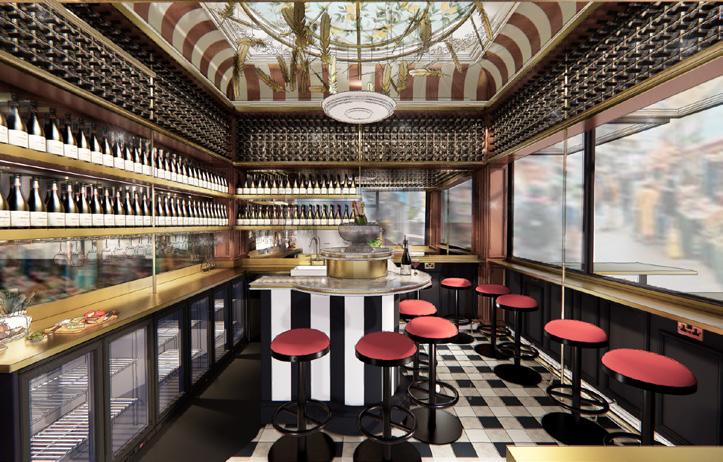
Like Plume, both will be hybrids, and Gray will be tailoring the offering according to each location.
Finch, scheduled to open at the end of September, will be occupying the former site of Brixton independent The Wine Parlour, which closed at the end of last year. “It will be 35 covers, and we’ll have treats like cheese boards and burratas and also lobster rolls, and we’ll see what else we can make work in such a small site,” Gray says.
“They are both fairly small sites and they are very community focused. Brixton will have much more of an English focus and the wines will be a bit more off-piste with a focus on natural wines, whereas Covent Garden is more traditional.”
Leadenhall will see the arrival of Peregrine in November if everything goes according to plan.
“At Leadenhall I doubt any natural wines will be listed,” says Gray. “They will be more iconic and premium. I’ll take inspiration from what’s already there, but it’s a very interesting mix with a lot of tourists at the weekends.”
Before he found his permanent base in Covent Garden, Gray had a pop-up on the South Bank, specialising in fizz, which continues to be the case.
“We have more bubbles than anything else,” he says. “In Covent Garden we’ve found that the demographic is so broad, you have everyone walking through the door, so you have to represent more or less everything, so we added on cocktails and beer quite quickly.
“My wine list is about 100, but I have more sparkling by the glass than still wines.”
• Cru Wines in Bradford-on-Avon, Wiltshire, had debts of £166,445 when it went into liquidation in the spring, according to figures from Companies House. The biggest supplier creditors were Hallgarten (£7,775), Babylonstoren (£1,190), Swig (£1,180) and Les Caves de Pyrene (£753). HMRC was owed over £5,500. Lianne Olivier, who was owed £41,500, set up the business in 2019 in Silver Street, on the site that was previously home to Ruby Red Wine Cellars.

I’m not afraid of getting a one-star Google review. It makes the five-star ones from friends and family look more authentic. My daughter, on the other hand, thinks I should be lovely to everyone just in case, but I’m not sure I’ve got the energy.

I’m pretty sure I know who gave us the one star because he complained I could have said more than just “no”. I did, but he’d wandered off by then. I’m sure it was a lad who stuck his head around the door and said he’d been to Spain and did we have any Spanish cider? No. Can we get any? Again, no. We do stock a few very local ciders from just down the road, so I’m not planning to import a container of “sidra”.
By that time, he’d taken the hump and slouched off, so I had to stand in the street and shout it. He just wanted to impress the girl he was with by having a conversation
with, and getting one over on, the local wine shop. Sadly his knowledge of anything more exotic than Diamond White extended to a sidra he’d once had in Spain.
I can’t imagine going to another country, especially one so famous for wine, then coming back to Dorset and looking for the cider you drank on holiday. But then again I can’t imagine having an extensive facial tattoo and wearing tracksuit bottoms with my pants showing either, so maybe it’s me who is out of step.
We’ve all had them. They come into the shop and whip out their mobile. Then there is the long, embarrassing silence while they scroll through a thousand photographs before showing you a picture of something nasty they had on holiday. Do you have that? Not that exact one, but we do have a few other wines … No, it’s this one I’m
looking for. We had it in a taverna, at the top of a mountain on a tiny Greek island, 10 years ago, and haven’t been able to find it again. Can you get it?
I then have to explain that not everything in a bottle is available in the UK, and stuff that doesn’t get as far as a bottle rarely leaves the village. Can I recommend something they might like? Then they’ll know where to get it. No. We like this one – and it was only 50p a litre. I wish they would be more honest and just say, “Hi, are you busy? No? Then do you mind if I tell you about my holiday? I’ve got pictures.”
If they think I’m being awkward by not at least trying to see if I can get the wine they want, I have to explain the logistics. But first I ask how many they might buy. Oh, just the one? That’s the problem, you see. If it’s handled by an importer we use, I could get 12. If not, the minimum is likely to be 120. If, as I imagine, you want me to import it, then the minimum to be cost-effective is about eight pallets. Mind you, as I don’t usually import stuff I’d have to pay the duty up front and that’s likely to be tens of thousands of pounds.
If they then tell me I shouldn’t worry as it’s so nice I’m sure to sell it all quickly, I’m likely to go down for assault, so a one-star review is probably the better option all round. And just saying “No” saves so much time.
This was probably one of the best recent ones.
“Do you stock this rosé?”
“No, but we have lots of others.”
“I want this particular one.”
“Where did you buy it previously?”
“It was in a restaurant.”
“OK, well, you are unlikely to find it in a retail shop because restaurants tend to have a different supply chain so they aren’t embarrassed by charging you £40 for something you can get next door for a tenner. Sometimes they overlap. Out of curiosity, which restaurant was it?”
“Nandos.”
“You will probably have to go there, then.”
On another occasion I was trapped by someone in a pub who knew I had a wine shop so wanted to share his experience. Unfortunately his experience appeared to be having drunk a glass of wine … once. He started by saying that he had enjoyed the wine and it was so good I should sell it. To humour him, I asked what it was. He couldn’t remember, but insisted I should stock it.
Then there was a game of 20 questions. What country? Can’t remember. OK, where did you drink it? In a restaurant. Local one? No, in the Lakes. OK, this wine that I should stock as it’s so good: let’s start at the beginning. What colour was it – red or white? Can’t remember but it was great – you should stock it. Well perhaps we should, but we like our wines to be a bit more memorable.
I know when I get into these conversations that I’m wasting everybody’s time. There must be people who spend their entire lives going into every shop they see in the forlorn hope they will, serendipitously, find that one bottle they once drank and that isn’t on the internet.


I thought they were mad. However … the other day I was in Lymington and wandered into an Oxfam second-hand book shop. I was looking for an elusive copy of a particular book. As I stepped into the shop, there it was – right in front of me, on the middle of the shelf, all gleaming and pristine. I picked it up, gave the guy a tenner, said “keep the change” and went out again. No conversation. Five-star review.
Trawler fishing and tree surgery are rightly considered dangerous occupations. But we can add to the list the sometimes overlooked job of producing cartoons for wine merchants. Artist John Carter accepted that commission at D’Arcy Wines in Cheltenham, creating some jolly artwork for “the website, vans, warehouse walls and most of our stationery,” explains the company’s Hope Howells. But he had reckoned without the hazards involved. “Whilst working on the warehouse wall mural, John stood on barrels for height. Unfortunately he fell through the lid of the barrel, badly cutting his shin. So there was a visit to A&E, where he regaled the staff with his story of falling into a whisky barrel. He dined out on that for ages.”
magazine for English and Welsh wine producers, contains all kinds of ads for suppliers of pneumatic presses, corks, bottles and tractors. But also one from a firm of solicitors specialising in divorce proceedings.
That’ll teach us to make silly jokes about Blur members and their winemaking exploits. Furleigh Estate has been in touch, pointing out that Alex James’s Britpop wine is very much traditional method, rendering our “charmat man” gag null and void. Ian Edwards advises: “The Britpop wine is described as English Quality Sparkling Wine. Only wines made by the traditional method may use this description.”
Perhaps owning and running a vineyard isn’t quite the recipe for domestic bliss that some dreamers imagine it to be. The July edition of The Grape Press, WineGB’s excellent
Cancel culture at its best American YouTuber Tana Mongeau’s malicious comments about a wine professional have prompted Babbel, the language-learning platform, to cancel her sponsorship deal. In a recent episode of her podcast, Mongeau said of wine tour guide Cynthia Coutu, “I absolutely want her dead”. When reading out an advertisement for Babbel, she included the line, “And with Babbel I could have told Cynthia, the wine tour lady, to shut the fuck up in her native language.” Cynthia’s crime? During a guided tour of Veuve Clicquot, she didn’t supply the “influencer” with enough wine. We can only hope that the title of the podcast, Cancelled, turns out to be prophetic.

Robert

LWF
Chris Porter c.porter@kukla-spedition.com
Do you know how to operate a corkscrew?

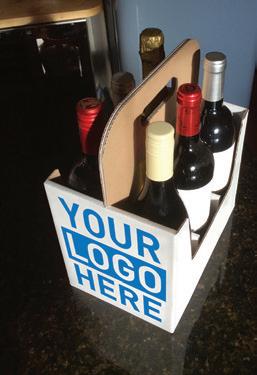
38%
NOT YOU AGAIN!
customers we could do without
Well I was in the pub on Sunday and I was rather taken aback by a couple of blokes who were sitting there quite happily drinking a bottle of rosé wine … I mean I’ve got nothing against people living however they like and it’s none of my business … but I half expected them to get out their knitting … as I say it’s their affair not mine, but in my day pink wine wouldn’t have been considered very ... masculine … which is apparently another word that upsets the woke brigade, I was reading the other day … you’re not allowed to describe a drink as being “butch” or “feminine” in case somebody gets offended … utter poppycock … it’s just scientific fact that men and women have completely different senses of taste, though of course you can’t say “men” or “women” these days without people throwing paint all over your door, or worse … I’d better shut up now and keep my unpopular opinions to myself before they deport me to Rhodesia or wherever it is … now, what was that Islay malt whisky that my wife adored, and do you have any of my favourite Vouvray?
•
•
•
•
•
•
•
Can you unscramble these South African wine producers? If so, you win the rewilding of your high street.
1.
3.
2.
4.
5.
Imports have become a huge part of Theatre of Wine’s business. When it became clear that a dedicated person was needed to handle the increasingly complicated logistics, director Jason Millar didn’t need to look any further than the shop floor.
“Becky was working at our Leytonstone store as a trainee manager, and we saw and heard someone who was very focused, persistent and conscientious about things,” he says. “My co-director Jon and I told her we thought she’d be perfect for the role of imports manager.”
One year on, Jason describes Becky as being “one of the really critical people that keeps the wheels turning and makes sure that everything happens on time, and we don’t run out of stock”.
He adds: “As we’ve grown, we’ve really tried to appoint people to roles in the business that we think will work for them as a way of retaining talent and keeping it in the family. I’m just very happy that we’ve been able to ensure that people who are as good at what they do as Becky is are still with us.”
Becky previously worked in corporate governance but admits it wasn’t for her. “I had that amazing combination of being busy and bored at the same time,” she says. “Now I’m busy but never bored. I’m working in an industry that I really enjoy.”
Having completed her WSET Level 2 before she took the job as trainee manager in 2021, Becky was ready to throw herself into the wine trade. “When I joined that September, the directors were really generous with their time and expertise,” she says. “They said to treat it a bit like an adult internship: to learn as much as I could about every part of the business. They said, ‘if there’s something that that sparks your interest, always feel free to ask us’. They were great.”
As for her importing role, Becky says that, although she felt she had some transferable skills, getting to grips with the ever-changing rules and regulations of importing was tricky to say the least. “The learning curve was basically vertical,” she says.
“When I first started, one of the directors was explaining that it’s more difficult than it was pre-Brexit, but of course I didn’t really know any different; all I know is this is how we do it now. There are still some things that
are really quite volatile, like fuel surcharges, and we’ve got the looming possibility of new importing labels that will materialise at some point. Because it’s a complete baptism of fire, you kind of just take it as it is. This is the operating environment.”
However frustrating red tape can be, Becky keeps it all in perspective by having an eye on the bigger picture. “Talking to customers, selling them wine, doing tastings and retaining that excitement of wine is really important,” she says.
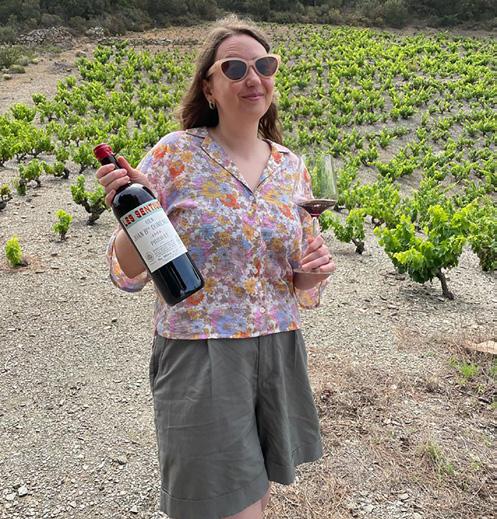
“Unless you’re keeping up with your wine knowledge and understanding what you’re doing it all for, you might as well be importing bottles of shampoo. It’s actually quite exciting when you sell a bottle to somebody and you remember emailing the producer months ago to get the wine into the country. You’ve seen every step of it getting here and you think, ‘this one is really special’. ”
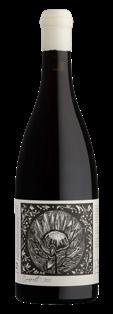
If you’d like to nominate a Rising Star, email claire@winemerchantmag.com

There’s a sad legend behind the name of the wine, involving the untimely demise of an Inca princess, but it shouldn’t detract from the pleasure that this blend of 40% Cabernet Sauvignon, 35% Carmenère and 25% Syrah from Aconcagua provides. Lovely dense blackcurrant and black pepper flavours, lifted with some herbal freshness, perfect for mellow autumn days.
RRP: £21 ABV: 14%

Delibo Wine Agencies (01993 886644) delibo.co.uk
Berlucchi pioneered Franciacorta as a sparkling wine style in the early 60s and remains one of its undisputed star performers. The dosage may be zero, but there’s nothing mean here, with lees ageing in barrels adding a generous depth to flavours suggesting patisserie and stone fruit, all underpinned by a taut but far from searing acidity.

RRP: £45.49
ABV: 12.5%
Hallgarten & Novum Wines (01582 722538) hnwines.co.uk

You can taste this wine for the first time and not realise it’s from Casablanca, or that it’s Sauvignon Blanc. We’d feel better if you did, because that’s exactly what happened to us – and yet now it all makes sense. A lovely full, rounded mouth feel, some peachy notes and a suggestion of grass. Beautiful stuff.
RRP: £14.99 ABV: 13%
Boutinot (0161 908 1300) boutinot.com
These days it’s worth giving serious consideration to any wine with an ABV of 11.5% that also hits the shelf at under £10. This Colombard/Ugni Blanc blend from south west France is seemingly aimed at Kiwi Sauvignon lovers on a budget, and while it’s less intense it’s certainly zippy, with lime and lychee notes.
RRP: £9.49 ABV: 11.5%
Cachet Wine (01482 638888)
cachetwine.co.uk
Let’s be honest, an intrinsic part of the appeal of orange wine is its prettiness, and the Sicilian producer’s first attempt at the style is visually lovely. The 80% Inzolia component spends two weeks on its skins compared to six weeks for the Zibbibo. The result is suprisingly subtle, but refreshing, with gentle citrus and spice.

RRP: £14.75 ABV: 13%
Vintage Roots (0800 980 4992) vintageroots.co.uk


The fruit comes not from the Dorset coast but from Essex, where excitement has been building in recent times about the quality of the local Pinot. 2021 saw a wet, dull summer but a warm autumn so it was a mixed bag for English winemakers. The wine reflects the conditions, with a reserved character and fresh, brambly flavours that veer towards the Burgundian.
RRP: £27.99 ABV: 13%
LBW Drinks (01297 551355) lymebaywinery.co.uk

Visio is a workers’ empowerment project in Stellenbosch, adjacent to, and overseen by, Kleine Zalze. All laudible but only worthwhile if the wine stacks up, and it certainly does. Lots of cherry and blueberry notes, a cool acidity and a silky, medium-bodied mouth feel. Paired beautifully with roast chicken.
RRP: £14.80 ABV: 14%
Hatch Mansfield (01344 871800)
hatchmansfield.com

Described as “the richest and rarest wine in the world”, this is beyond our usual budget and we were grateful for our miniature sample and big glass spoon. The first release since 2009, requiring 40kg of grapes to produce one half-bottle, it has endless layers of redfruit sweetness and cascading marmalade, but it was a vintage where natural acidity could also be relied on.
RRP: £600 (37.5cl) ABV: 1.9%
Bibendum (0845 263 6924)
bibendum-wine.co.uk
In a nutshell: Working with a local art gallery, Morgan and his business partner Edward Speakman host ticketed wine events, which include a talk by artists as well as a guided tasting.
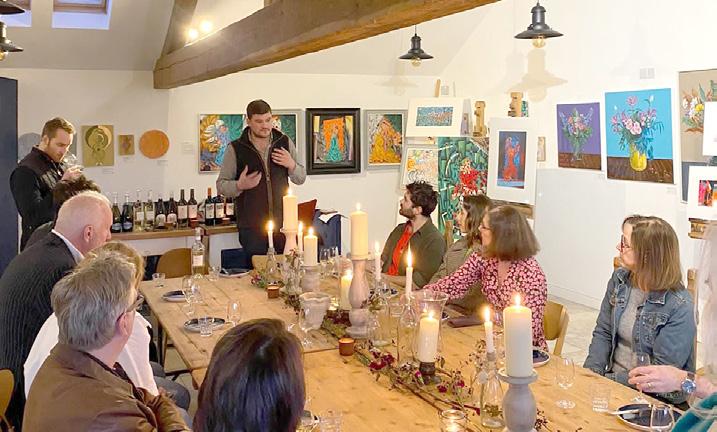
Tell us more …
“We have three guest artists from the Blue & Berry Art Gallery, who each have 20 minutes to talk about their history, inspiration and artwork. In between, we introduce a different wine. The guests receive a glass of fizz on arrival and over the course of the evening we have six wines and a selection of cheeses.”
Where do you host the tasting?
“We alternate between holding it in our shop and at the gallery, which is just 15 minutes away in Chelford. It’s a way of introducing our customers to one another and getting new faces in both spaces. They bring easels and loads of artwork here and we swap out our artwork in the bar to make space for their work. Both locations work really well. Our shop is such a lovely old building, so it lends itself to having a nice cosy wine tasting evening, and the art was quite striking against the walls. Then in their space, it’s just as you would imagine: this big open-plan white gallery with lots of light.”
Is it proving as popular as your other tasting events?
“We’ve done two so far, and they’ve been
really well received. We’d like to do more but in order to keep them fresh and relevant and avoid using the same artists, we’re doing them every other month.
“We have a similar customer base; there’s definitely a nice synergy. Tickets cost £27.50 and they sold out both times. I think maybe we could push it a bit more. For the same sort of price you’d probably only get a couple of glasses of wine in the local bars anyway, so you’re getting a wine and an art experience for a similar amount of money.”
Are we talking Banksy, Caravaggio, Hockney …?
“We’ve had a mixture of different styles of artists, and in different price brackets, too. There was a lady selling landscapes for about £400 each, and there was a man
here with a painting for sale at £15,000. It’s been quite interesting.”
Do you often collaborate with other local businesses?

“We’re always on the lookout to do a partnership event. We regularly work with a local florist for our window displays and recently won Best Dressed Window in the Tatton Flower Show. It brings so many visitors to the town and loads of people came in and asked us about our display. It’s nice to do these things and it’s a great opportunity to get involved with the community. We could just supply the wine for the art gallery events, invoice the next day and that would be that. But the wine tasting element to it is much better, and off the back of that we receive orders as well, so it’s a much better way of engaging.”
Morgan wins a WBC gift box containing some premium drinks and a box of chocolates.
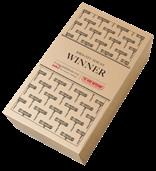
Tell us about a bright idea that’s worked for you and you too could win a prize.
Email claire@winemerchantmag.com
Private equity firm Breal Capital has bought Vinoteca out of administration, saving 150 jobs.
Vinoteca was founded by Elena Ares, Brett Woonton and Charlie Young in 2005 and they remained as directors and major shareholders until administrators at Interpath took over.

Adrian Shield
Crossing Point Wines
Kirkby Lonsdale
Favourite wine on my list
Elodie D Champagne, which we import, is truly exceptional. When visiting Champagne, my wife and I went from Mercier across the road to this small Champagne house and came out a couple of hours later with sombreros on, a little bit jolly, and the rest is history. We’ve named our daughter after it.
Favourite wine and food match
A bit random but Aleatico and Sachertorte [chocolate cake] is the most outrageous food and wine pairing I can think of.
Favourite wine trip
Without any shadow of a doubt my first trip, back in 2010, to Cape Town – mainly Stellenbosch – was absolutely fantastic.
Favourite wine trade person

Steve Day from Liberty Wines has been a great support to me since I started working with them. Our secret car park meetings delivering bottles of Hill of Grace for a birthday present, (and kept strictly off our invoice as my wife does the accounts) were fairly amusing.
Favourite wine shop
Stainton Wines in Kendal, which I also work with, has a fabulous selection. I struggle to leave without something special for myself if I ever drive through to collect an order.
American wine company Ste Michelle Wine Estates expects to purchase 40% less fruit over the next five years.
Vinoteca’s most recent accounts, for the year to March 22, show a £2.1m loss in a year that was partially disrupted by pandemic-era measures.
The company’s venues remain at London Bridge, Bloomberg Arcade, Farringdon, Kings Cross and Chiswick. Evening Standard, August 23
Australia has an oversupply of wine, equivalent to more than 2.8bn bottles, after the trade dispute with China slashed exports.
The excess wine is being stored in vats in wineries across Australia.
At its peak in 2020 the country’s export of wine to China was valued at $1.2bn. Now annual exports are worth just $8.1m, contributing to a plummeting price for red varieties and a decline in domestic red wine prices.
The Guardian, August 17
Some industry leaders believe the move highlights a wider shift in wine consumption in the US.
A representative from SMWE said: “We have started conversations with our grower partners in eastern Washington to adjust our grape supply to better align with demand and enable us to focus on crafting the highest quality premium wines from Washington.”
Decanter, August 10
The French government is allocating £171.6m to destroy surplus wine and support producers.
Most of the money will be used to buy excess stock, with the alcohol sold for use in items including hand sanitiser and perfume.
The decreasing demand for wine can be attributed in part to the cost-of-living crisis and the rising popularity of craft beer, but there is also an issue of overproduction, and money will be made available for winegrowers to change to other products, such as olives.
By funnelling money into the industry, the French government aims to stop “prices collapsing ... so that winemakers can find sources of revenue again”, agriculture minister Marc Fesneau said.
BBC News, August 26



Ocean Fathoms winery has been ordered to surrender thousands of bottles of wine.
The California-based business claimed the Santa Barbara channel was the “perfect environment” for ageing its wines and since 2017 has been submerging crates of wine into the ocean.
Santa Barbara’s District Attorney’s Office alleged that “nearly every aspect of their business was conducted in violation of state or federal law,” with the bottles not cleared for human consumption following the process.
Two of the company’s co-founders have pleaded guilty to misdemeanour charges of illegally discharging material into US waters, selling alcohol without a licence and aiding and abetting investor fraud.
USA Today, August 11
• American Airlines is now serving sparkling wine to first and business class passengers on long-haul flights instead of Champagne. Customers will be served Ferrari Brut from Trentino, Italy instead of Bollinger La Grande Année 2008. Robb Report, August 7
The Cardiff Wine Passport, an initiative to promote independent hospitality businesses in Cardiff, has generated more than £32,000 in revenue for restaurants and bars in the city since its launch just over a year ago.

The passport costs £26 and allows its holder to exchange passport stamps for glasses of wine at participating venues over a set period of time.
Wales 247, August 9
�I love this question! I don’t mind ice in wine. I think sometimes the pomp and circumstance of wine makes people feel embarrassed, to be honest, about what they like and how they like it and an example of this is having ice in wine. I say: ‘you do you’… unless it’s sparkling. That is where I draw the line.”
�It’s a shame to damage a winemaker’s creation, as ice will radically alter the perception of flavour and, once dissolved, irreparably dilute the wine, losing aromas and intensity. I’ve resorted to ice on occasion, as a warm white wine is undrinkable for me. Drinking wine should be a moment of pure pleasure for the palate. If you like it and the context allows it, why not add a few ice cubes?”
Maxence Masurier
Made in Little France, London
�I personally never do it, but I don’t raise an eyebrow when someone else does. When I used to work in restaurants, people would order very, very expensive Bordeaux with a side of CocaCola. I’ve seen it all happen but in my view, it’s your wine and you get to do with it what you like.”
Wieteke Teppema
Drop Wine, London
�There’s a bar in Cardiff that does a ‘frozé’, which is a rosé slushie, and it goes down an absolute storm. I think whatever we can do as an industry to make wine more approachable is absolutely fine. It’s all about personal preference, just like if you have ice in Scotch. Or do you have water, or do you have it neat?”
Nick LawrenceCorc,

 Barry, south Wales
Champagne Gosset
Barry, south Wales
Champagne Gosset
The oldest wine house in Champagne: Äy 1584
 Natalia Ribbe H Champagne winner H Sète, Margate
Natalia Ribbe H Champagne winner H Sète, Margate
Riaz Syed opened his Stonewines store in north London in 2015. This year, he’s sold up, calculating that the costs of keeping the shop viable are just too high. But, as he explains below, the business will survive, with a new revenue stream and lower overheads
Plenty of merchants are facing some big decisions this year. If coping with an economic downturn is not a challenge in itself, our industry has also seen several additional problems thrown in its direction: the change in alcohol duty, complexities in direct importing following our exit from the EU, and various harvest issues across the globe.
At the beginning of the summer I visited Gusbourne winery in Kent to taste the new vintages. We discussed their expectation of another heat wave similar to last year and the positive impact that would have on the UK wine trade. But only a few weeks later and that optimism had turned to pragmatism, with many of us asking what we needed to do to get through to Christmas. While I pondered the situation, I received an offer to buy my business.
When I read about a new wine merchant opening, I find myself experiencing a mix of emotions. Happiness, but also concern.
Happiness because it gives me a sense of joy that there are still people out there willing to take a risk and put into action their love of wine. It reminds me of the excitement of starting up a new venture; everything from designing the shop front to deciding the type of shelving. Every single wine merchant considers their shelving a critical component, and not just because it has to take the physical weight of hundreds of bottles of wine. It becomes a symbol for the weight of expectation. The shelving design will dictate the look and feel
of the business, the overall aesthetic. I went for industrial-grade scaffolding to give a warehouse vibe, and a fixture that could be dismantled should the need arise. More about that later.
Every new business faces a series of obstacles that, even in the most stable of times, will decide whether they succeed or fail. But during economic decline, with Brexit and Covid chucked into the mix, those obstacles can seem endless.
Few independent retailers have the time to sit down and write a comprehensive business plan. Some might sketch out the risks and consider actions they might take to mitigate them. Some will simply hope for a long, hot summer to boost rosé sales. Many wine shops have developed into hybrid businesses, adding a wine bar element offering food and operating longer hours to allow people to drink in. Another option is to add an online service that includes deliveries. Quite a few offer all three.
However, the three elements all work against each other. If you operate online, you have to compete with other e-commerce businesses and reduce profit margins to be competitive on price. Meanwhile, the wine bar has to raise prices to cover staffing costs and other overheads. In theory, a bottle supplied at £5 DPD could be £10 on the shelf, but reduced to £7 online to be competitive, then raised to £20 to drink in. Is it sustainable to have a single product at three price points?
I started Stonewines in 2015, the year the
During economic decline, with Brexit and Covid chucked into the mix, the obstacles for businesses can seem endless
Conservatives came into sole power. Nothing much else happened until the following year. In February, David Cameron set the date of June 23 for a EU referendum . Cameron was gone by mid-July and for the next couple of years, my customer base was entirely split down the middle. The shop is located in the London borough of Barnet, whose voters elected to remain, but the local MP, Theresa Villiers, was a high-profile campaigner to leave the EU.
I made the decision that our business would be neutral. I was very aware that the highest-spending customers were all supporters of Brexit. Although the formal withdrawal from the EU didn’t take place until January 2020, by then the news of something quite different was filtering through: Covid. I didn’t pay much attention to the story until the decision to postpone all football matches meant that the team I support, Leeds United, who were top of the English Championship, would potentially fail to be promoted to the Premier League. Just typical – promotion cancelled due to a global pandemic.
On the night of the first lockdown, I drove to the shop, gathered all the high-value wines and brought them home. It was clear that if I couldn’t sell my stock, I would have to drink it. The next day, rumours were rife that the government was deeming wine an essential item. I moved everything back. The shop reopened and the following months were the busiest we’d had. This didn’t sit comfortably, though. I felt sure that, once things went back to normal, we would be facing a range of issues. That is my first memory of having to consider how the business would cope long term.
The primary consideration centred on customers: how to retain the existing base, how to retain new customers gained during the various lockdowns, and methods to attract new people into the store. I looked at our peers, other wine shops in the locality and across the country. Many had introduced online sales and deliveries. Some were offering Zoom tastings, a fabulous idea on paper but one we quickly dismissed after early experiences of trade events, with samples arriving late, damaged or – most frustrating of all – in an oxidised state.
One of my regular customers offered the following advice. Having built the business into a profitable enterprise, the time to sell was now. I was not so sure.
I continued to explore the online and delivery
model as a means of retaining and growing the customer base. It would involve a redesign of the website, a new EPoS system, investment in far larger quantities of stock and I would no longer be able to take a punt on a single case of wine just because I liked it. I would need to introduce discounting to compete with other online businesses and to encourage bulk purchasing.
I explored the delivery options using Royal Mail, DPD and Yodel, and then the services covered by delivery companies like Deliveroo and even Uber. I met with Deliveroo, who were very helpful in putting a strategy together. They said the biggest successes were achieved by businesses operating seven days a week and until late into the evening. At the time, they took 30% of each transaction, and there was a charge to install their hardware.
It was becoming clear that the online and delivery model would involve heavy financial investment as well as additional hours, all effectively taking me further away from the subject that I loved – wine.

Before Covid, I held weekly Wednesday wine tastings, and hosted a pop-up kitchen run by local entrepreneurs. As lockdown restrictions eased, I received a somewhat unusual request from a customer who asked if I could present a wine tasting in their garden for their friends. I checked the government guidance. Yes, I could, and we devised an event that was risk-
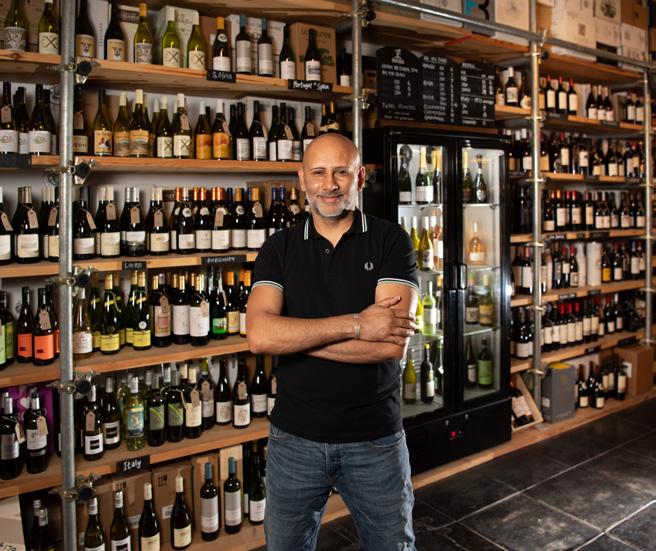
It was becoming clear that the online and delivery model would involve heavy financial investment as well as additional hoursRiaz at the former Stonewines shop in Whetstone, Barnet
assessed in every respect.
A few months later, parents involved in fundraising at their children’s school wanted to host an event in the school hall. They would sell places at £10 a head in the hope that 20 tickets would cover their costs. They sold 110 on the hottest day of the year. We’ve since become pretty popular with the local schools, and I have now refined the model; if they have charitable status, we’ll offer wines at discounted prices. For private company events, we give them the option to run a bar and sell wine by the glass, or sell bottles to take home.
The trend for private tastings has continued, although I am ever aware that another pandemic would abruptly put an end to matters.
I followed up my customer’s advice to sell, and there were two critical factors in making the decision. To continue with the shop, I would need to invest, with no guarantee of success. The second factor was ultimately the most critical: running private wine tastings gave me an alternative that would keep me close to the subject that brought me here in the first place, a love of wine.
Icompleted the sale of the premises this summer. We sold half the stock to the new owners, moved the other half into storage and, with the
excess bits of scaffolding, built portable shelving units at our storage facility. I kept a few tables and chairs, invested in WSET glasses, and will re-visit WSET accreditation. The shop was registered as a training provider, but for the moment I am minded to keep things simple. We’ve spoken to our key suppliers to keep our accounts open and a couple of these companies have offered to provide samples if we do partnership events with them.
Stonewines will now operate as a private wine tasting and events business. I have enough events in the calendar for the next quarter and will push a marketing plan for December. The Stonewines name and social media accounts remain with me.
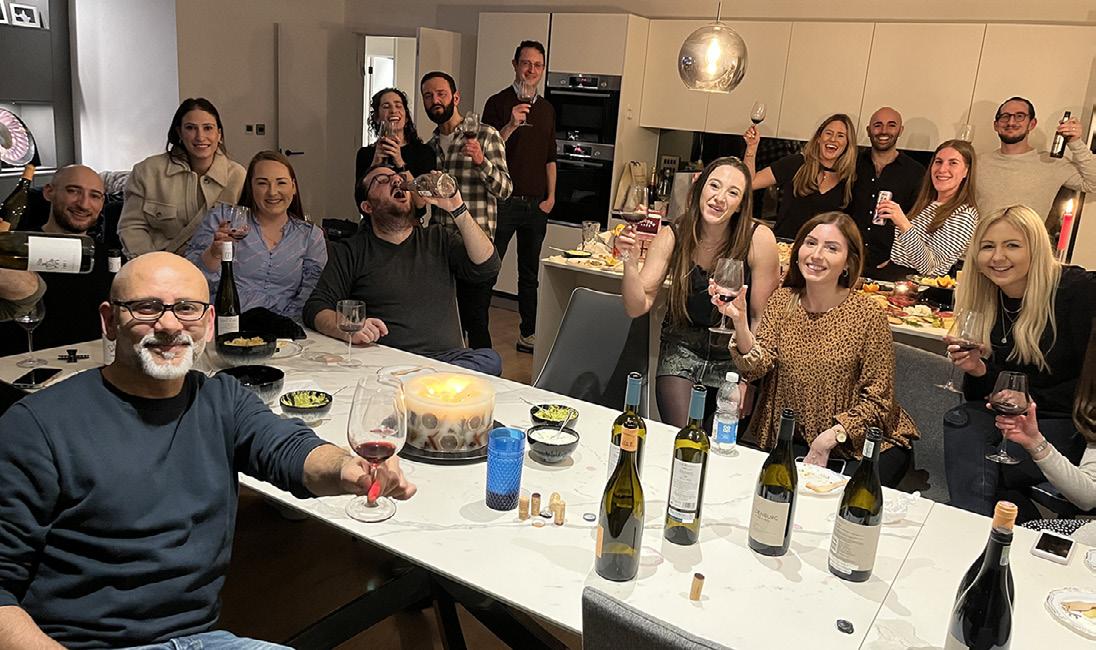
Most of the current bookings have been through word of mouth, but the biggest challenge will be to develop a method to ensure future business comes in.
This could be tricky without a visible high street presence. I am resolved to redesign the website and to post more frequent social media updates. I’ll use Instagram to post details of the wines tasted at each event because most members of the public who attend a wine tasting don’t remember anything beyond the first half hour. But they do remember having a great time – and that has to be what this is all about.
The trend for private tastings has continued, although I am ever aware that another pandemic would abruptly put an end to mattersRiaz holds court at a private tasting for a group of customers

It’s now 100 years since biodynamics was developed by Rudolf Steiner, and the debate continues over whether the methods he proposed are genuinely tapping into cosmic forces, or simply encourage a more natural approach that benefits vines in less mystical ways.



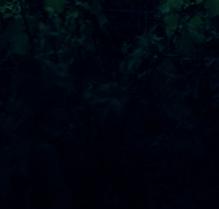



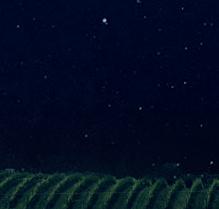


Overleaf, two independent merchants explain how they came to buy into at least some aspects of biodynamics, and how they believe it influences the wine in the glass.




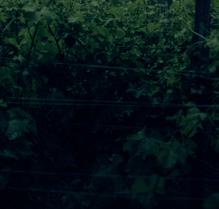

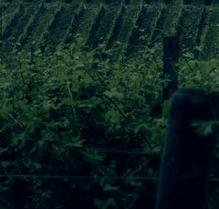


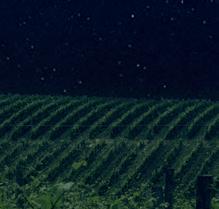




more information

“Iwas the worst in my year at science,” Duncan Murray admits. “I thought the teacher was putting kisses on all my work.”
Even when studying for his WSET Diploma 25 years ago, Murray says he still struggled to get his head around the technical aspects of wine production. He found it only really fell into place when he had a spell working for a producer in the Languedoc, where his daily life exposed him to the procedures and processes that transform grapes in a field to wine in a bottle.
So when did he start believing that biodynamics might have a part to play?
“I think it must have been about 15 years ago,” he says. “I’d taken a wine from the guy I used to work for in the Languedoc. In a tasting on the Wednesday, it was climbing out the glass – it was just absolutely fab. We then did another tasting with the wine on the Friday and it was so boring.
“So I rang Rob and said, ‘what’s all this about?’ and he said, ‘that’ll be the biodynamics’. So we checked the calendar and we found one day was a fruit day and the other one was a leaf day.”
Murray was sceptical at first – “I thought, what a load of bollocks” – but he did some reading and invested in a biodynamic calendar. Originally this was a book, When Wine Tastes Best, but it’s now an app.
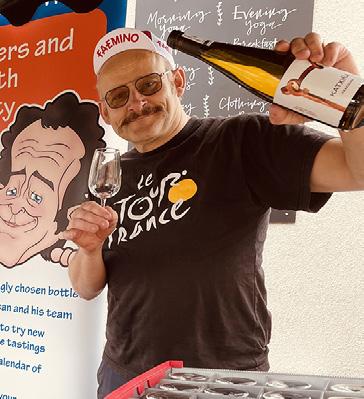
“I’ve had it ever since. I’ve used it at home, planting garlic, and if I pick apples on a fruit day they seem to last longer. It doesn’t seem to be scientifically proven, but it’s definitely worked for us.”
To add to the mystery, Murray has found that wines with more bottle age tend to taste better on leaf or root days than on fruit or flower days.
“We had a foudre-aged Albariño from Spain: on a fruit and flower day it just did not fire at all,” he says. “It was almost unpalatable. But then if you had it on a leaf or a root day, one of the ‘avoid’ days, it was

absolutely stunning. It feels like magic.” (On the subject of magic, Murray says he does not read horoscopes, but sees benefits to alternative therapies such as reiki and Indian head massage.)
Explaining optimal drinking times to consumers can be a complicated business.
“We get Thymiopoulos biodynamic Xinomavro from Eclectic Wines, which we know goes superbly with curry. If somebody’s coming in and wanting a wine to go with curry, we actually ask them what day they’re having it. We know the wine is never nasty. It’s just there are some days where it’s not as exciting as it could be.
“If it’s a root day on the Friday, and that’s when they’re having the curry, we say, ‘you couldn’t have it on Saturday, could you?’, because we know that this wine will be even better. They look at us like we’re nuts. But if they try the wine on both days, they go, ‘oh god – you were right’.”
In fact, Murray thinks more consumers are now open to the idea of biodynamics, perhaps because environmental issues have become more mainstream.
“There are fewer people raising their eyebrows,” he says. “When I used to bring it up at an event five or 10 years ago, the shouts of ‘bollocks!’ were huge. But these days there are more people who are in tune with it. More people seem to be open to the information and then going away and actually looking into it a bit.”
Despite this progress, Murray does not feel the need to restrict his range purely to biodynamic wines.
He explains: “We haven’t gone looking for them because it can put some people off: ‘What do you mean, I can’t drink this until the weekend?’.
“If a supplier says, ‘this wine is vegan and it’s also biodynamic’, and we like it, then brilliant. l have an extra reason to buy it.”
‘There are days when the wine is not as exciting as it could be’
Nobody could accuse Michele Longari of failing to approach his work in a systematic way. A decade ago he was working as a computer engineer in his native Emilia-Romagna. Since then he’s attained the Professional Sommelier Diploma and completed a master’s degree in wine business management. He’s no stranger to academia.

He’s a been a fan of biodynamic wines for some time, and there are now around 65 in Hay Wines’ 900-strong portfolio.
“Back when I was in Italy, I started to discover that the vast majority of the wines I was passionate about were actually minimal-intervention wines," he says.
“I wanted to understand something more about them and why I liked them so much. And this is how I came into contact with biodynamics, because obviously many natural and minimal-intervention wines are also biodynamic wines.”
But is there anything scientific about biodynamics, or is it more a kind of faith system?
“My personal opinion is that if you approach biodynamics from a scientific point of view, exactly as we do with all other wines, you are going to fail,” he says. “Because there is no way to make sense of biodynamics from a scientific point of view.
“In my experience, most times I am in front of a biodynamic wine, I know that, for some reason, I find very good quality. Wines that, in terms of aromas and flavours, probably have much more intensity.”
Longari argues that most of what happens with organic agriculture has a scientific justification.
“But I would say that 80% of biodynamics has nothing to do with science,” he says.
“Maybe 20% of biodynamics can be explained by science: for instance, the focus on soil. As we know nowadays, it’s very important to preserve and protect the microbiology of the soil, because we end up having grapes that are much richer in aromatic compounds.
“Biodynamic farmers are preserving the soil and even making it slightly better than
it was the previous year. So this is the only part of biodynamics that can be explained by science.
“For the rest, I think it’s just an agricultural system that is basically focusing on the vineyard as a living organism that’s able to protect itself from disease.
“They also believe that there are cosmic forces that have something to do with this and that you need to bottle the wine on specific days. They use a technique to dynamise different compounds in a vortex. So there are many things that are very unconventional and cannot be explained by science.”

Longari says he’s often asked how, as a wine professional, he can have belief in a system that has little or no scientific basis.
“My answer is always the same,” he says. “My job is not to focus on the agricultural method and why it works. My job is to make sure that all the wines we have in our portfolio are wines with a unique sense of place, and character and an identity. That’s it. And biodynamic wines, the vast majority of times, are always able to tick all the boxes that we look for when we want to add a specific wine to our portfolio.
“My job is just to make sure that we have very exciting wines. Wines that are able to express the terroir. My job is not to explain scientifically why wine was made in a specific way.”
Longari doesn’t use the biodynamic calendar in his work, not because he doesn’t believe in it (he admits he’s never really put it to the test) but because it seems impractical.
“If next month I need to go to France, Italy or Spain to meet my suppliers, I need to make sure that I can organise a trip for when I am available and when they are available,” he says. “If I have another variable – the biodynamic calendar – then it makes everything very complicated.
“Also the biodynamic calendar is something that could create distance between the consumer and biodynamic wine. I don’t want to over-complicate things by saying, ‘OK, you can buy this wine, but make sure that you taste it on this specific day’.”
michele longari, purchasing director, hay WINES, ledbury
‘Biodynamic grapes are much richer in aromatic compounds’
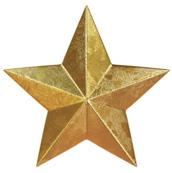



Fortified wines are at the heart of the Setúbal peninsula. Indeed the Setúbal PDO, dating back to 1907, only allows fortified styles. The majority of wines are made with Moscatel de Setúbal, the local variant of Muscat of Alexandria. After maceration on skins for at least six months, the fermentation is stopped with the addition of brandy and the wine then ages for at least 18 months in the barrel. The wines are typically very fresh and fruity but they gain complexity with ageing and can have a role in food matching. But in the region itself – and in nearby Lisbon, where the style has a strong following – the tradition is to enjoy Moscatel de Setúbal as an aperitif or dessert wine.
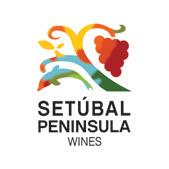
Sociedade Vinícola de Palmela
Moscatel de Setúbal 2020
Raymond Reynolds RRP: £16.99
It’s hard to imagine anyone taking a first sip of this wine and not breaking into a smile. Even people who claim not to enjoy sweet or fortified wines will find something to love here, deep inside its summer garden aromas and marmalade and dried fruit depths. But just as important as any of these elements is the brisk citruslike acidity that keeps the wine bright and fresh – and very drinkable. An excellent introduction to the Moscatel de Setúbal style, with lovely intensity and perfect balance.
José Maria da Fonseca Moscatel de Setúbal 2019

Marta Vine RRP: £18.50
Some careful oak ageing adds a certain softening and aeration to Moscatel de Setúbal wines, and in this case it seems to amplify the apricot, orange and hazelnut characters. It’s quite a mouth-coating wine: full, rich and generous, but with the underpinning acidity that winemakers in the region always seem to master. There’s a gentle prickling sensation as the wine dances on the palate and some darker fruit flavours that emerge on the long finish. An awful lot to enjoy here in a wine costing less than £20.
Raymond Reynolds RRP: £27
The secret to this wine is the combination of vineyards making up the blend. Those on clay soils contribute freshness, while the vines growing on the sandy plains provide the sweetness. The wine ages in oak for seven years and it’s worth the wait –the richness is apparent even in the way the liquid pours from the bottle. A luxurious style of Moscatel de Setúbal, with some aromas of antique furniture and flavours of figs, dried fruit and oranges, with a satisfying pithy note on the finish.
There’s no doubt that some Moscatel de Setúbal wines are simple, zippy and fresh, designed to be enjoyed as aperitifs. Here we’re at the other end of the spectrum, with an intense style that no doubt works for some people as a pre-meal treat but seems more obviously suited to an after-dinner occasion. It’s a wine that demands slow sipping and a degree of contemplation while its flavours of buttery caramel, oranges, nuts and spices twist and turn in the glass. The price tag reflects the quality, but represents good value by comparison to its fortfied peer group from other regions.
Achaval Ferrer was founded in Mendoza in 1995, specialising in terroir-specific wines, often from ancient ungrafted vineyards. Its 1999 Finca Altamira was Decanter’s first-ever five-star wine from Argentina


“We began working with Achaval Ferrer in April 2023, so we’re just at the beginning of our exciting partnership. Their wines prove that while Malbec is reliably delicious, it can also be wildly exciting.”
Maggie Macpherson, group buyer, Jeroboams
We were lucky enough to already work with the team at AchavalFerrer through their secondary brand, Melipal. Achaval Ferrer are arguably one of the icon producers of Argentina so strengthening our relationship was a no-brainer.
What I love about the wines is their ability to express the distinct terroir of the specific sites they work with. We recently launched the 2019 Fincas and each display their own identity, despite all winemaking remaining the same, making it a really fun tasting for people to choose their favourite terroir. I love their energetic style of Malbec with a rapier line of acidity, making the wines fantastic for food matching – try the 2021 Achaval Malbec with black cod to challenge the Malbec-and-steak classic.
We’re also really excited to introduce customers to the rest of their range including the most delicious Cabernet Franc, which has already become a firm favourite amongst the Jeroboams team.
“Our philosophy of limited yields in the vineyard – and therefore of limited overall production – ensures maturity in the wines and a perfect expression of each of our terroirs in the various areas of Mendoza.”
 Gustavo Rearte, winemaker
Gustavo Rearte, winemaker
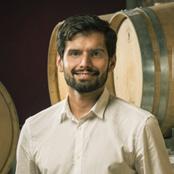
We are very precise with our decision of when to start the harvest and get winemaking underway. It could be described as more of an oldworld way of working, and it’s this philosophy that makes it easier to express the terroir.
We aim for wines with varietal character, focusing on the freshness and intensity of each of the grapes we work with. We want to conserve the aromas and primary flavours that we find during harvest right the way through the winemaking process. The fermentation processes and barrel ageing add even more complexity, but we’re also looking for finesse. Our Fincas wines epitomise this ambition.
When we experiment and create blends, as we are doing with Quimera, we think of the wines as a very solid expression of soil, vineyard and sky. This process opens up new ways of sharing what we enjoy doing, adding greater complexity to the wines and creating a new chapter for our story.

During the summer we have a contract with a cruise ship to supply wine. It isn’t one of the 4,000-passenger behemoths that tower over our ferries and creel boats, but a small wood-decked vessel that takes 20 big spenders on tours of Scottish islands. Good food and drink are important, and everyone gets to sit at the captain’s table every night, because there’s only one table.
After handing a dozen cases over the gunwale, I was returning to my van when I saw a buldery face hoving into view over the far edge of the pier, followed by a pair of broad shoulders, as Flipper Bichan heaved himself up the ladder.
It turned out he’d just returned in his charter boat with a party of divers who’d been exploring some of the wrecks that lie just offshore. One had got bored looking
at the rusty hulls and started collecting scallops. Despite previously being a professional scallop diver himself, Flipper hates seafood. It was a wage for him, not a delicacy. So he was happy to get rid of the dozen huge scallops the diver had picked up – by giving them to me. I offered to pay but he was having none of it. I’ll give him a bottle of hearty red the next time he’s in the shop. He’s a steak and Malbec man. Happily, we’ve been doing an Albariño promo in the shop this weekend, and I had an opened but nearly full bottle to take home to accompany the scallops, fried in butter with a touch of garlic. None of your chorizo or black pudding! They’re far too assertive, and distract from the subtle flavours of the shellfish. If you need a crunch, toast some hazelnuts and sprinkle them on top.
Last week there was a knock on the house door at 10 o’clock one night. It was a neighbour from a couple of fields away. He was grinning broadly and holding up a bulging carrier bag of something darkly-shimmering. “I’ve been out under the Hoy cliffs,” he said. “The mackerel were swarming like midgies. I hardly dropped the line into the water before I was hauling it out again.”
He wouldn’t take anything in exchange. I made a mental note to set aside a bottle of dark rum for him, and went inside to fry a couple of fish in oatmeal. If you’ve never had mackerel straight out of the sea you haven’t lived. Freshly caught and quickly cooked, these are as good as any halibut or turbot. Food of the sea gods.

Last winter I was hosting a wine dinner at a local hotel. They’re a popular feature of the dark months when the tourists have long gone and the locals need a bit of light and luxury in the shape of a tasting menu, matching wines, and a spiel from me.
I’d just sat down after introducing the venison and Pic St Loup when my phone buzzed. A text: “I’ve dropped your order off. No one home, so I just put it in the door.”
It was from a friend who lives with her husband on a tiny rocky island to the east of Orkney. Just the two of them. And several hundred rare-breed, seaweed-eating sheep. At some point I must have said I’d take some meat from her. It’s a rare treat, the strong mutton flavour leavened by a salty tang. If it were a wine, we’d say it had minerality.
I knew I had a stash of freezer bags at home ready for just such an eventuality. What I didn’t know till I got home at the end of the dinner was that the lamb was whole and unbutchered. I hefted it onto the kitchen table, poured a large dram, and got to work.
Now I was in barter debt. Half a dozen bottles of decent claret should do the trick. Financially it was fair, though pulling half a dozen corks over the next month would be a lot less labour than carving up a carcase at midnight.
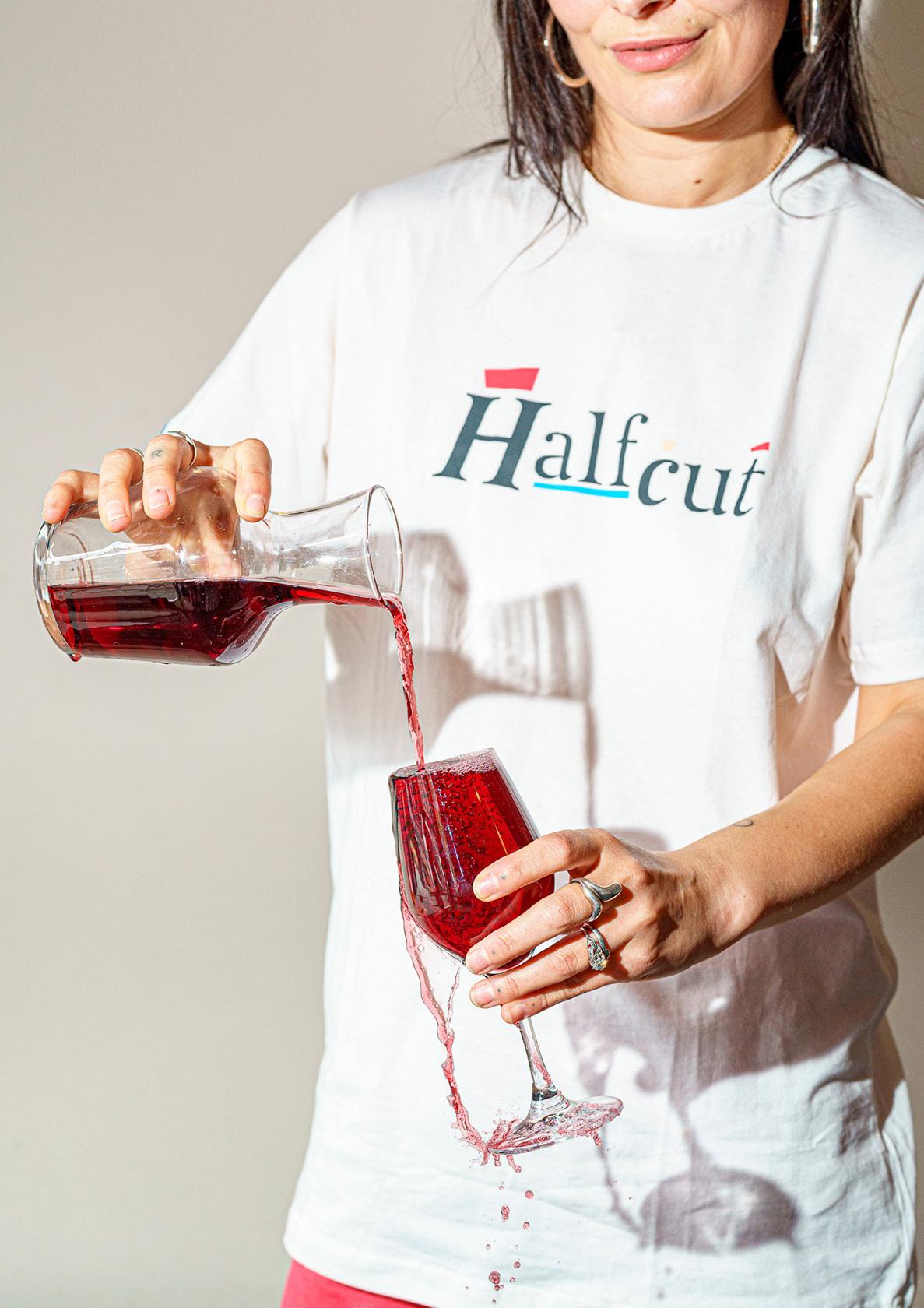
If Half Cut Market’s T-shirt design looks vaguely familiar, it’s because the design is a “loving homage to the first wine shop I ever used,” according to Danny Eilenberg from the north London wine merchant and deli.
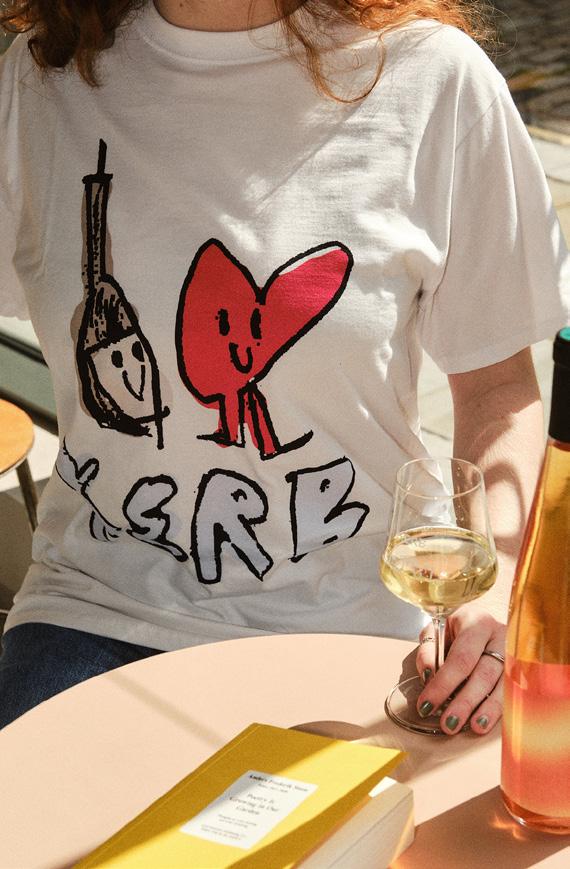
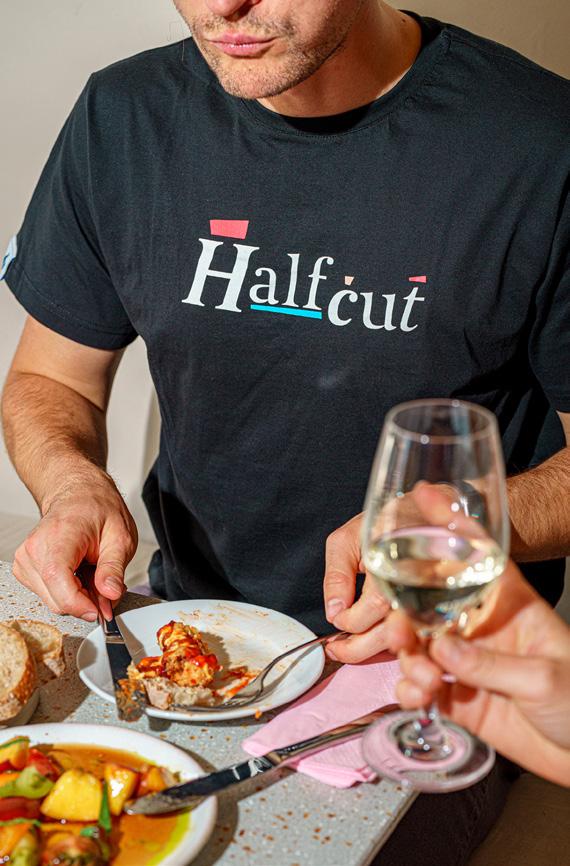
Produced in partnership with a London-based organisation called Thumbprint, the T-shirts are hand-made in Mumbai by young women who are not only paid a fair wage for their labour but are also taught to read and write.
Thumbprint says that 12 million girls in India do not go to school and many millions of women are unemployed, so projects like this help them become educated and empowered.
Danny says: “The collaboration came about after Ed Francis, who runs Thumbprint, reached out to us after seeing me post a mock-up of the T-shirt I’d been designing online. I’d crossed paths with Ed before – he’s a well-known hospitality brand consultant and we have friends in common – but this is our first time working together.”
The 160gsm T-shirts, priced £35, are made with organic cotton and screen printed in four colours. Half Cut has been inviting pre-orders to help eliminate waste and was expecting to ship the first consignment at the end of August.
KERB, the natural wine bar and shop in Ancoats, Manchester, has built a loyal following for its merchandise. Manager Fiona Boulton says the original black and white range was designed by local agency Studio eNaR, working from illustrations by artist James Carbutt.
“Since then we’ve done seasonal merch designed by local artist Tomas Gittins. He also does weekend shifts at KERB – but less so these days now his art has taken off. He’s incredible and will do great things, I think.
“We give him free rein over what he makes for us. We’ve had scarfs for winter, caps, tees and hand spray-painted tote bags.”
Two T-shirts are currently available on the KERB website, each priced £35.
“They’re super popular. Tom’s ones are always limited-edition and sell out seasonally. It isn’t policy for staff to wear them, but most of us do because we just like them!”
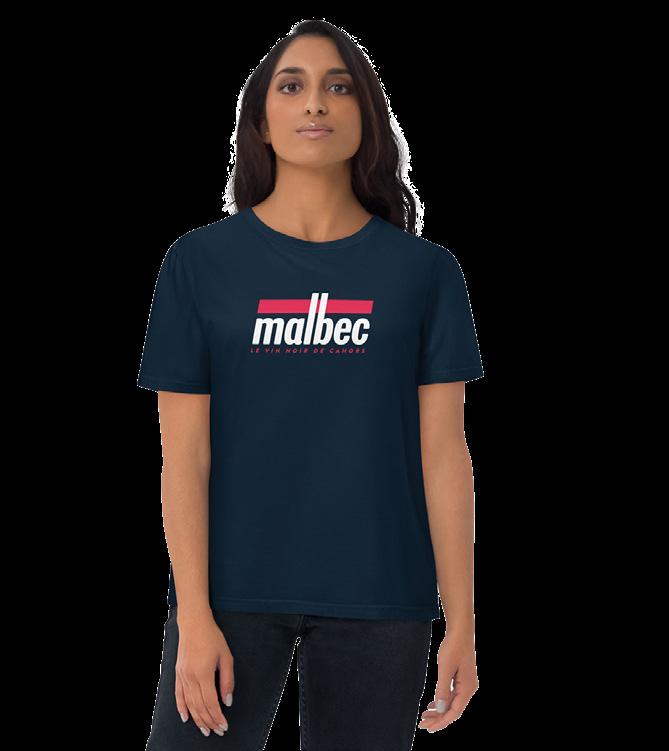

Bintwo, the Padstow wine merchant, has been “dipping its toe” into the world of merch, according to owner Mike Boyne, starting with a £20 cotton T-shirt with the company logo on the front and a quote from Hemingway on the back: “My only regret in life is that I did not drink more wine.”


Two designs are available. “We haven’t sold any yet, but I like wearing them so that’s fine,” says Boyne. “They’re printed to order so at least I’m not sat on stock and don’t have that problem of not knowing how many of which size to order.”
He has also commissioned some T-shirts that relate to his wine brand, Howl & Grappa.
“The newest additions are our ‘variety’ designs, Malbec and Chardonnay. The idea came through a chat with a designer friend, Matt Durston, who does all of my design and branding work. We thought that there really aren’t many wine T-shirts out there that look stylish rather than being in some way comedic. So we’ve played around with retro 70s-type designs loosely based around some of the old motor racing brands.”

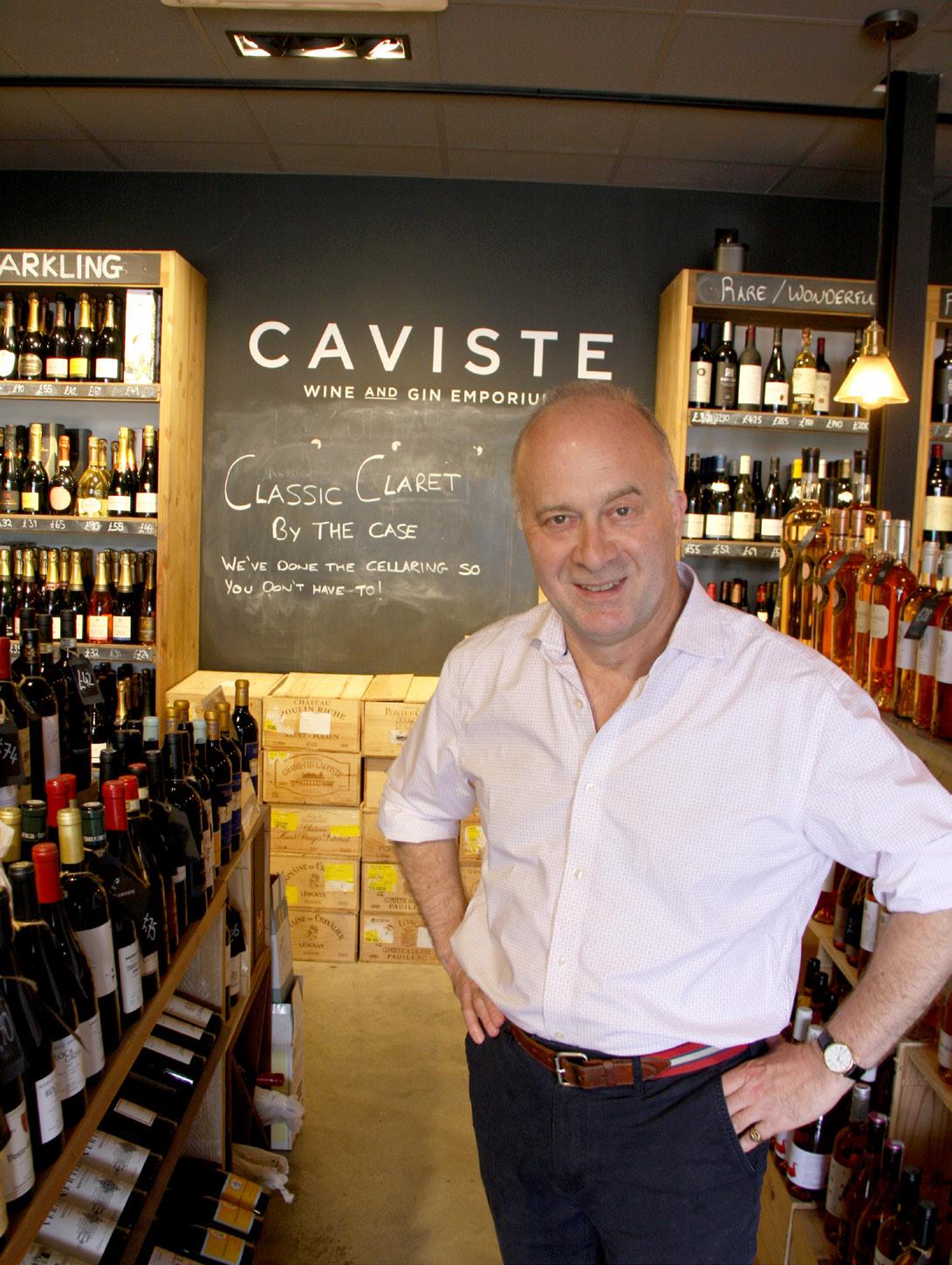
These days, Caviste is thriving in a rural farm shop location, but it hasn’t always been this way. Originally known as The Cellar Door and based in a village 16 miles away, where it retains a satellite branch, the business has changed ownership along the way and created a separate spirits division
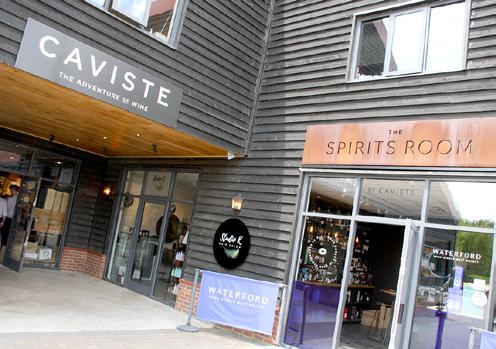 By Nigel Huddleston
By Nigel Huddleston
Wine shops can be found in any number of locations. Town squares, village greens, malls, suburban high streets and indoor markets all provide homes for them. The flagship store of Hampshire’s Caviste is a little bit different: a barn-like, built-to-spec structure that’s part of the Newlyns Farm Shop & Café complex, just off junction five of the M3.
“We’re one minute from the M3, we’re within an hour’s drive of London and there’s a lot of traffic that goes from London to the south coast or the west country almost past the door,” says managing director Mark Bedford.
“Customers know they can park their car, which is a massive thing.”
Caviste started out life as The Cellar Door, founded by David Thomas in the village of Overton on the opposite side of Basingstoke in 2003.
Bedford, an ex-soldier and teacher, cut his teeth in the wine trade at Berry Bros & Rudd’s Basingstoke shop, before teaming up with Thomas in 2004.
When Thomas later left the business, the importer Carte Blanche became the main shareholder, with Bedford holding a minority stake. There was an amicable parting of the ways with Carte Blanche in 2016, at which point Bedford became the majority shareholder.
“It was amicable because they were doing importing and wholesale and I was retail and private customers,” he says.
“There was tension in trying to do everything as one company. There’s pressure only to retail the wines you’re importing rather than have a
wonderful spread from across the independent wine trade.”
Along the way, Caviste had started to operate a concession in the Newlyns farm shop. When the family who operate the shop decided to expand, Bedford seized on the opportunity to have a standalone Caviste store, adjacent to the main farm shop building. It opened in August 2018.
“There was a risk involved,” says Bedford. “Quite a few people said I was doing a stupid thing, but it’s worked. Our sales have more than doubled since we moved the few yards from there to here.
“I think there some people thought we were part of the main farm shop rather than a stand-alone business. Now, people can see we’re a proper business in our own right.”
The original Overton shop is still going but on reduced hours and Newlyns has become the flagship.
“Some people thought we were part of the main farm shop rather than a standalone business. Now they can see we’re a proper business in our own right”
Bedford’s wife, Susanna, is a former chef and catering company entrepreneur who handles company admin and cooks for Caviste’s extensive programme of events, oriented around food and wine matching, which take place in a large space above the Newlyns store.
“Initially the idea was for the store only to be one floor but when they added a second I said I’ll take it,” says Bedford. “I’m so glad I did as well. We hire it out as a corporate meeting space as well as using it for our own events.”
Caviste has more recently taken over a smaller unit next door at Newlyns which has become a separate brand called The Spirits Room, fronted by manager Will Blakeley.
Why was it attractive to have a separate spirits shop rather than just put more focus on spirits in the main space?
Like most wine merchants, we had a spirits section: a little corner and that was it. Some people thought that was fine, but people who like spirits found it frustrating that there wasn’t more, so the idea of creating a stand-alone brand appealed. The decision has been vindicated. We built a separate Spirits Room website last year and I don’t regret either decision for a moment.
Our biggest corporate customer came to us through that website. It was worth building it just for that one customer. With the wine shop, our sales are probably 60% in-store, 40% mail order. With spirits, it’s probably already the other way round. Yes, we’re tiny compared to Master of Malt and The Whisky Exchange, but the people searching don’t know that. The Spirits Room could be a global enterprise for all they know.
What makes the bricks and mortar element work?
Will Blakeley: We’re very well-supported by suppliers for tastings. It’s a way of getting people in touch with producers. We’re the middleman between producer and consumer. If you can shorten that gap to absolutely nothing …
It’s also a great way of removing conceptual barriers that people have about single malts versus blends and things like that.
Companies like [Irish whiskey producer] Waterford are keen to do tastings and get a bit of brand-name recognition because they’re still a relatively young distillery and trying to build a
“ We are focused on retail. Wholesale is no more than 5% of turnover. I’m not very good at knocking on pub doors”

reputation. The way you achieve that in whisky is, quite literally, to get it on people’s lips and have a chance to talk to customers.
Do you see the shop as a specialist in any particular spirit?
Will Blakeley: We’re a bit of an all-rounder but whisky is my personal passion. Our area of huge growth is rum. There’s a lot of crossover with whisky drinkers getting into rum. The value to be had in rum is insane: a 15-year-old rum is £60, whereas a 15-year-old whisky these days will set you back £75. There’s just as much complexity in a decent Caribbean rum as in a single malt whisky. But within whisky there’s so much excitement: Japanese, English, Irish, Scotch, New Zealand, Australian. We do some amazing work with a producer in Finland, Kyrö, who are absolutely astounding. The spirits word is an exciting place to be.
Mark Bedford: All the gin here is made by whisky distilleries: Isle of Raasay makes whisky; Isle of Harris are still maturing their whisky and haven’t started selling it; Cardrona from New Zealand’s South Island makes a gin aged in Felton Road casks. That’s probably the most sophisticated gin in the business and is about 70 quid. That’s a gin that will be enjoyed by drinkers of other spirits, who can be a bit rude about gin. A gin’s a gin: you can distil it
on Tuesday, bottle it on Wednesday and sell it on Thursday, which is why whisky distilleries have fallen in love with it. It’s wonderful for cash flow.
Since the parting with Carte Blanche, has wholesale played any part for you at all?
Mark Bedford: We are focused on retail. Wholesale is no more than 5% of turnover. We supply a number of smarter pubs and have a little wine selection in a village shop. It’s partly because I’m not very good at knocking on pub doors. I did hire someone who’d worked in pubs four or five years ago to do just that, and it was quite clear after three or four months that it was not going to work.
Without wanting to sound pompous, our wines are too good for that sort of market. They can buy a Châteauneuf-du-Pape for £10 a bottle and we’re trying to sell them it for £16. It doesn’t have to be that good, as far as they’re concerned; it’s just got to be good enough. At the bottom end they want to buy Sauvignon, Merlot and Viognier at a price I’d be embarrassed to sell those wines for on our shelves. We’d have to buy in wine especially for the pub market. I can’t do that: I’d rather sell nice wine to nice people.
Who are your main suppliers?
Vindependents has become our number one supplier, then the main ones would be Berkmann, Boutinot, Thorman Hunt and Armit. Rather than buying one wine from Berkmann or Thorman Hunt, or whoever, I’d rather embrace a producer and have a range from them.
We get a chunk of our faster-moving, lower-cost wines from Boutinot, but we get some great quality wines from them as well. Rimauresq is a Provence rosé that we sell a lot of. We don’t order many wines from Armit, but we have three wines from a Sardinian producer called Agri Punica. Its Montessu has been our bestselling Italian £20 red for the last three or four years.
We do our own importing as well. We are the sole importer of Skipskop from South Africa, Rusden in Australia and Quinta de Sant’Ana from Portugal.
That’s quite a geographic spread. How has that been in the last couple of years with the issues around global shipping?
Shipping is more expensive and from Europe it is slower. In order to mitigate costs we ship two pallets instead of one. The disadvantage of that is
cash flow because you end up with eight months’ worth of stock rather than four, and you’ve generally paid for it before you’ve sold it.
But you’ve not been discouraged from doing it? No, not at all. I get disheartened when I read about people wanting the end of Brexit. Just work with it. The rules have changed, things are slower, but I believe in staying positive whatever the set of rules. We want to buy nice wine and our customers want to drink it. And it’s up to us to get it here as efficiently as possible under the rules around us.
It’s much easier than in other countries. We could be in Sweden or Canada where there are trade monopolies, or countries where they’re not
The Spirits Room is now a separate brand within the Caviste business, with its own website, but the bricks-and-mortar element remains central
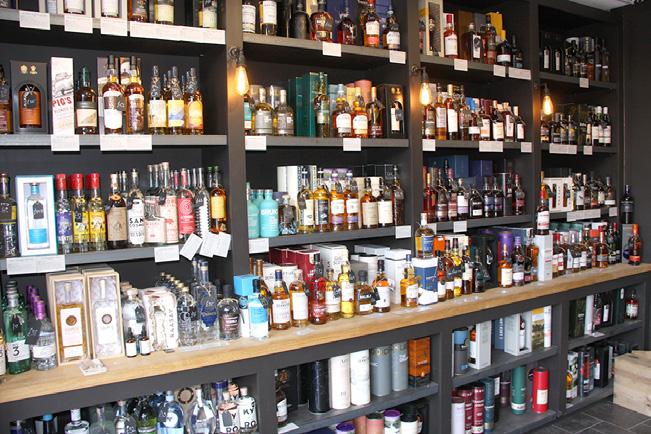
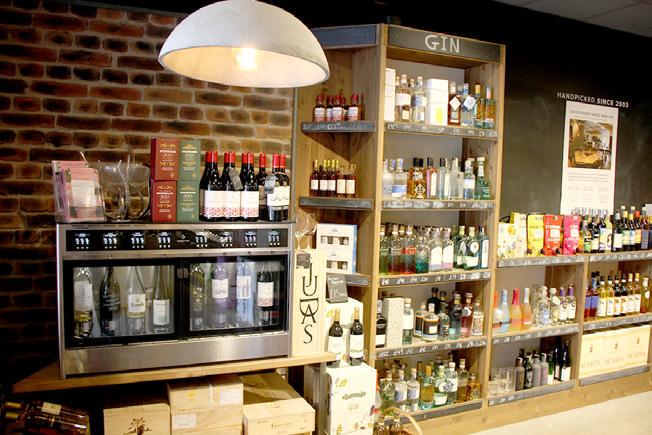
“The rules have changed since Brexit, things are slower, but I believe in staying positive whatever the set of rules”
allowed alcohol at all. In the US, you’ve got the three-tier system. It would be unthinkable for us to import direct there. We can, and I think that’s something to celebrate, rather than moan about the post-Brexit regulations. It’s better now than it was a year ago. We’re working out ways.
You think people are getting used to the new landscape?
Shippers make their money out of shipping and, more than anything, they have learnt to do the administration. The bigger negative has really been the regulations on sending alcohol from the UK to the EU. We do quite a lot of exports of corporate gifts around Europe. Pre-Brexit you could pretty much put a postage stamp on it and it would get there within two or three working days. Now you’ve got to fill in Customs documents for every delivery and that is something I don’t celebrate.
What makes a producer stand out for you? Obviously the quality of wine at the right price
is everything and it helps if you like them as a producer and as people. If you look around the shop you’ll see families of wines rather than individual wines. There are exceptions, like Whispering Angel, which I’m not proud about, but there are people who just want to buy Whispering Angel. So we sell it, otherwise someone would burn the shop down.
What are your areas of specialism?
Australia and Portugal. Our average price for Australia is probably double or triple the national average for wines from there.
We used to be exclusive on Yarra Yering. Berkmann now import it, but we’re still the main UK retailer. With Moorooduc, we’re the only wine merchant that sells the entire range, which we buy through Vindependents. We probably take in 50% of all that comes into the UK of that. The McIntyre family who make it regard Caviste as their main hub in the UK.

The independent trade has a lot of love for
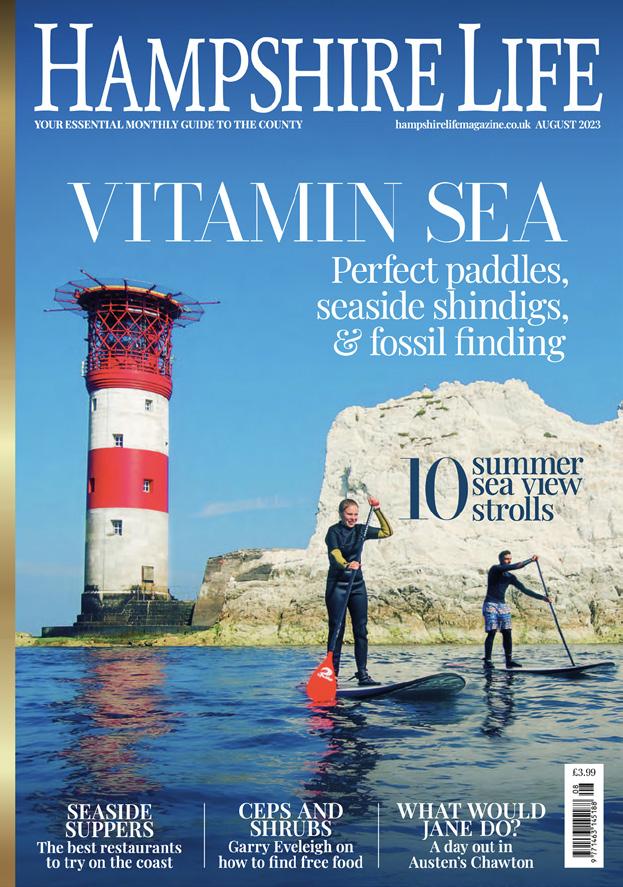
“The Overton store is about 40% of the floor space that we have here. That’s only open WednesdaySaturday now, but we sell the same amount of wine as before”Mark Bedford writes a monthly wine column for Hampshire Life in exchange for a fullpage ad
Portgual but Australia is perhaps not quite so in vogue. Why is it a focus for you?
Going back to the start, the founder’s previous job had been making wine in Australia and we were exclusive importers for a wide range of South Australian producers. Now we only ship one and that’s indicative of the fashion not to drink alcoholic blockbusters. We do more producers from Victoria now than we do from South Australia.
I’ve been to Australia a couple of times, initially in 2010 as part a delegation with Wine Australia. Moorooduc was an interesting one. I first visited them on my one day off from the trip in 2010.
I wanted to go to Mornington Peninsula which wasn’t on the itinerary. I popped in and was utterly charmed by it. I offered to become the exclusive importer after a second visit in 2017. They decided to go with Vindependents to get immediate broader representation in the UK. So, Moorooduc was the reason I joined Vindependents. We take three pallets a year.
What role does the original store play now that you have this?
This is the main store. Overton is about 40% of the floor space that we have here. That’s only open Wednesday-Saturday now, rather than MondaySaturday. We’re reduced our costs there but we sell the same amount of wine as before. At Newlyns we’ve increased our costs, in terms of staff, mainly, but it’s been justified by the sales growth.
You’ve doubled turnover at Newlyns since you were just a concession in the farm shop. Is that down to anything in particular that you’ve done or just organic growth from the expansion?
We haven’t done much in the way of proactive marketing. It’s been events, social media … we do Google ads. I write an article for Hampshire Life. That’s probably been our most expensive bit of marketing. The deal with them is we do all their food and wine matching and a wine page, and we get a full-page ad in return.
It’s probably time to do an old-fashioned postal leaflet thing, because a lot of our customers are not Instagram or Facebook users.
Is that a polite way of saying older?
Yes, but not super-old.
You have a wine club, Club Caviste. Does that do

customers are not Instagram or Facebook users”
Turnover has doubled at Newlyns since the expansion
well for you?
It’s a ticker. I wouldn’t say we’re driving it, but it has subscribers. We get people who just don’t want to bother choosing wine. They pay by direct debit every month and we’ll send them a mixed case of wine. It’s something we could drive more than we do.
It seems events are more of a driver.
We have this wonderful space upstairs. If I wasn’t running a wine merchant I’d probably be running a restaurant. I love to see people having a wonderful time and we do our events wonderfully well. And Susanna is a wonderful chef.
“It’s probably time to do an old-fashioned postal leaflet thing, because a lot of our
The process that has been described as the “enshittification” of the internet presents an interesting challenge to the businesses who’ve come to rely on platforms like Amazon, Google and the social media networks. David Williams explains why

Have you noticed how the internet seems to be getting worse by the zeptosecond?
Worse as in less relevant, useful, and satisfying, and more spam-ridden, superficial, and stressful?
Worse as in feeling more and more that the experience of being online is like being trapped in some endlessly looping digital recreation of what comes through our real-life post boxes: a deluge of irrelevant, unsolicited junk mail and political flyers interspersed with sudden stern demands from the taxman, local government and energy suppliers and occasional wellwishing words from close friends and relatives?
Well, you’re not alone. The feeling is widespread. It even has a name, coined by the Canadian-British technology writer and activist Cory Doctorow, who, over the past year, has written at length about what he calls the “enshittification” of the internet.
According to Doctorow, we are now at a moment of maximum enshittification, as each of the handful of monopolistic platforms (Amazon, Google, Meta, TikTok, Twitter/X) that between them dominate and mediate our online lives have fallen
prey to what he sees as an inevitable process with a fixed pattern.
“First, [platforms] are good to their users,” Doctorow explains. “Then they abuse their users to make things better for their business customers; finally, they abuse those business customers to claw back all the value for themselves. Then they die.”
The example of Amazon is perhaps the most clear-cut illustration of this process. As Doctorow says, “We always knew that Amazon didn’t care about its suppliers, but being an Amazon customer has historically been a great deal – lots of selection, low prices, and a generous returns policy.”
But even that has changed in recent
years. These days, as an excellent piece of reporting by the Washington Post’s Geoffrey Fowler showed last year, when you search for a product on Amazon the entire first page of results is composed of paid-for ads, which will often include one or two products made and distributed by Amazon itself.
It’s not until the second screen that what’s known as “organic” results – the products that are closest to satisfying your actual search – begin to emerge. By the third screen you’re back to a parade of ads and Amazon-made products.
Something very similar has happened on Google, where search is now less about giving users the most relevant and compelling results, and more about giving them a mix of paid-for third party ads and links to Google’s own sites, services, and products. Meanwhile, Facebook, Instagram and, most suddenly and dramatically of all, Elon Musk’s Twitter/X, are all well into the third of the three classic stages of enshittification, with users’ feeds only sporadically populated by content from the people or businesses they’ve actively chosen to follow, and instead filled with unwanted, paid-for content.
When you search for a product on Amazon the first page of results is composed of paidfor ads, often including products made and distributed by Amazon
This all adds up to an increasingly terrible experience for users, of course. But the point about enshittification is that it affects those who are trying to work with the system to sell or promote their businesses and products, too.
Whereas a brand, producer, or retailer might once have been able to rely on digital word of mouth to spread their messages and stories organically, today they are finding they have to allocate large parts of their marketing budgets to getting any traction at all. It’s not just that you need to pay for advertising in the traditional sense. You also need to employ specialists to try to game the platforms’ various algorithms, which are liable to change, without warning and apparently on a whim, from one moment to the next.
Given the rampant spread of enshittification, it’s not surprising to come across statistics telling a story of ever-diminishing interest from users. An analysis of more than 5 million social media posts and 9 billion comments and likes over the past three years by market researcher Rival IQ published earlier this summer, for example, presented a picture of rapidly dwindling or flatlining rates of engagement with content posted by businesses of all kinds across all platforms bar TikTok.
No wonder so many wine producers, retailers and brand owners I speak to are feeling increasingly disillusioned with social media, too. There’s a sense that a form of marketing that never came naturally to many has become too difficult, too expensive, to get right, and many are considering whether, in a sensical version of the Brexiter’s absurd “no deal” mantra, having no social media presence is better than having a bad one.
On the one hand, it’s hard to feel too sad about the passing, if that is indeed
what it is, of the first social media age. Certainly, when it comes to wine’s online presence, with its endlessly repeating, interchangeable vineyard snaps and bottle shots, its clunky recycling of website copy and its stilted winemaker videos, there wouldn’t be much to mourn if the whole concept of the internet were to retreat into Pandora’s Box.
At the same time, I can’t help feeling an opportunity has been missed here. One of the undeniably good things about the early days of social media was that sense of long-established barriers between wine producers and their consumers being broken down. For the consumer, there was the thrill of having first-hand access to the people who made the wines they loved. For the producer, there was the ability to talk to their customers directly, without having their message mediated by their importer, a copywriter or a journalist. And, in those
rough-and-ready, DIY, amateur times before the arrival of the professional influencer, all it cost them was a little time.
Those possibilities haven’t disappeared entirely, but enshittification has made them much harder to cultivate. That’s why so many wineries and wine businesses are focusing on a retro form of online communication that is currently enjoying a revival: the email newsletter.
The problem, as we all know from our own expanding inboxes, is that there is a limit to how many newsletters people are willing to subscribe to, let alone read. Besides, where, if they’re not using social media, is a business going to recruit its readers/customers in the first place? Well, maybe, just maybe, there is a radical solution here. Perhaps businesses could go back to looking for customers in that mythical place where we used to find all our human contacts. A place that we occasionally hear about online, and that these days goes by the initials IRL.
gluten-free credentials.
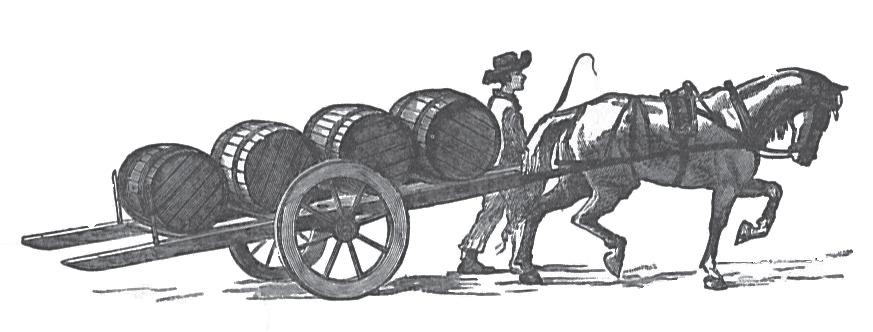
Media lore has it that in the 1930s sub-editors of The Times amused themselves with a regular competition to see who could create the dullest headline. To qualify, it had to appear above a genuine news story in the next day’s paper. Claud Cockburn – who, surprisingly, turns out to have nothing to do with the origins of the phrase “cloud cuckooland” – won on one occasion with “small earthquake in Chile, not many dead”.
Half a century later this was still being used to coach fledgling journalists into putting heft and substance into their stories and headlines, ensuring – as we would say in today’s vernacular – that they weren’t just “a bit meh”.

That learning was front of mind in approaching this month’s column, for which the theme is “gluten-free beers are just as good ‘normal’ ones”. It sounds like a conclusion barely worth taking the trouble to reach, like all those Dragon’s Den inventions that are dismissed by the investors because they solve a problem
that doesn’t exist.
I’d probably think the same if, in 2019, I hadn’t carried out a taste test for AN Other magazine to see how gluten-free versions of popular lager brands stacked up against their parent products.
In some cases, the results were startling, most notably for Peroni, where the glutenfree version had profound differences in colour, carbonation, hop character and sweetness – the last of these a distinct personality trait of the regular brew.
At the time, one brewer estimated that there were around 300 gluten-free beers on the market, but there was considerable trade and consumer distrust, both of product quality and unsupported claims about
There are two paths to making glutenfree or gluten-reduced beers: substituting the barley or wheat (in which gluten is found) for other cereals in which it isn’t, such as buckwheat, maize or rice; or using Brewers Clarex, a trademarked brewing enzyme intended for tackling chill haze in beer, but later discovered to break down the active constituents in gluten that cause Coeliac disease, a long-term condition where the immune system comes under attack, making it difficult for the body to absorb nutrients. Symptoms include bloating, diarrhoea, constipation, fatigue, nausea, rashes and osteoporosis, among others.
We can only really guess, but it seems like there are many more gluten-free beers these days – and more variety in styles and personality, bringing greater depth of choice.
Burnt Mill’s Beyond the Firs is a Citra and Centennial pale ale with a fresh, floral aroma, gentle bitter hops and a bright clean finish.
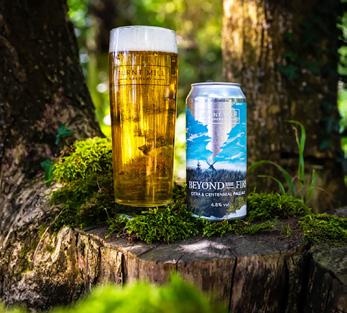
Brass Castle’s Bad Kitty is a vibrant vanilla porter, a little on the sweet side but with a tempering undertow of hop bitterness and a hit of the chocolate/cherry combination of a Black Forest gateau.

There’s even an impressive gluten-free approximation of a wheat beer in the form of Belgian brewer Mongozo’s organic and Fairtrade Buckwheat White, all tropical fruit and spices with a medicinal edge.
All this matters, of course, because hundreds of thousands of people are affected by Coeliac disease. The charity Coeliac UK says that it impacts around one in 100 people – almost 700,000 people based on today’s UK population – though only around a third of them have a formal diagnosis.
That’s a lot of people but, hopefully, thanks to good quality gluten-free brews,
Coeliac disease impacts around one in 100 people – almost 700,000 based on today’s UK population, though around a third don’t have a formal diagnosisBeyond the Firs has a fresh, floral aroma

We had a small lifestyle block of land on the edge of Blenheim which previously housed 100 pigs when we answered an advert in the local paper from Montana – now Brancott Estate, owned by Pernod Ricard– looking for contract grape growers. We planted Müller-Thurgau, which was what the wine company wanted for its bagin-box wines in the New Zealand market. There were no export markets in those days.
Marlborough started exporting wine in the mid to late 1980s with Sauvignon Blanc. After contract grape growing for a number of years, we wanted to take the quality from the vineyards through to a quality wine. We saw a wine market opportunity and changed our variety to Sauvignon Blanc, employed Kim Crawford as a consultant winemaker and began an amazing journey which has since grown with exports to over 70 world markets.
Marlborough has extremely diverse terroir with its many different soil types and climates at our disposal. It continues to expand into new areas and we continue to learn more about its terroir every year. We are on a steep learning curve and viticultural surprises are sure to continue, and we believe the best is yet to come.
As we have grown, we have listened, and have carried out many trials from our many small wine tanks which has allowed us to keep each vineyard’s fruit separate through ferment. This has allowed us to gain knowledge of which soils and
This block is a favourite of mine: the fruit really shows where it’s come from but there’s that element of vine orientation that creates the twist in complexity, with crushed herb and lime contrasting with tropical flavours of passionfruit and blackcurrant and a distinctive salinity.
locations provide the highest quality Sauvignon Blanc. With this knowledge we have expanded into these areas, which has changed and improved our quality and style. This has changed from green herbaceous flavours to riper flavours driven by thiols or passionfruit, whilst still retaining the zing and the quintessential Marlborough “wow” factor.
Our Saint Clair Barrique Sauvignon Blanc is showing really well, along with lots of exciting, less mainstream varieties including Pinot Blanc, Viognier, Grüner Veltliner, Albariño and Malbec.
Sustainability is in our roots and is driven by one of our core company values: HDWDIB (“how do we do it better?”). Saint Clair has Sustainable Wine New Zealand accreditation and part of that is a goal of zero waste to landfill. The theme of last year’s Green Month was Reducing Waste to Landfill. Staff were asked to consider how vineyard posts and oak chips could be reused or repurposed, and to share ideas on reducing food waste at home. We received 31 entries from 15 members of the Saint Clair team.
We are very fortunate in Marlborough with our low autumn rainfall, our drying north west winds and our wide variation in diurnal temperatures which means, in most years, we have great fruit to work with. We do experience quite significant variation in yield between vintages, and balancing supply and demand is one of our biggest challenges.



Our barrique wines age beautifully and sometimes I realise I’ve forgotten to take a sip because I’m so entranced by the aroma. This wine is luxurious, complex and textural with layers of tropical fruits and a slight hint of vanilla bean.
Neal and Judy Ibbotson were Marlborough pioneers, first planting vineyards in 1978 and establishing Saint Clair Family Estate in 1994.
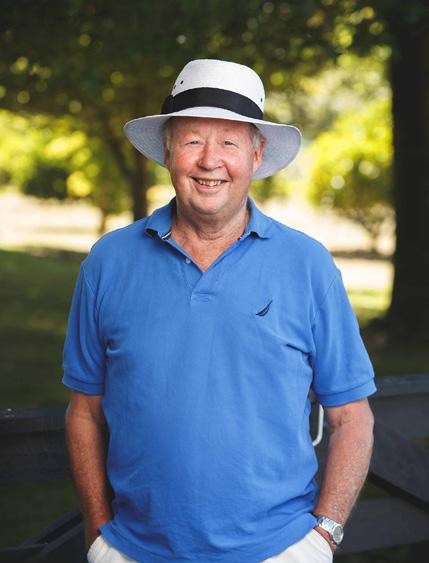
The wine notes below are from senior winemaker Kyle Thompson.
Wines imported by Hallgarten & Novum Wines
We aim to be the best wine producer in Marlborough, and the best in New Zealand, and as we continue to experiment and gain knowledge, we expect to see the quality from Saint Clair show constant improvement.
The 2021 was predominately sourced from the stunning Delta vineyard. It’s naturally low cropping and produces wines with perfumed aromatics, violets, a dark fruit complexity and beautifully structured tannins. Sitting in front of the fire with a good book and a large glass of Omaka Reserve, there’s no place I’d rather be.
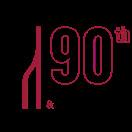
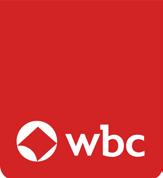
Can you find all 10 differences between the two pictures opposite? If you can, you could be among the five readers who win one of five prizes generously provided by WBC, the trade’s trusted supplier of wine boxes, packaging materials, shop display equipment and so much more
PRIZE 1
48 x 1-bottle Flexi-Hex postal packs and 24 x 2-bottle Flexi-Hex postal packs. Flexi-Hex is a post-ready eco-packaging solution for the safe shipping of wine and spirit bottles. Recyclable and made from a high recycled content, these packs come in three parts: a sleeve, a concertina base plate and an outer carton to turn your transit packaging into a gift.

Value: £206.40
PRIZE 3
36 x laser-cut 1-bottle wooden box with “cheers” window. Designed to fit a standard wine or Champagne bottle, this in-house design offers a cheeky alternative to the traditional wine box.

Value: £225.72
PRIZE 2
40 x 6-bottle jute bag with removable dividers, made from sustainable jute with a wipeclean, strong laminated lining. A practical yet stylish way to carry Champagne or wine bottles, it’s a great way to jazz up an everyday shopping trip.
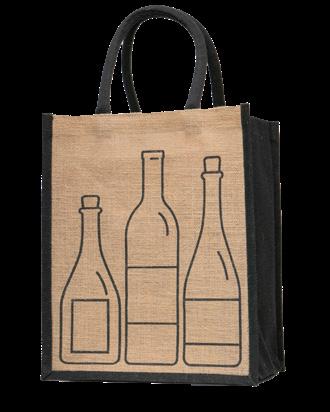
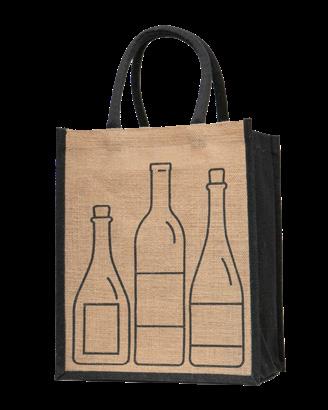
Value: £120
Vacuvin wine accessory counter-top display. Exclusive to WBC, this display contains Vacuvin’s best-selling accessories. These include 12 wine-save stoppers (sets of two); 11 active wine coolers (silver); 10 wine-saver pumps and stoppers; and nine winged corkscrews.
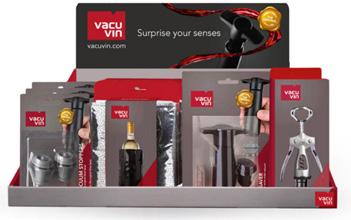
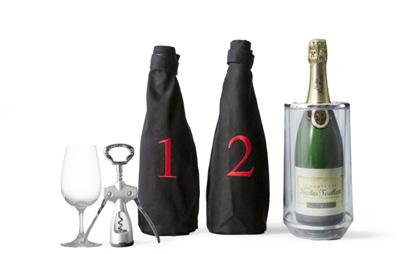
Value: £289
Wine tasting kit. WBC has put together a selection of some of its wine-tasting accessories so you can be fully prepared for all your professional winetasting events, winetasting courses, or sample tastings in-store. This kit comes with a pack of 6 corkscrews, 1 wine cooler, 6 ISO certified Wine Tasting Glasses and a pack of 10 individually numbered blind-tasting woven cloth covers.
Value: £90.08
Mark all 10 differences between the two pictures, on image B, using a Sharpie pen or similar. Take a clear shot of your edits and send it to claire@ winemerchantmag.com with the subject line Spot the Difference. Make sure to include your name, address and business details.
Correct entries received by the closing date of Friday, October 6 will be entered into a draw with five winners selected at random.
Ts & Cs: This competition is jointly organised by WBC and The Wine Merchant ONE entry per business. Retailers only. Entries received after October 6 will not be considered. No correspondence will be entered into. Winners will be named on November 15.

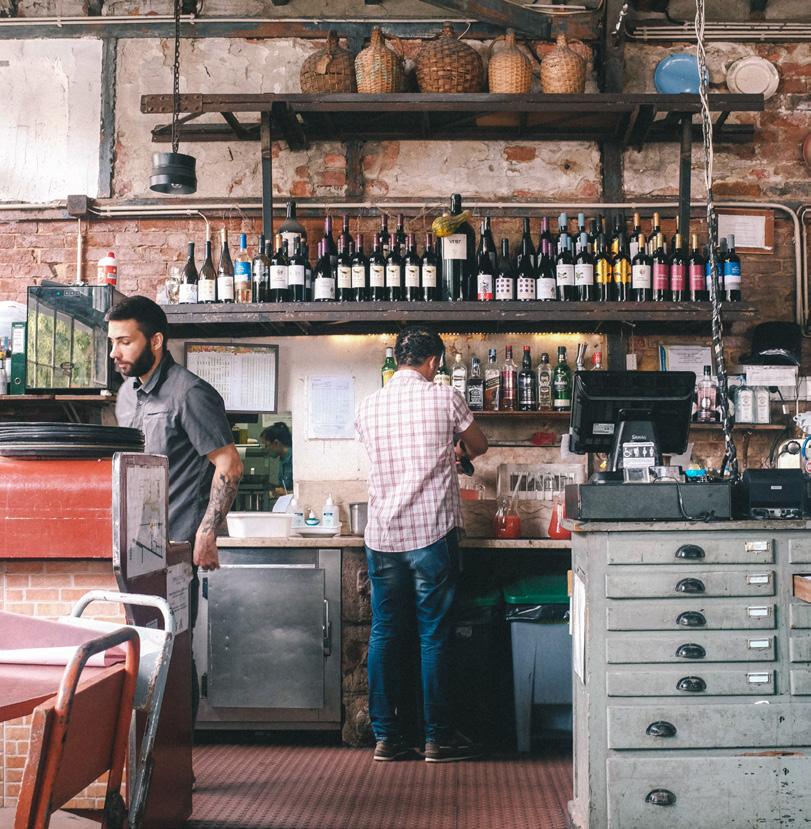
“The whole promotion has exceeded our expectations for sales and interest in Portuguese wines. We’re very pleased overall with its success.” That’s how Anne Harrison of Wine Down on the Isle of Man sums up this year’s Wines of Portugal Month. And she certainly isn’t the only independent wine merchant to see things that way.
June is for Indies is run by Wines of Portugal. Now in its third year, the 2023 campaign included 12 UK merchants from across the UK.
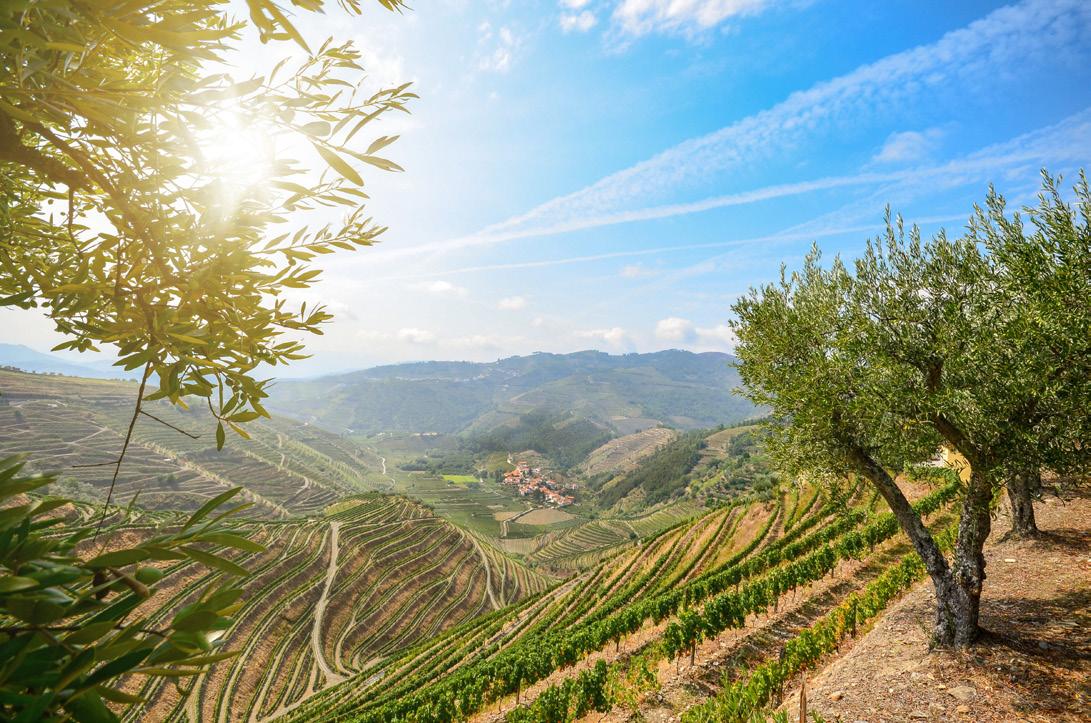
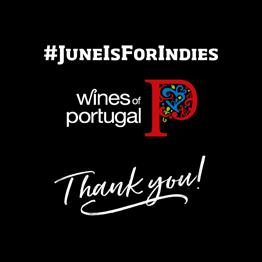
Participation brought with it a range of
This year’s June is for Indies campaign saw 12 merchants take advantage of support from Wines of Portugal – including the opportunity for Instagram Live sessions with Jamie Goode – to boost sales of a category that’s already hugely popular with consumers
POS materials – both digital and physical – as well as support from producers and winemakers. New this year was the opportunity for each merchant to go live on Instagram with Jamie Goode. These events saw a diverse range of Portuguese wines cracked open and tasted, and lively discussions about what makes Portugal such an exciting wine-producing country.
KWM Wines in Newry, Northern Ireland, achieved the highest IG Live reach with Jamie. “He is a big name in the wine industry and still so down to earth,” says owner Andrew Imrie.
“We could tell that we gained a few
followers during the Live, and in the next few days after. Since we are posting wine tasting videos online ourselves, we saw these followers maintained and hopefully added value to their day-to-day online journey. The video seems well received on his page, with several views and likes. An overall success on a different marketing channel that we really enjoyed.”
It is still possible to view Goode’s Instagram Lives with all 12 independent wine merchants: follow @drjamiegoode.
For other merchants the greatest results came via different routes. “Our biggest reach to our customers was not through
the traditional social media channels, but through MailChimp, with more than 70% engaging with our offers and promotions,” says Anne Harrison at Wine Down.
“Sales of Portuguese wines were significantly higher in June than in the first half of 2023, perhaps as much as 40% more.”
traditional wine-producing countries in the world. It has a wealth of indigenous grape varieties, each with its own personality and flavour. The diverse climate and topography, from the cool and green Vinho Verde region in the north west, to the hot and arid Douro Valley in the north east, to the sunny and maritime Alentejo and Algarve region in the south, make it particularly outstanding in our portfolio.”
In its first year, the June is for Indies campaign 2021 was awarded Trade Campaign of the Year by The Drinks Business. Its success was driven by two key factors: the quality, dynamism and value of Portuguese wines, as well as the creative sales and marketing efforts of the participating merchants.

“It is great for independents like us,” says Jonathan Cocker of Martinez Wines in West Yorkshire.
“It helps with engagement, and we tend to find our customers are receptive to learning about wine regions they may not have heard of. You feel like you are part of something bigger; it was nice to feel solidarity with other independents running the campaign.”
Lisa Gesell at KWM Wines adds: “We love taking part year after year and want to create as much added value as possible.

“As an independent wine merchant, we focus on our strengths of approachability and first-hand service. Wine tastings instore or Lives and reels seemed to work best for us.
“The giveaway of the winning wines was well received too. It’s great seeing excited customers being in with a chance to win, simply by purchasing their favourite bottle.”
She adds: “Portugal is one of the most
The campaign saw indies record impressive sales results. Simon Hill at the Artisan Wine & Spirits Co in Salisbury recorded an 808% increase in volume of Portuguese wines sold in June 2023 compared to June 2022. He says: “I anticipate that this increase will not be as high in forthcoming months, but the awareness of the wines has increased massively, and so we shall sell more Portuguese wines going forward.”

Frederico Falcão, chairman of ViniPortugal, is delighted that the campaign has become so successfully embedded in the UK independent trade.
’It was especially rewarding to understand that Portuguese wine importers have now marked this month in their calendar, and have totally integrated it into their own promotional agendas: from having their winemakers over for in-store tastings, or to tour around to visit their customers to present the new wines from their portfolio,” he says.
“This makes perfect sense to us at Wines of Portugal, as this campaign was specifically designed to help them sell more wines to the independent sector. Without them, this campaign wouldn’t be the success it has proven to be.”
Susana Balbo is one of Argentina’s most respected and influential winemakers – and indeed one of the highest-profile women in the world of wine.
Since 2013, she’s been working with chief viticulturist and head of operations
Edy del Popolo, who recently joined us from Mendoza to lead an online tutored tasting of six of the company’s most important wines in the UK market.
Two of the most talented and influential winemakers in Argentina joined forces when Susana Balbo recruited Edy del Popolo as chief viticulturist and head of operations at her eponymous operation in Mendoza in 2013.
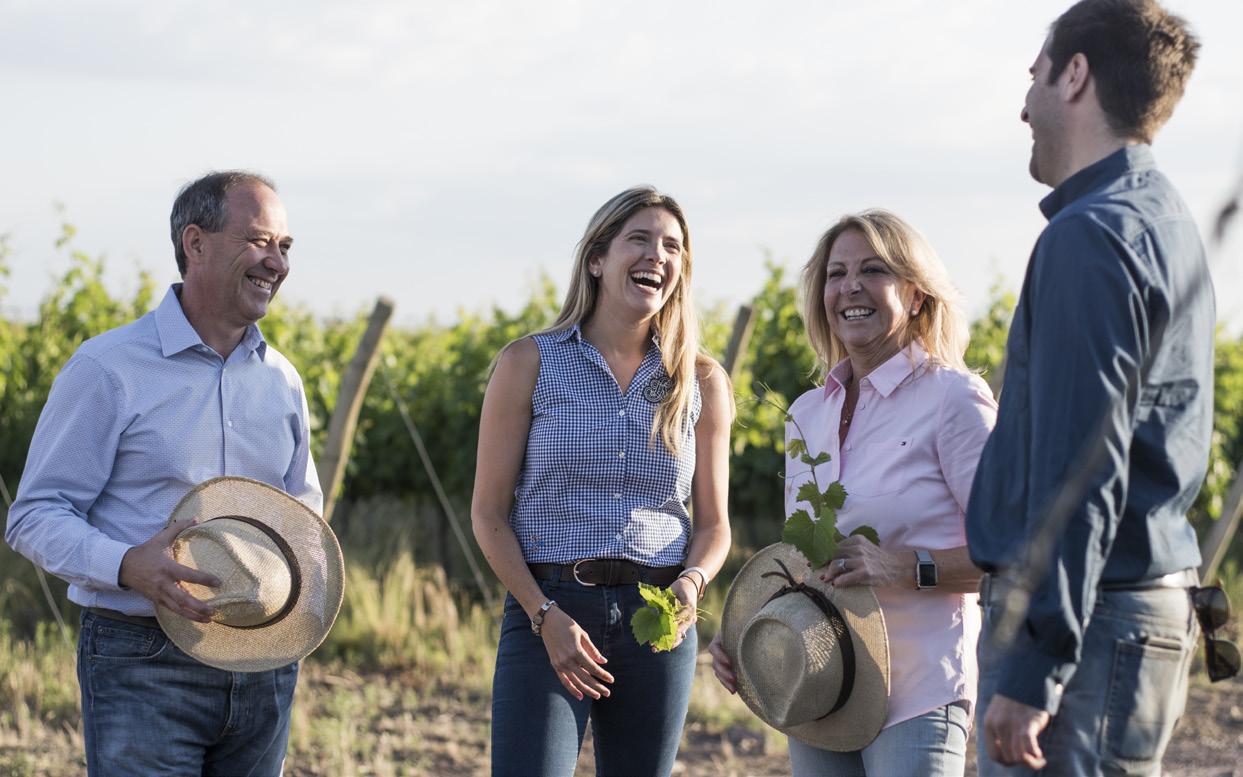
In the decade since, this highly respected pair have refined their winemaking approach, and their wines have become ever-more expressive of what del Popolo calls “our places, our terroirs”, notably the patchwork of different soils, elevations and climatic conditions that make up Argentina’s fastest-growing region, the Uco Valley in Mendoza, from which the company crushes 85% of its fruit.
Del Popolo’s enthusiasm for this special corner of the wine world is infectious, as the rapt audience of independents who attended a recent Zoom masterclass hosted by The Wine Merchant quickly discovered. But he is also meticulous about detail, and the attendees came away with a complete picture of the Uco Valley and its increasingly celebrated sub-zones and GIs.
Del Popolo (pictured above left) explains that the Uco Valley, which has 29,105ha planted, and which is divided into three sub-regions (Tupungato, Tunyan and San Carlos), now accounts for around 20% of the total Mendoza vineyard, putting the valley on a par with Burgundy, which has around 25,000ha planted.
But the comparison with the great French region goes beyond size and
scale, with the Uco Valley also matching Burgundy for complexity and variety of terroir – and, increasingly, for the worldclass quality of its wines.
As del Popolo explained, the region is largely (87%) planted on the three dozen alluvial fans that span the region (3% is planted on hills, a further 10% on plains), and crucially “different types of geologies are responsible for the soil formation in every fan”.
As you move from south to north, you therefore find very different soils, ranging from the sand, clay and stones of the Altamira subzone of San Carlos, to the darker soils with higher organic matter of La Remonta to the pale limestone-rich subsoil of Gualtallary in Tupungato.
You also find a variety of climates. Remarkably, Uco Valley has vineyards that fit into four of the five categories in the Winkler Index, and “in less than 50km, you can move from one climatic region to another,” del Popolo says. And, of course, altitude also plays its part, with elevations starting at around 1,000m, and varying by several hundred metres even within individual sub-appellations and GIs.
Del Popolo’s evident love of the Uco Valley means the company has “explored all the appellations”, and the event kicks off with a rosé that uses fruit blended from two sites in the valley.
But he and Balbo have been particularly taken with three areas, which between them were the source of five of the six wines tasted, giving attendees the opportunity to explore Gualtallary in the north, Los Chacayes in the centre, and Altamira in the south through a set of delicious site-specific bottlings.
Susana Balbo Signature Rosé, Uco Valley 2022
Balbo has been making this fresher, paler “more Provencal” style of rosé for seven years now, a contrast from the darker, fuller and fruitier saignée style that preceded it, but one which has been “very well received by people who like freshness” in the company’s 35 export markets. A blend of Malbec from Los Arboles and Pinot Noir from Gualtallary, it’s harvested early with potential alcohol no higher than 12%, and with plenty of acidity. It’s made as a white wine, with minimal skin contact, leaving, in del Popolo’s words, a pale onion-skincoloured wine with “juicy, salty acidity.”
“Lovely lengthy acidity on the finish. Very delicious!” – Hannah Ford, Starmore Boss, Sheffield
“Love the herbs and structure.” – Bruce Evans, Grape & Grain, Crediton
The two white wines on show give the attendees a chance to taste the terroir of Paraje Altamira, which was officially given GI status in 2016. Covering 2,750ha on “one of the big alluvial fans in the Uco Valley”, Paraje Altamira is “very homogenous, geographically speaking”, del Popolo explains, with altitudes between 900m and 1,100m, all in the Winkler III climate category, and with “sandy-loam soils with a lot of different sized stones, and white painted rocks and stones”. It is, he adds, “a place which is mostly devoted to red wines, but we found a spot where we can make beautiful whites”.
Susana Balbo Signature Torrontés, Paraje Altamira, Uco Valley 2021
Susana Balbo is renowned for her work with what del Popolo calls “Argentina’s only indigenous grape variety”, Torrontés, creating fine wines, notably in Cafayate, in Salta in far northern Argentina, from a once-maligned variety now known to have originated as a field crossing of Criolla and Muscat of Alexandria in the 16th century. Balbo also planted the superior Torrontés Riojano massal selection in Altamira, where del Popolo says it makes a lighter style, with less of the intensely aromatic Muscat dimension, and more white peach, and light floral tones, and, as it ages, flint, gunpowder and Riesling-like petrol
aromas. In this instance it’s fermented and aged for six months in new French oak barrels to bring “complexity and depth”.
“Lovely, crisp and clean: I can see why it would go with fish.” – Shania Foster
“Wonderful purity and freshness.” – Alistair Viner, Hedonism Wines, London
Susana Balbo Signature White Blend, Paraje Altamira, Uco Valley 2022
A Graves-influenced blend, with Torrontés in the Muscadelle role, this wine was a response to a challenge by Tim Atkin MW, who asked Balbo why Argentina wasn’t making more white blends, given how good its single-varietal wines could be. The Sauvignon and Torrontés are sourced from side-by-side plots, while the Semillon comes from a nearby 60-yearold vineyard. The Semillon and Sauvignon are fermented in concrete egg, and the Torrontés in barrel, before the blend is aged for four to six months in a mix of new and second-fill oak. According to del Popolo, each brings something different to the blend: the perfumes of Sauvignon and Torrontés, the freshness of Sauvignon, the mid-palate richness of Semillon …
“A delicious, layered blend.” – Jane Taylor, Dronfield Wine World, Derbyshire
“Delicate in style; perfumed but not too over-the-top. Lovely lengthy acidity and I certainly detected a bit of chalkiness.” –Hannah Ford, Starmore Boss
For the three reds in the line-up, del Popolo takes us to Los Chacayes and Gualtallary, for an exploration of Uco Malbec, with a sub-plot involving Cabernet Franc.
The first of the reds is sourced from a 1,100m-altitude vineyard “right next to the Andes” in the relatively small (1,600ha split between 12 producers) but rapidly growing Los Chacayes GI. “This expression is about fruits, dark fruits, blueberry, a very nice expression of a typical Malbec from this appellation in the Uco Valley,” del Popolo says, adding that the winemaking “is very classic”, with fermentation in stainless steel and ageing in neutral oak barrels to preserve the fruit.
“Lovely bright fruit and delightful tannins: really smooth, silky.” – David Williams, The Wine Merchant
BenMarco Sin Limites Gualtallary Malbec, Gualtallary, Uco Valley 2020
The final two reds are expressions of Gualtallary in the northern Uco Valley, where the row of hills at 1,000m to 1,600m
above sea level is, according to del Popolo, “the most fascinating places in the Uco Valley and one of the best places in south America to grow vines.” Here, work is being carried out to further sub-divide the valley, with five distinct sub-appellations based on terroir and climate: Rio, Vencedera, Albo, Monasterio and Las Tunas. The BenMarco wines are drawn from a vineyard “right in the division between Gualtallary Albo and Monasterio”, and which del Popolo says has five different soil types.
Sin Limites, the first of the two Gualtallary wines, is fermented in concrete and aged in neutral oak, and is described by del Popolo as “a mineral expression of Malbec” with dusty fine-grained, juicy tannins.
“Classy, layered expression of Malbec. Can just imagine it with a rack of lamb.” – Bruce Evans, Grape & Grain
BenMarco Expresivo, Gualtallary, Uco Valley 2020
A blend that was once sourced from vineyards across Mendoza has since 2014 been “a good expression of two things – Gualtallary, and what Cabernet Franc brings to Argentine reds: electricity,” says del Popolo. The different terroirs within Gualtallary contribute different characteristics to the blend (the sandy soils bringing ethereal qualities; the chalk and stones bringing minerality), and the blend itself changes from year, with warmer years delivering more Cabernet Franc, and cooler years more Malbec. It’s aged for 14 months in a mix of 70% new and 30% old barrels.
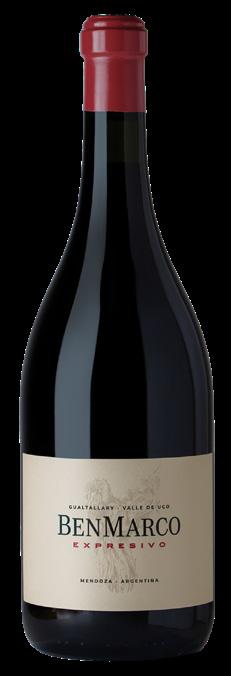
“A good expression. I would love to taste this in three years’ time, or even longer.” Maxwell Graham-Wood, Satchells Wine, Burnham Market
“Great to see the rise and rise of Argentine Cabernet Franc. Over the last few years it does feel like it’s forming increasingly significant portions of blends as well as cracking singlevarietal wines.” – Nat Carpentier, Dalling & Co, Kings Langley
There are many reasons to consider half bottles as a way of adding value and interest to any indie range
• When it comes to gifting, half bottles can be an attractive proposition. Merchants have reported success by adding 37.5cl bottles to hampers and gift packs, not just for Christmas but to mark other celebrations throughout the year such as Mother’s Day and Easter.
• Half bottles are a great way to try premium wines, giving consumers an opportunity to try an expensive wine at a lower price. Offering a range of wines in half sizes can encourage customers to push their wine boundaries.
• A demi-bottle is park-friendly. A lunchtime picnic perhaps calls for less alcohol consumption and smaller bottles are lighter and more portable. As a bonus, different tastes can be accommodated without hefting full-sized bottles around.
• Half sizes also offer the perfect solution for food matching. A bit hesitant to open a full-sized bottle of white for just the starter, when you know a hearty red is called for to match the main course? Half bottles could be the answer.
Julia Jenkins, Flagship Wines, St Albans
• The number of people living alone is increasing, according to the Office for National Statistics. In 2022 the figure stood at 8.3 million, up by around 600,000 on 10 years ago. That equates to 13% of all people living in households. Sure, some will be more than happy with a 75cl bottle, but a half-size may often be more practical.
• In terms of reducing alcohol consumption, half-bottles are a simple and effective way forward. For those wishing to drink less, there is a mental hurdle of opening a second bottle, no matter what the size. As the recommended number of units of alcohol per week should not exceed 14, drinking three half bottles of wine over the course of a week will ensure imbibers remain within professional health guidelines, even if they’re not sharing.
• Having a half bottle to hand in the kitchen is pretty useful. When a recipe calls for the addition of wine, it’s usually around 20cl, which means there’s just enough wine left for a small glass to enjoy while cooking.
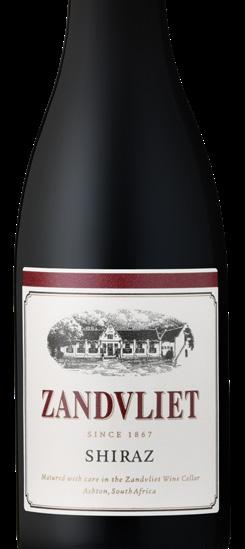
Van Lovren Wines
R46.98 FOB (6 x 37.5cl)
Zandvliet Wine Estate, on the outskirts of the Robertson Valley Wine Route, combines time-honoured tradition with modern-day expertise to produce pure luxury in a glass. The story of Zandvliet is all about Shiraz, being one of South Africa’s first Shiraz producers with the first plantings dating back to the 1870s.
“The magical key to Zandvliet wines lies locked within its soils,” says winemaker Jacques Cilliers, who took the reins at the iconic estate in 2011. “Known as calcareous Karoo, with a red clay underlay dotted with pockets of chalky limestone, this is what we call kalkveld. It’s the driving force behind our classical wines. Firm acidity, concentrated flavours and mineral traces are delicately managed from vineyard to cellar.”
Vines for this range are planted in a red weathered shale soil. It is rich in minerals, allowing the plants to grow and produce healthy bunches. Wines from these vineyards typically spend 20 to 24 months maturing in a 4,000-litre foudre of French oak, with the quality of fruit providing a complex wine with a soft, supple palate.
zandvliet.co.za
zandvliet@vanloveren.co.za
+27 23 615 1505
“We have a reasonable range of half bottles. We have a very straightforward Chilean Sauvignon and a Chilean Cabernet and I know there are other varietals in the same range. We also have a really nice Sancerre and some in between, so it’s not necessarily about premium wines for us. And I don’t see price being the driver for those sales either – I think it’s more about people being conscious of the quantity of wine they are drinking and wanting to be sure the wine is in good condition, rather than keeping unfinished wine in the fridge.
“I think it has more impact if the half bottles are displayed together rather than dotted around the shelves, where they tend to get lost. So regardless of country of origin or style, we put all the half bottles together, which makes it easier for customers.”
Lanchester Wines
RRP £20
A bright Champagne with a juicy mix of black cherry and candied pink grapefruit.This cuvée is the pillar of Moutard’s production. A refined, rich nose which evokes notes of butter, almond and brioche. A lively, elegant and balanced palate with good mouth feel. Made with 80% Pinot Noir and 20% Chardonnay from vines with an average age of 20 years.
Renowned Champagne house Champagne Moutard has been making wine since 1642 from its base in Buxeuil. It is recognised for its high-quality Champagnes, made from grapes grown in its own vineyards. The company cultivates approximately 20 hectares, primarily in the Côte des Bar region, and is known for its Pinot Noir grapes.
The grapes for the Grande Cuvée Brut are from the villages of Polisy and Buxeuil, two of the smallest communes in the Côte des Bar, on clay-limestone soils. Moutard follows sustainable farming practices with winter ploughing and desuckering at the end of May, before grapes are hand-harvested. The wine spends 36 months on the lees in Moutard’s chalk cellars in Buxeuil at a constant 12°C.
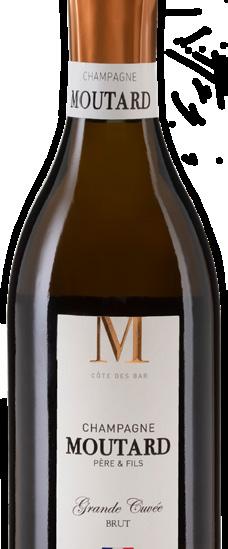
lanchesterwines.co.uk
01207 521234
Seckford Agencies
RRP £12.99
This wine is named in honour of former Rustenberg owner John Xavier Merriman, who bought the farm in 1892. He played a pivotal role in revitalising Rustenberg and promoting tourism and the agricultural values of Ida’s Valley, the area close to the town of Stellenbosch in which Rustenberg is situated.

John X Merriman is a Bordeaux blend, predominantly Cabernet Sauvignon and Merlot, and is Rustenberg’s Estate wine, known for its deep ruby hue and inviting aromas of dark berries, cassis, blackcurrants and subtle oak.
John X Merriman offers a balanced palate with well-rounded tannins and a lingering finish. A wine that captures the essence of the Stellenbosch terroir, showcasing the region’s unique climate and soil characteristics.
The cooler summer of this vintage gave the vines a slow ripening season, producing wines of excellent flavour, structure and tannin development. The John X Merriman 2021 has been awarded DWWA Silver.
Hatch Mansfield
RRP £31.85
Kleine Zalze Sweet Fortified NV is multivintage blend of Sauvignon Blanc, Chenin Blanc and Viognier.
The different batches of grapes are picked late and then fortified. As the grapes ferment, pure grape spirit is added to arrest the fermentation process and capture the essence of the wine, retaining the natural sugars. Ageing in oak barrels broadens the wine, giving it power, weight and a sweet, delicious elegance.
Each year only a small number of bottles are drawn from the barrels, which are then topped up with fresh wine from a new vintage, making this an ongoing and multigenerational tribute to a magisterial part of the great South African wine culture.
The unique labels were created under the guidance and expertise of Theo Paul Voster, renowned South African artist, and are a visual expression of South Africa’s stunning natural world. The result is an eclectic, exceptional and individual wine.
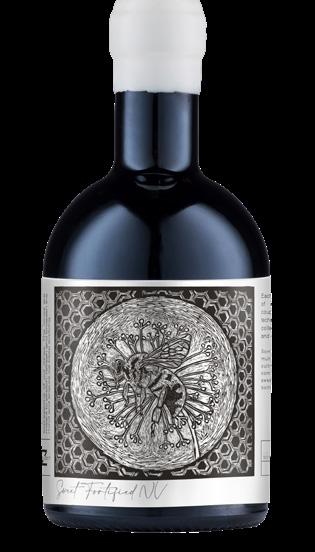
seckfordagencies.co.uk 01206 231188
hatch.co.uk
01344 871800

South African winemakers excel in many fields, using all kinds of grape varieties in a wide range of places and climates. But if you were to pick a single grape variety to represent the country on the global stage, a style in which it has arguably just one peer, it would have to be Chenin Blanc.

One of the more impressive elements of Cape Chenin is what might be termed its authentic versatility – an ability to produce wines at multiple styles and price points while retaining an essential South African something or somewhere-ness.
That means you can find zesty, youthful unoaked varietal Chenin that sings of place at prices that others simply cannot match (such as Boutinot’s 2023 Wine Merchant Top 100 Best Value White Trophy-winning Wild House Chenin Blanc, with its £8.99 RRP), alongside some of the world’s most keenly priced, impressive barrelfermented whites (the neutral-oakfermented and aged Kleine Zalze Vineyard Selection Chenin Blanc, imported by Hatch Mansfield) and such genuinely world-class, and in the global context underpriced, bottles such as Beaumont Hope Marguerite Chenin Blanc 2020 from Bot River (Dreyfus Ashby).

The linking theme with all the best Cape Chenin is of course the old – often very old and ungrafted – bush vines used to make them. The same is true of the Cape white blends of which Chenin is an essential part (officially they must contain a minimum of 15% Chenin and a maximum of 85%).
Led by the pioneering work of old-vine champion Rosa Kruger (who last year became the first viticulturist and first South African to win Decanter’s Hall of Fame award), South Africa has become one of the global centres of the fight to preserve the world’s old-vine heritage, and Cape white blends are among the best representatives of this “new” South African wine that has taken root over the past two decades. Recent favourites at The Wine Merchant include the enduring Swartland classic AA Badenhorst Kalmoesfontein White Blend 2020 (Swig) and the fine lines and tang of Donovan Rall’s “mountaingrown” (largely from Stellenbosch) six-varietal Vuurberg White 2018 (Boutinot).
South Africa’s second-most-planted white grape variety is not generally considered a part of the old-vine vanguard. But if it doesn’t have quite the hipster cache of bush-vine Chenin, vine age is nonetheless playing its part in the increased quality of Sauvignon emerging from the winelands in recent years. Around a quarter of South Africa’s just-shy-of 10,000ha of Sauvignon vineyards are now aged 20 years or more, and a further quarter are 16 to 20 years old.
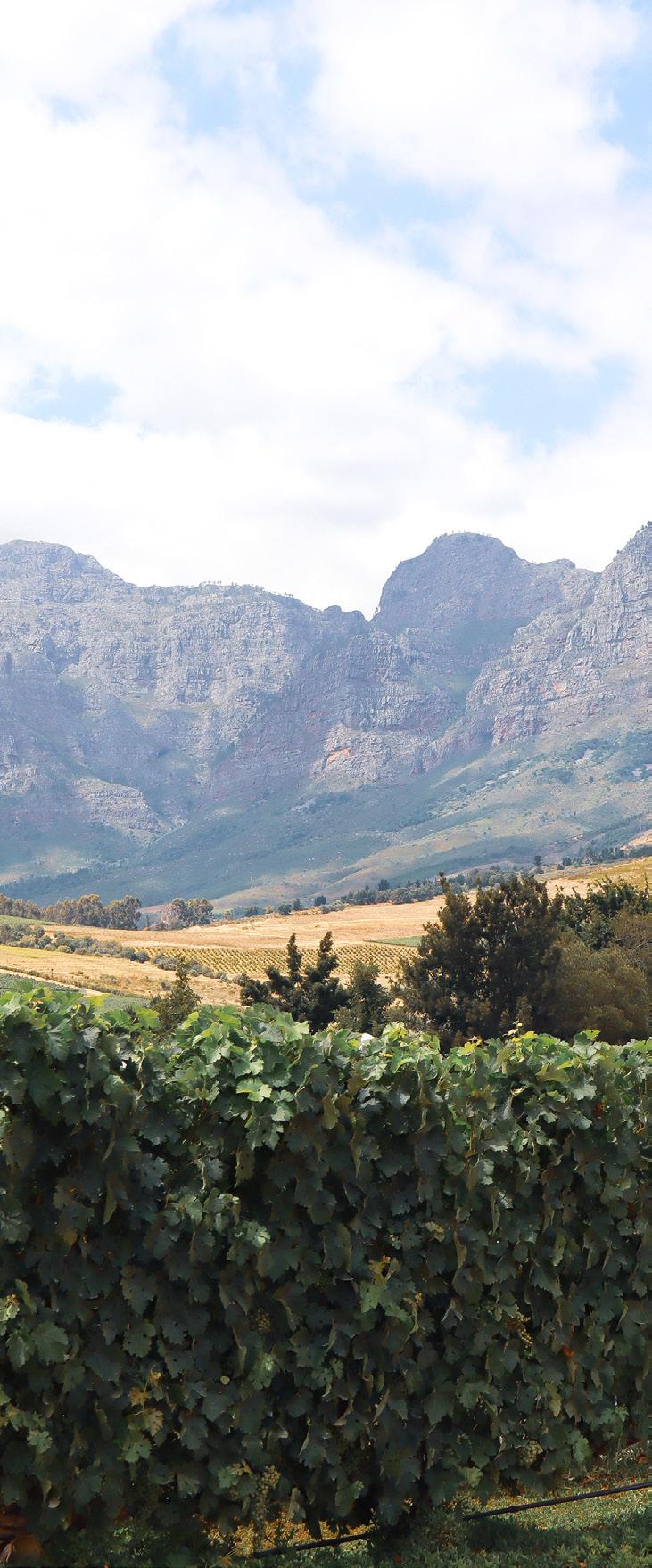
It’s the location of those vines which is perhaps more important, however, with the variety of terroirs contributing greatly to the appeal of a style that was well placed to seize the opportunity offered by recent short vintages in New Zealand and take a more prominent role in slaking the UK’s seemingly inexhaustible Sauvignon thirst.
That variety can be seen in a trio of Wine Merchant picks: the fleshy but racy Iona Highlands Sauvignon Blanc 2022 from Elgin (Alliance Wine); the ripple of ocean-freshness of Cape Point Reserve Sauvignon Blanc 2021 from the Cape Point peninsula (Graft Wine); and the pristine stone-fruited fluency of Waterkloof Circumstance
Sauvignon Blanc from the slopes of the Schapenberg in Stellenbosch.
 Vines in the Western Cape
Vines in the Western Cape
In terms of the scale of plantings, Chardonnay by far outstrips Pinot Noir: the versatile white variety stands at 6,548ha, putting it seventh on South Africa’s varietal list, while Pinot is back in 11th place on 1,193ha.
That Chardonnay is in decline (down from 8,092ha in 2011) and Pinot on the way up (1,019ha a decade ago) says rather more about mainstream global fashions than it does about South Africa per se – and the statistics certainly don’t show the enormous strides taken by top-tier producers working with both.
Of course, the best Chardonnay and Pinot producers are often one and the same in South Africa, just as they are in Burgundy, Tasmania, Champagne and California. And there is a particular concentration of elegance and excellence in the relative cool of Hemel-en-Aarde Valley, and in wines such as Hamilton Russell Chardonnay 2020 (Mentzendorff), Crystallum Cuvée Cinema 2021 (Liberty Wines) and Newton Johnson Southend Chardonnay 2021 (Dreyfus Ashby).
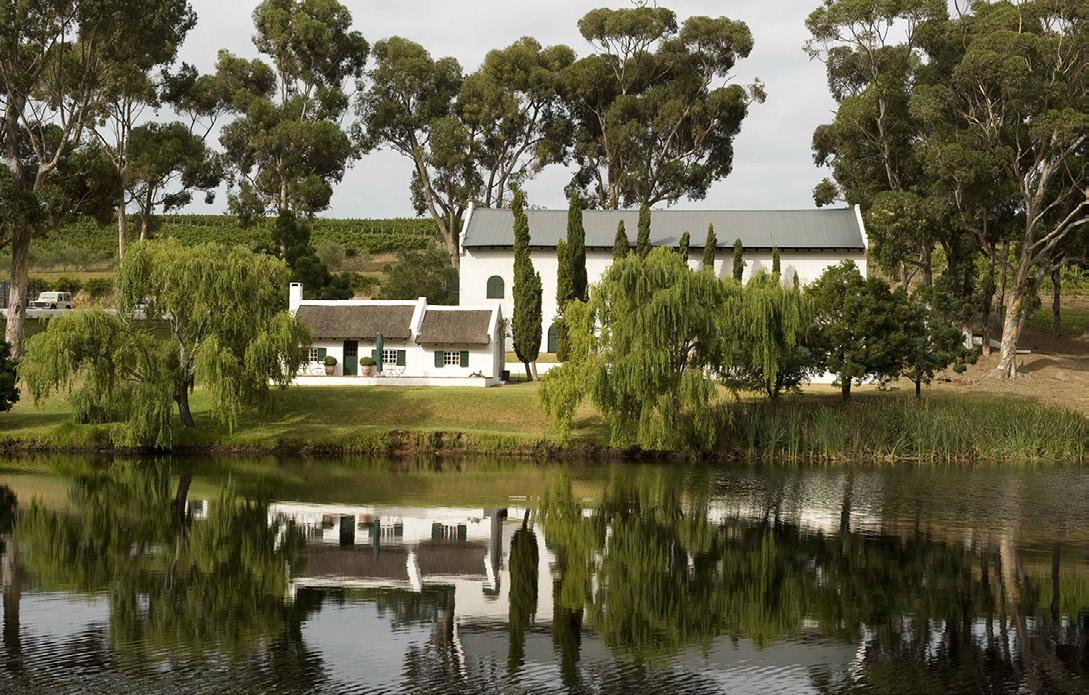
Much of the coverage of Cape red wine in recent years has focused on the funkier preferences of the new wave, surfer-dude Swartland set and their cool-climate friends along the coast: Rhône and other Mediterranean varieties and Pinot Noir.
All of which is perfectly understandable in a global context, where stuffy Bordeaux has been in the shadows of Burgundy and, to a lesser extent, Northern Rhône.
It makes rather less sense, however, when you consider that Cabernet Sauvignon remains the Cape’s most widely planted red variety, and its third-most planted overall. And it starts to look bizarre when you factor in the remarkable quality of the country’s best examples of Cabernet and Cabernet-based blends.
That these wines are still underrated by many in the trade is no doubt a legacy of the green and rubbery flavours that used to mar so many of even the most ambitious of South Africa’s reds. Those days are long gone, however, and bottlings from the Cape’s answer to Bordeaux, Stellenbosch,
I came into the wine industry slightly by accident, really. Initially I never considered farming as a career and wanted to go into veterinary science. I started the process by doing a BSc at Stellenbosch University and at the same time I worked on farms in Constantia (Buitenverwachting and Constantia Uitsig) in both the vineyard and in the cellar. I also spent a lot of time selling wine in the shop at Constantia Uitsig. I met some fascinating people during that time and really enjoyed the work I was doing. I decided to make wine my full-time career.
South Africa is producing stellar wines which are better than ever before. This is driven by an increased focus on the winemaking. Producers are trying to be more focused on what varieties are best suited to specific terroir and vineyard sites, producing wines of great character and sense of place. There’s a new-found confidence in South African winemakers to make wines that express South Africa rather than emulating the rest of the world. This is leading to more characterful and dynamic wines, and the wine community has started to realise how good South African wines are.
The recent resurgence of interest in South African wines is signalling the
A complex wine full of blackcurrants, spice and ripe plums, with attractive wood aromas and flavours. It is full and rich with prominent tannins and good ageing potential.

end of a long legacy of isolation. We are enjoying a greater exposure to the international wine community as a whole, and this allows for more travelling and exchanging of ideas, which in turn brings new impetus to not only how the wines are made but also new vineyard practices and marketing opportunities.
After many years at Glenelly the transition has been quite an interesting one. It has been very exciting for me and after doing the first harvest I am more excited than ever. Being part of a property like Vergelegen is such a great honour and a daily inspiration.
My job doesn’t only include making wine. The role that I fulfil allows me to see the business from all angles. I enjoy spending time in the market, selling wine and connecting with the people who promote and enjoy our wines. From a purely winemaking perspective, I firstly enjoy the excitement and exhilaration in the days just before harvest, walking
A white Bordeaux-style blend. Tight, focused and beautifully integrated with herbal and grapefruit flavours, ripe tropical notes, and a long, focused aftertaste.
Luke joined Vergelegen in 2022. He worked at Rustenburg Estate for five years and spent time at Château de Fieuzal and Château Angelus in Bordeaux, Caves Robert Dietrich in Alsace and Screaming Eagle in California before joining Glenelly Estate in Stellenbosch in 2008. His wines are noted for their power, elegance and balance.
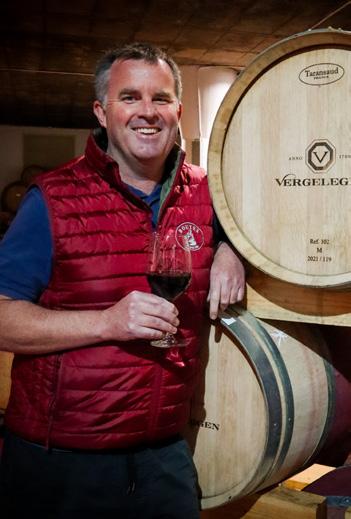
Wines imported by Fells
through the vineyards, deciding when the best time is to pick the grapes, and then the energy when the grapes start arriving in the cellar. Secondly, I enjoy spending time piecing together the blends and making sure that the resulting wine expresses both the vineyard and the vintage.
I believe that Vergelegen is synonymous with wines that are very classic and timeless in style, and also have great ageability. Going forward, the range will be more focused and expressive of the unique terroir that the property has to offer.


The future is very bright and filled with renewed energy and dynamism. This will be felt across the board, from the wines to hospitality. Our tagline is Rooted in Nature and that is very important for us going forward, working within the natural environment that surrounds us as well as looking at where our heritage is rooted.
Vergelegen has 323 years of history and, as the current custodians of this magnificent property, it is a daunting task to follow in the historical footsteps of those who blazed a trail before us. We endeavour every day to be trailblazers ourselves, and stay true to the ethos of the property and continue the rich history that it holds.
A 90% Cabernet Sauvignon and 10% Merlot blend. Plum, chocolate, cassis and graphite on the nose, complemented by a complex minerality. On the palate, the fruit, tannin and acidity marry perfectly to offer balance and complexity.
such as Keermont’s luxuriously textured and complex Cabernet Franc, Cabernet Sauvignon, Merlot and Petit Verdot blend Amphitheatre 2016 (Swig), the suave, finely balanced Glenelly Lady May 2017 (Seckford Agencies) and the cedary cassis of Meerlust Estate Cabernet Sauvignon 2018 (MMD) are a match for Cabernet-based wines from anywhere.
Will Pinotage ever have mainstream appeal? Will it ever be accepted as a fine-wine variety? Or is it forever destined to divide opinion between a large camp of sceptics and a small group of perversityloving fanatics?
If there is a single producer capable of putting such questions to bed permanently it’s Kanonkop, with the remarkable quality of the estate’s
single-vineyard Black Label Pinotage (Seckford Agencies), a wine that was made from the first ever commercial plantings of Dr Perold’s crossing of Cinsault and Pinot Noir back in 1953, making it one of South Africa’s finest reds since it first emerged with the 2006 vintage.

The rest of the Stellenbosch producer’s output is no less impressive, not least the punchily priced Kadette, while the meatyherbal Piekenierskloof Johan Van Zyl Old Vine 2019 from Citrusdal Mountain (Stone Vine & Sun) and the vivaciously wild and brambly Wolf & Woman Pinotage 2021 from Swartland are bringing a new-wave freshness to this much-maligned grape variety.


Wildeberg is situated in the upper corner of Franschhoek, called the “Bohoek”. An amphitheatre of mountains surrounds the farm, creating its own unique microclimate, where you get four seasons in one day. In one moment the wind can blow you off your feet and in a heartbeat it can calm down for a perfect summer day. It’s also a place where we share the vineyards with baboons – and even leopards higher up in the mountain.
The first small maiden vintage was in 2018. This was also the year we planted most of our vines on Wildeberg. The new winery was built in 2021.
We only work with vineyards that have a special feel to them. This can be from old vineyards planted in 1905, the highest vineyard in South Africa or the most southerly vineyard in Africa. It’s also important for us to work with like-minded farmers who have a passion for viticulture and wine, and understand that wine is made in the vineyard.
We work with such special and unique vineyards that we don’t want to “panel beat” the wine into something that we think it should taste like. It’s important to express the vineyard and site, and that needs to show in the wine. So to achieve this we believe in “lazy winemaking”. All
wines are naturally fermented with no additions other than sulphur, no fining and just a coarse filtration before bottling.
We try and work as naturally as possible, but will intervene if the wine needs it. We like working with wholecluster fermentation on the reds, which gives a more elegant wine with spice and perfume. On the whites, we prefer to ferment slightly dirtier, adding texture and helping to capture the sense of place that we’re seeking in our wines.
JD makes wine in one of the most untamed parts of the Cape, in a mountainous corner of Franschhoek. He captures the “weird, crazy” environment in every bottle he produces with the Wildeberg team.
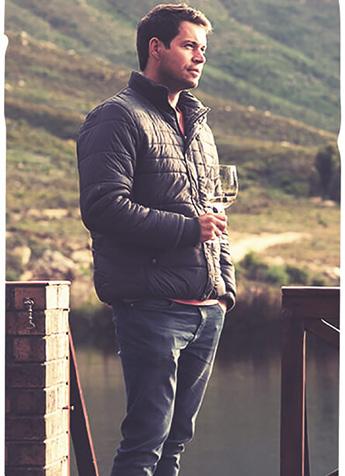
Wines imported by
It’s always nice to get a gold star on your forehead, but we’re not chasing points. As soon as you start doing that, winemaking becomes more important than viticulture and you lose that uniqueness and sense of place.
We always play around and have fun with different varieties and vineyards, but for now I think the main focus would be to fine-tune what we are already making and grow from there.
It’s any winemaker’s dream to start a project like this from scratch. A blank canvas, where the possibilities are endless. Being part of a great Wildeberg team, I’m truly living the dream.


RRP £9.49
100% Franschhoek Semillon from a vineyard planted in 1905. Hand harvested and naturally fermented in 600-litre Austrian oak and matured for nine months.
The majority of the fruit is from Elgin, the coldest vine growing area in South Africa. Naturally fermented in tank and kept on the fine lees up until bottling.

RRP £13.99
Cabernet Franc and Malbec are two varieties that do very well in the Coastal Region. Cabernet Franc is from Franschhoek and Stellenbosch, and the Malbec from Paarl. They’re matured separately for 18 months in 300-litre French oak barrels (30% new).
Wildeberg White 2021 RRP £21.99The job of a winemaker can sometimes revolve around repeating past successes rather than breaking new ground.
But at Kleine Zalze, cellarmaster RJ Botha and his team are encouraged to let their imaginations run riot with the Project Z range.

About eight years ago, they began trying different ways of working with their grapes, mainly Chenin and Syrah. “Project Z started as an experiment in how to make Vineyard Selection and Family Reserve wines even better, and keep up with what was happening around the world,” Botha says.

“The idea was to work with different techniques, different fermentation vessels etc, to enhance texture, but not necessarily add oakiness.”

Amphorae were procured and the wines that the team made weren’t simply tasted young and blended away. “We wanted to see what happened to them after a year or two or three in bottle,” Botha says.
The results were startling. “I’ll never forget, we had a couple of friends over here at the tasting room – smaller producers that are used to making small-batch wines. We wanted their honest opinions about the wines that we’d been trying. We explained we’d been working with amphorae and things like whole-bunch
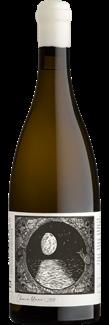
This is from heritage vineyards very close to the sea on decomposed granite soils. After crushing it goes directly into amphora to ferment, then after racking it goes back into amphora for 11 months. The filtration is not harsh. The idea is to capture the freshness, texture and minerality of the wine. It’s very linear and flinty.
fermentation on the Syrah. We tasted them blind and everybody was just blown away. They thought the wines were really superb.”
The decision was taken to release the wines under the Project Z label, to keep them distinct from the mainstream Kleine Zalze wines. General manager Carina Gous came up with the idea of creating bespoke labels for each one, based on ideas suggested by members of staff. That tradition has been maintained, with each concept brought to life by local lino-cut artist Theo Paul Vorster.
Now each Project Z release is eagerly anticipated, not just for the new artwork, but for what surprises might lurk inside the bottle. “It’s a way for us to express ourselves and to work with different techniques and different strategies,” says Botha.
“Also, if we stumble upon some interesting vineyards and we want to work with them but they don’t necessarily have a home, it gives us a way of expressing that as well.
“We’ve just launched a Riesling. Next year there will be an Albariño. Some of the newest Chenins will have concrete eggfermented portions in them. We’re going to release an amphoraaged Cabernet next year that will have absolutely no oak on it. We’re working on a sparkling wine from a heritage vineyard.
“So we’re really pushing boundaries and evolving styles. It makes us think differently about wine. The wines are super cool, but at the end of the day, what we learn from them is incorporated into our mainstream winemaking.”
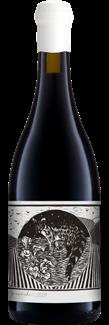
This is from a bush-vine vineyard on the cooler side of Darling. We do a 30%-40% whole-bunch portion and crush the rest on top in a stainless steel tank. The wine ages in old barrels and amphorae for about 12 months and then we do a final blend. It’s quite a different style, very light and elegant. You'll see it in the colour too. It’s really fragrant. It’s almost got an earthiness to it as well.
We had different bits and pieces in the winery – noble late harvest Chenin, Muscat and a sweet Sauvignon Blanc component. We blended them together and added eau de vie and put it in barrel. As it aged we found it was incredible. Now every year we produce something unique and blend it in to enhance what we have. It’s rich, nutty and apricoty but not overly sweet. It’s an amazing, fun wine.
It’s not hard to find South African winemakers who believe that of the three grape varieties tied together in a family hug by Pinotage, it’s the least fashionable of the two parents that has the potential to be South Africa’s trump card.
The idea is that Cape Cinsault can trump the supposedly more noble Pinot Noir for vine age, while avoiding any of the ash-tray and cherry bubblegum that afflicts so much commercial Pinotage.
It’s certainly the case that the quality of oldvine Cape Cinsault is more than a match for other currently fashionable iterations from California and southern Chile. Wines earning the Wine Merchant seal of approval include the hauntingly pure and fluent Scions of Sinai Cinsault from the Lower Helderberg (Indigo); the supple red-fruited joys of Rall Cinsault 2021, a 50/50 blend of old-vine fruit from Darling and Swartland (Justerini & Brooks); and the bright, tomato and strawberry energy of the perennially great value Pecheron Old Vine Cinsault 2021 (Boutinot).
If Chenin and the Cape white blend are the emblematic white wines of the new South Africa, then it’s Syrah and Rhône blends that have played the lead role for reds.
Syrah alone is responsible for an unusually large number of South Africa’s most critically acclaimed reds, and Rhône varieties are favoured by a number of its most influential producers: Eben Sadie, Franschhoek’s Boukenhoutskloof (New Generation) and its Swartland project Porseleinberg (New Generation Wines), Mullineux & Lieu Family (Liberty Wines), Boschkloof (Enotria&Coe) …
Given that the top bottlings of each of these are now attracting Northern Rhône or Châteauneufdu-Pape-like prices, it’s a good thing that South African Syrah and Rhône blends also shine at Côte du Rhône and Languedoc prices, with Swartland producers such as Riebeek Cellars (Nectar) and Swartland Winery (Hallgarten & Novum Wines); Stellenbosch’s biodynamic Reyneke (New Generation); and Cederberg (Bancroft) from the eponymous high-altitude region all filling in the
vital £10 to £20 price points with wines full of character and charm.
If South Africa’s winemakers have begun to settle on a set of grape varieties for the majority of their output, there is still plenty of scope for varietal experimentation, both with recently planted and rediscovered old vines.
Stand-out, lesser-spotted single-varietal wines that have caught the eye in recent months include the shimmering The Foundry Roussanne 2021 (Dreyfus Ashby); the spice-and-herb-inflected richness of Vasco and the Explorers Touriga Nacional; and the tensile lemon and blossom of Lemberg Hárslevelü 2021 (Seckford Agencies).
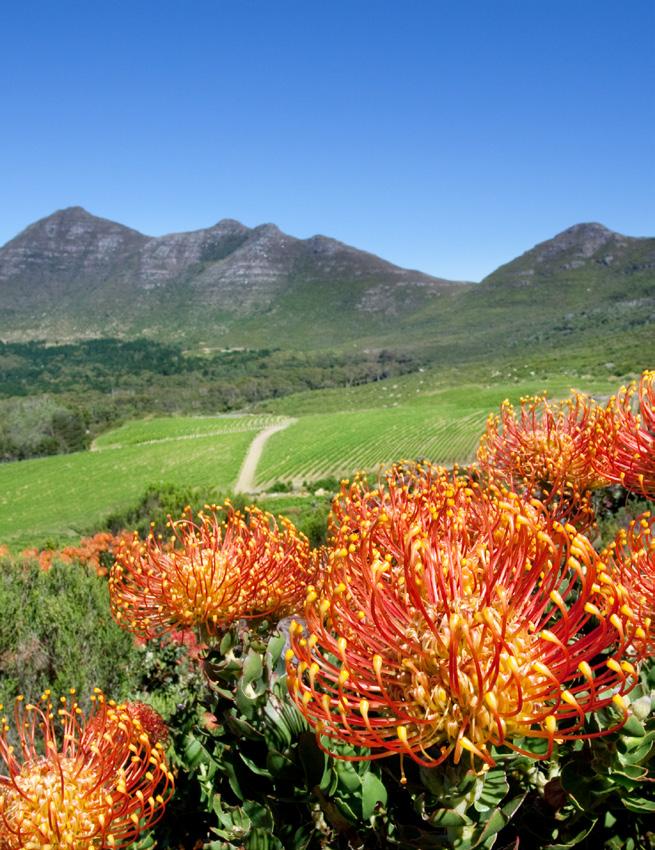

Boschendal is an unforgettable place, as anyone who has visited will confirm. Described as a “pioneering and ethical village”, the estate has more than three centuries of history and sits between Franschhoek and Stellenbosch in South Africa’s Western Cape.
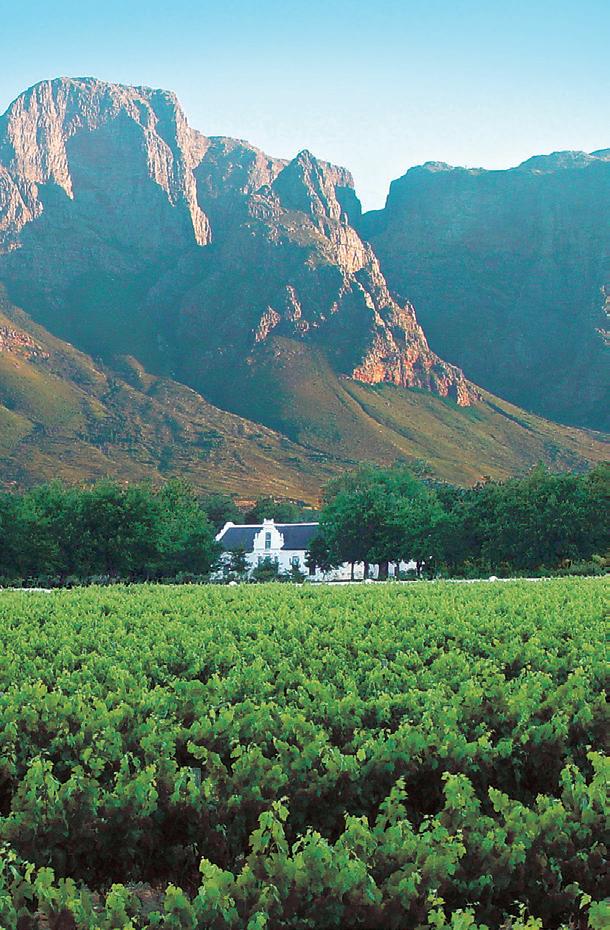
The wines are just as memorable, made with the same respect for terroir, sustainability and biodiversity that underpins every aspect of Boschendal’s existence. This is a place where people and nature coexist happily and productively.
Boschendal’s track record speaks for itself but in recent years the focus has shifted even more towards terroir-driven wines. As head winemaker Jacques Viljoen explains, a focused investment in vineyards in Elgin for premium white wines and Stellenbosch for premium red wines, are delivering impressive results.
The Boschendal premium range is aimed at the independent trade and sold in the UK via DGB Europe, which holds stock at LCB London. Contact kristin.basson@dgbeurope.com or see boschendalwines.com for more information.

Elgin RRP £24
“As well as being one of the oldest wine farms in South Africa, we’re also the second oldest Cap Classique producer. We’ve invested in our own vineyards in Elgin, specifically focusing on Chardonnay and Cap Classique. We’ve set the standard for ourselves. It’s usually a 50-50 Pinot Noir-Chardonnay depending on the year; the 2016 is 63% Pinot Noir. It’s got a nice freshness and longevity within the juice itself with naturally low pH and naturally high acidity. It’s got crispness and fine bubbles … it’s really polished, and there’s ageability, too.
“We leave it for a minimum of five years on the lees after the fermentation. We just keep it as natural as possible, with six grams per litre of residual sugar, which is almost nothing. It’s a phenomenal wine. Of the Cap Classiques that we do, this is my favourite.”
Elgin Chardonnay
Elgin RRP £33
“This is probably one of the most awarded wines, I want to say in South Africa, but definitely at
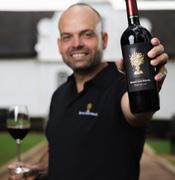
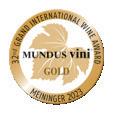

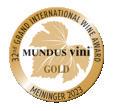




Boschendal itself. It’s been rated numerous times as best white wine in South Africa.
“Elgin lends itself to premium quality Chardonnay. It is so terroir-specific, influenced by elevation, proximity to the ocean and granite-rich soils. There is a minerality that comes through in these wines.
“Once again, there is naturally low pH and great natural acidity. It’s very clean, fresh and minerality driven. It’s whole-bunch pressed. We start the fermentation spontaneously and it stays in barrel for 11 months, with bâtonage on a weekly basis. We don’t encourage malolactic fermentation, but it is nice if one or two of the barrels go through malo. It does add an extra touch.”
Cape Coastal RRP £20 (magnums available) “This is the wine that empowers us to work sustainably in the Helderberg, Stellenbosch. Currently it is a Cape Coastal blend, because there’s some Merlot in the blend that comes from Elgin, giving elegance, freshness and bright red fruit. From the 2022 it will be 100% Stellenbosch.
“Nicolas is an unconventional blend. It’s got all the Bordeaux varieties and Syrah just adds
smoothness, roundness and drinkability to the wine. It’s a high-quality brand. It’s got great tannins to give it ageability, but I also want you to be able to drink it now, and just enjoy it and experience it. It’s an amazing wine and I’m very proud of it. It’s an awesome wine to make; it’s a privilege just being able to work with those vineyards, in the Helderberg and currently also in Elgin.”
Boschendal Vin d’Or
Noble Late Harvest 2019
Elgin RRP £18
“This wine is always a challenge just because it is made in such minute volumes – we run out of this liquid gold quite quickly. Once again it’s from Elgin, where we probably have the best example that I’ve ever seen in my entire life of noble rot. We should actually get somebody in there to take photos for textbooks.
“It’s a terrific wine to make. There’s about 140g of residual sugar and it’s got that beautiful lime peel, dried apricot flavour to the nose and a nice honeysuckle note on the palate itself. And great acidity, of course. I would say enjoy it after dinner with a nice cheeseboard: that would be absolutely amazing. The stronger the cheese the better.”
Western Union, a company renowned for connecting people around the world, released a statement in 1876 that said “the telephone has too many flaws and has no value to society”. Some things just take time to gain respect and appreciation. The wine industry is no exception.
For decades, Chilean producers considered País to be a variety that was only useful for making bulk wines; Pinotage has been mistreated by South African producers and Fernão Pires has been associated with wines of volume as opposed to quality. In the last 10 years País has become trendy, Pinotage has started to turn heads and we have discovered that Fernão Pires can produce worldclass wines.
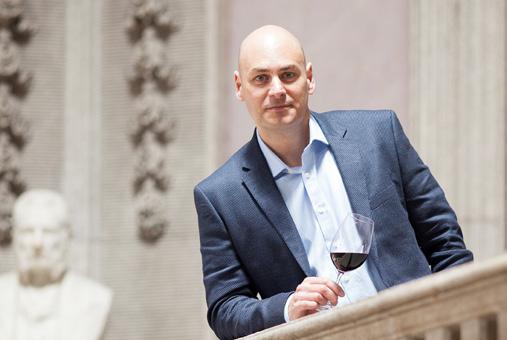
Textbooks first mentioned Fernão Pires back in 1788. Despite its long history and the fact that it is the most widely planted white grape in Portugal, the variety has only recently started to gain the recognition it deserves. Now this perception is changing fast, and it represents an opportunity for smart professionals and consumers.
The reasons for this change include the fact that producers have started to treat Fernão Pires with more care in the vineyard and are paying special attention to parcels containing old vines. In addition to lower yields, recent years have shown producers to be more ambitious and, amongst other things, they have been exploring different winemaking techniques and a judicious use of oak.
The variety has responded well, especially to larger and older vessels, which contribute to its texture and impart complexity, without dominating the delicate aromas and elegant flavours reminiscent of citrus fruits, orange zest, honey and floral notes.
The turning point and confirmation of its recognition came in 2021 when Falcoaria Vinhas
Velhas Fernão Pires 2018, which comes from a 70-year-old vineyard, was awarded the best white varietal wine at the Concurso dos Vinhos de Portugal, the most important domestic competition. Other great examples of varietal wines made exclusively with Fernão Pires include Quinta da Alorna, Falua, Casa Cadaval and Casal Monteiro, amongst others.
As well as its ability to make attractive varietal wines, Fernão Pires is excellent as a blending component.
Encosta do Sobral, a property in the sub-region of Tomar in the northernmost vineyards of Tejo, distinguished by its schist soil, includes Arinto and Verdelho in its blend. Fiuza, a family company producing wines for over a century in the Tejo region, favours Chardonnay and Arinto, whilst Quinta da Lagoalva features Alvarinho, Arinto, Sauvignon Blanc and Verdelho alongside Fernão Pires to make a convincing and delicious white blend named Talhão 1 that displays intense fruit combined with pleasant underpinning freshness.
Responding to the latest fashion, Tejo producers have also been adopting ancient production methods, fermenting white grapes with their skins, and quickly
This versatile white variety is finally taking its place in the big league, and nowhere is it more at home than in Portugal’s Tejo regionDirceu Vianna Junior MW
discovered that Fernão Pires performs this role very well. Quinta da Lapa makes a wine called Fernão Pirão, and Quinta da Ribeirinha has a label called Contracena; both are great examples of this style.
The versatility of the variety can be further determined by searching for a sparkling wine from Quinta da Lapa called Nana, where Fernão Pires plays an important role in the blend, or by exploring Falcoaria Late Harvest, one of the most consistent and best dessert wines of Portugal.
In addition, Quinta da Alorna makes a sublime example of fortified wine, Abafado 5 Anos, which, since the 2016 vintage, has consisted exclusively of Fernão Pires. It displays inviting notes of quince, guava and orange marmalade. Despite the trend to move away from sweet and high-alcohol wines, this wine is outstanding and worthy of consideration.
By contrast, as fashion is favouring white wines that are fresher, lighter and without the influence of oak, CVR Tejo has worked alongside local producers to launch a new category of wines called Campo do Tejo with its own regulatory delimitations and distinct image.
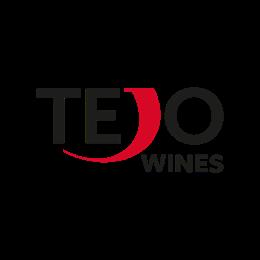
The aim is to offer consumers a contemporary style of wine whilst transmitting the identity of the region through its most important grape variety. The style of the wine must be dry, fresh, vibrant, not exceed 12% alcohol and free from oak influence.
The blend may include up to 15% of other local varieties, except for Muscat or Sauvignon Blanc, as these could overpower the subtlety of Fernão Pires. There are good examples of the new styles already on the market, especially from Quinta da Lagoalva, Quinta do Casal Monteiro and Pitada Verde. As this is a project that is just getting off the ground, there is an opportunity for companies and professionals that pride themselves on being leaders and on the cutting edge of the industry.
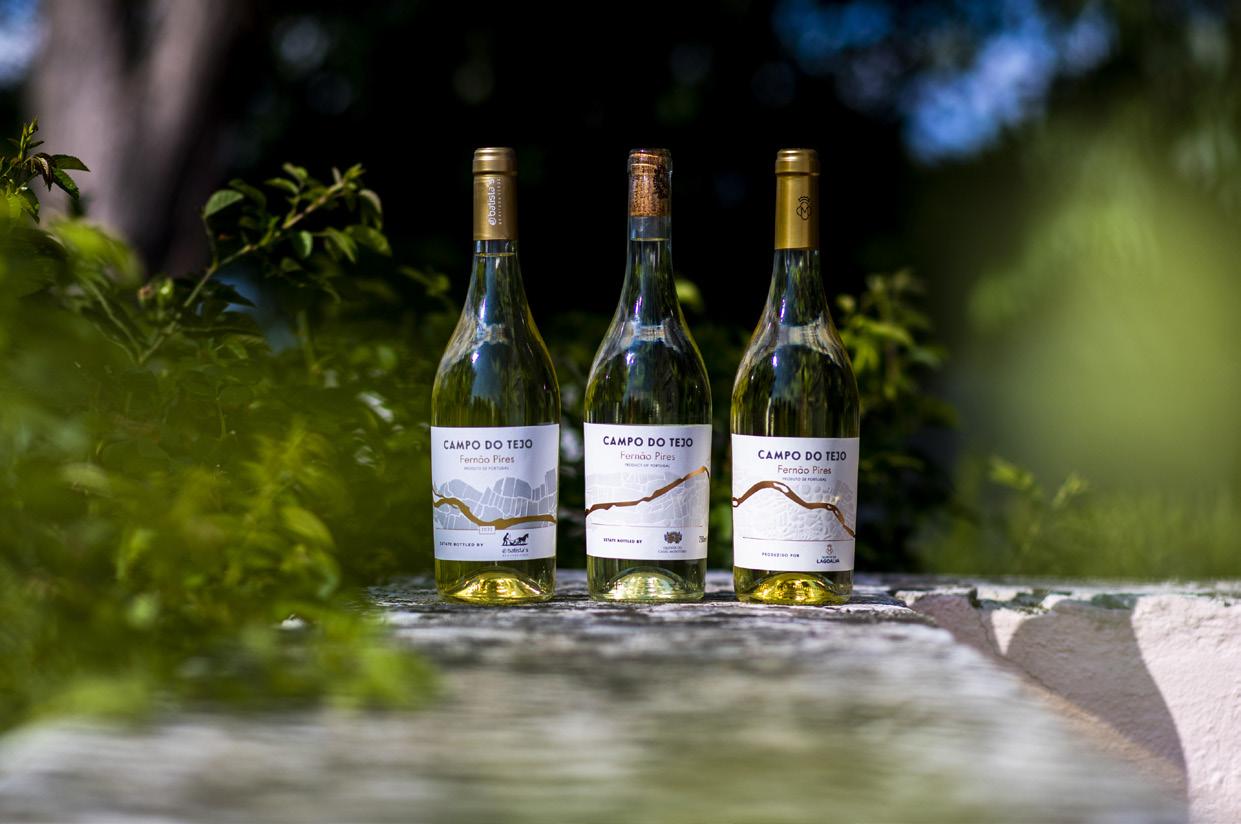
I’ve injured myself. This is typical me –like that time I booked a 10K race only to promptly kick the table I was sitting at and badly break a toe. A clear sign that, subconsciously, I’m rebelling.
It’s been the perfect excuse to not take myself too seriously for a few weeks. Perfectly timed, as this is the time of year that one has social plans, daaaarrrrling The Wine Club summer social being a particularly fun afternoon.
The Wine Club has been meeting weekly since May 2020 over Zoom. During lockdown I realised that I was missing the daily interaction with customers. Wine Club was a simple idea – to open one wine per week and present for half an hour before allowing questions.


I never really expected it to go anywhere but it seemed worth a punt, if only to break
up the monotony of life at that time. It quickly became a monster. I’ve learned more about wine in the last three years than I have in the rest of my 18-year career. I’ve presented a deep dive into regions, grape varieties and production methods (including a six-week investigation into ageing vessels that I am particularly proud of). To talk for 30 minutes straight about one wine, every single week, and keep it interesting … I’ve really had to do my research.
This group knows each other – new jobs/homes, published books/articles, weddings, special birthdays. You name it, we’ve lived this together through a screen every Wednesday evening. I’ve seen holiday apartments as people tune in abroad, not wanting to miss out. We’ve even seen an Alaskan glacier.
There’s no doubt this group has got me, and each other, through difficult times along with the good and they are very much the reason that I love what I do so much. They are the anthesis of those “difficult” customers that occasionally darken the day (a fellow business owner adds an ‘n’ to customer here – insert that where you see fit).
At its largest, Wine Club had about 40 subscribers but we’re down to a postpandemic 20-ish. This 20 is a core of nonsense-talking individuals obsessed with maps and coming up with ever more absurd themes for me to shoehorn a selection of wines into. Currently we’re embarking on “seven deadly vins” with each wine tied to a deadly sin. This is the most ridiculous theme we’ve had, but I am secretly proud of the reasons for some of these choices.
Sometimes I think that commercially I should be trying to encourage more people to join, but there is that moment every single week where an offtopic conversation starts and I remember that no one else needs to hear this. I don’t think that the general population is interested in joining a debate about the animal with the largest penis relative to body size, or an overly long piece about how to properly sex your tomatoes.
The summer social was a glorious afternoon spent playing croquet, eating cucumber sandwiches paired with Bacchus and scones paired with Brachetto, among others. This was food and wine matching fun that kept me updating my whiteboard in a frenzy for several weeks as yet another “great idea” popped into my head.
This bunch of wine enthusiasts from different backgrounds, all with different tastes, are simply wonderful, and it’s a rare delight to see people that probably wouldn’t have got to know each other in real life connecting, sharing and enjoying the vast majority of the wines I’ve been peddling. I hope I get to spend many more Wednesdays with them.
There’s a reason why Provence is regarded as the global benchmark for rosé. Somehow its wines just hit the mark with their crispness, sophistication and elegance – and always a breezy joie de vivre. These wines are, fundamentally, all about pleasure.
They come from a region that basks in 250 days of sunshine each year, with the Mistral and the Mediterranean lending a welcome cooling influence. It’s a landscape most of us can picture, with its fragrant lavender fields, lush greenery and crystal blue seas.
Vignerons, of course, understand their terroir rather more deeply than this. For them, Provence is a patchwork of hills, mountains, valleys and coastlines in which soil and weather systems can vary much more than tourists might imagine.
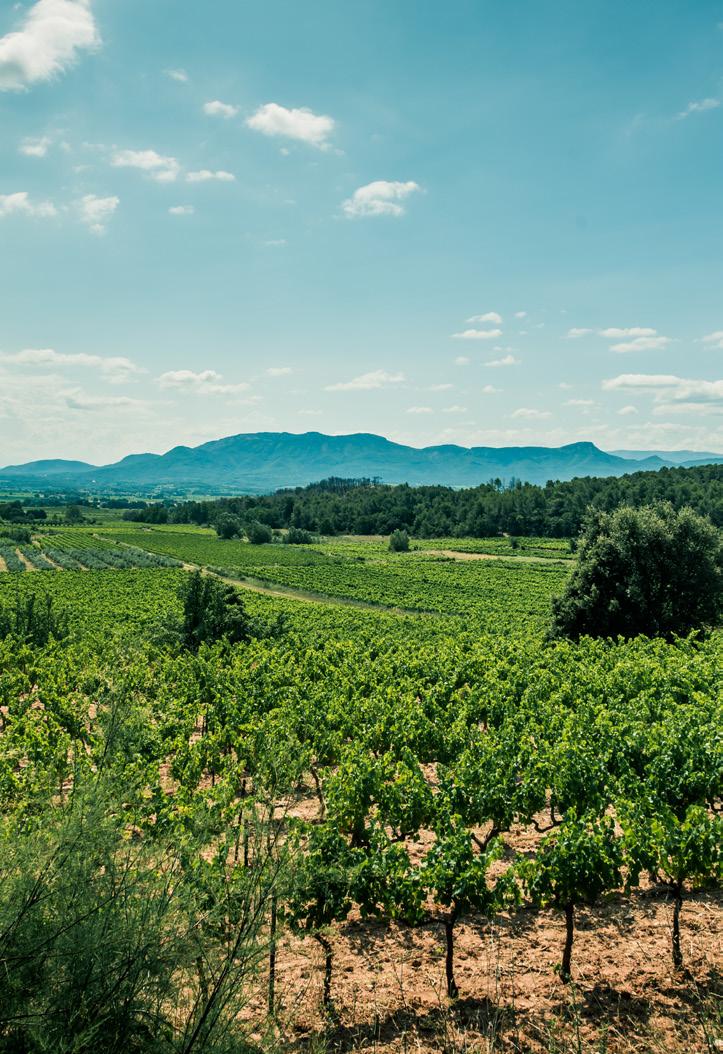
In fact Provence is divided into three appellations, each producing a style of rosé that is unmistakably Provençal and yet expresses some distinctively local characteristics.
The largest of the three appellations, accounting for 71% of production, stretching from the Med to the mountains. It’s a diverse landscape, but a typical rosé will have a tangy freshness and manage to be both generous and light at the same time. On the nose, expect to find flowers, yellow and red fruits and perhaps even marshmallow. The finish is often persistent and very fruity.
The limestone soils in this appellation between the Rhône and Durance rivers give rise to shimmering, salmon-pink rosés. On the nose, floral and red-berry
When it comes to rosé, the French region remains at the pinnacle of excellence, making versatile wines that shine all year round and in every type of drinking occasion© Cédric Skrzypczak-CIVP
characters are common, sometimes with some sweet spice. These are rosés with structure and backbone, adored for their thirst-quenching qualities. They make up about 18% of production.
The minerality and freshness that characterise this appellation, which supplies around 11% of Provence rosés, are partly due to the cold winters. The wines are pale and the nose is complex, suggesting citrus and tropical fruits. Elegant yet generous on the palate, these wines are loved for their aromatic qualities and persistent flavours.
It’s true that plenty of winemakers around the world model their rosés on the Provençal template. Copying the salmon-pink or onion-skin colour is not
too difficult; what they find impossible is to match the aromatic complexity. There’s really only one place in the world where rosés of this depth and quality can be produced, and it happens to be Provence.
The UK is the number two export market for Provence rosé, after the USA. The wines have a loyal following here for all kinds of reasons, but perhaps versatility is right at the top of the list. The wines are equally at home in formal or relaxed settings; in the height of summer or the depths of winter (large formats are big sellers at Christmas time); and with or without food.
Provence rosés – particularly wines that have spent some time in barrel – are an excellent choice with many dishes, and not just the seafood or light summer lunches

that might spring to mind most readily. Many are perfectly at home with meatier meals – and there can’t be too many wine-loving Brits who haven’t enjoyed a Provence rosé with a curry.
Consumers – and merchants – are rightly asking more questions about the sustainability of their wines, and the issue has reached the top of the agenda in Provence too.

Around half of the region’s vineyards are now organic, and the aim is for 100% of the vineyard area to have some sort of environmental accreditation by 2030. Growers are being encouraged to plant more cover crops.
Through the Centre du Rosé, the only research centre in the world dedicated to rosé wine, Provence is working on the best ways to preserve freshness, balance and aromatic expression in the face of climate change.
And although Cinsault, Grenache and Syrah are likely to be the principal red grapes of the region for the foreseeable future, Vins de Provence has sanctioned the use of Rousseli, Agiorgitiko, Calabrese, Moschofilero and Xinomavro grapes, and experiments on heat-resistant grape varieties and cultivation methods are continuing.

Saint Honorat Rosé 2022
Côtes de Provence
RRP £17.12,Vinatis
A blend of Grenache, Cinsault and Mourvèdre, aged on its lees for three months, adding a little roundness to a classic, salmon-pink Provence rosé which is all about zippy freshness and lovely fruit purity. There's a note of salinity, too, and a faint spicy character that makes the wine a perfect ambassador for the Côtes de Provence appellation and a very versatile partner for all sorts of cuisines.

Côtes de Provence
RRP £15,Noble Green Wines
Grenache makes up just over half of the blend, with Cinsault and Syrah playing supporting roles in a rosé that has plenty of big, bold flavours and not just the subtlety you would expect. It's a joyous, summery wine, made organically, combining minerality with generous peach and red-fruit characters. Another multi-faceted wine that could combine well with all kinds of dishes.

Rosé Classique 2022
Coteaux Varois en Provence
RRP £19,Emile Wines


Grenache, Cinsault and Rolle make up the blend here, which is produced by a producer converting to organic viticulture and committed to high environmental standards. There's a delicious sting to the wine, making it stand out from many of its peers, and a suggestion of something more green and leafy in addition to the strawberry, nectarine and citrus flavours. There's plenty of time to contemplate these things as the length is so good.

Rosé 2022
Côtes de Provence
RRP £24.95,Fine Wine Direct
The organic-certified vineyard is 300m above sea level, making it cooler than its coastal cousins which encourages grapes to ripen slowly and evenly. The wine emerges pure and intense, with some tropical notes alongside the citrus and white-fruit flavours. It's this ripe, juicy character that makes the biggest impression, but as the wine finishes there are more mineral elements that come to the fore.
Château La Coste
Rosé 2022
Coteaux d’Aix-en-Provence
RRP £22.50,Wanderlust Wine Club
It's always hard to resist listing the familiar fruit flavours that you typically find in Provençal rosés, and here we encounter some familar peachy elements as well as some more exotic species, all of which are generous and luscious. But maybe the wine's most interesting feature its pleasant savoury edge, which is particularly evident on the finish.
Bastide 2022
Coteaux Varois en Provence
RRP £14.90,Seeking distribution
There's a playful sweetness lurking in this organic Grenache/Cinsault/ Mourvèdre/Cabernet Sauvignon blend –not in terms of residual sugar, but in the aromas that emerge from the glass, suggesting sweet shops, maybe, or a patisserie. On the palate we're more in peach and lemon territory, and there's a mineral seam that keeps you coming back for more. All in all, an excellent advertisement for the appellation.
Maire-Christine
Côtes de Provence


RRP £15.28,Armit Wines

Of all the wines we sampled for this project, this was the one with the silkiest mouth feel, and the deepest colour. So it was no surprise to discover a richness to the Cinsault, Grenache and Syrah blend, which is brimming with red-fruit characters and complex aromas. But there's a savoury note lurking in the background, making this a a beautifully balanced wine with appeal for connoisseurs and dabblers alike.
Baron M
Jardin d'Amour 2022
Coteaux d’Aix-en-Provence
RRP £11,Drinkworthy
The first thing that strikes you with this Grenache, Syrah and Cabernet Sauvignon blend is its gorgeous creamy texure and fruit salad notes. But then you start to notice the spices unravelling on your palate – cinnamon, maybe, and even what seems like distant chilli. A treat on its own, no doubt, but definitely a wine that would hold its own and even be enhanced by Asian dishes and many types of curry.
Suivez-moi-jeune-homme 2022
Coteaux Varois en Provence
RRP £13.20,Seeking distribution
An organic blend of Grenache, Cinsault and Syrah which has clearly been handled with great sensitivity from picking to bottling. It epitomises the freshness and elegance of the appellation, and yet there's a certain liveliness to the wine that goes beyond this. There's an intensity to the stone-fruit and citrus flavours and a herbal note too, making it a wine that can easily be enjoyed on its own, without food.
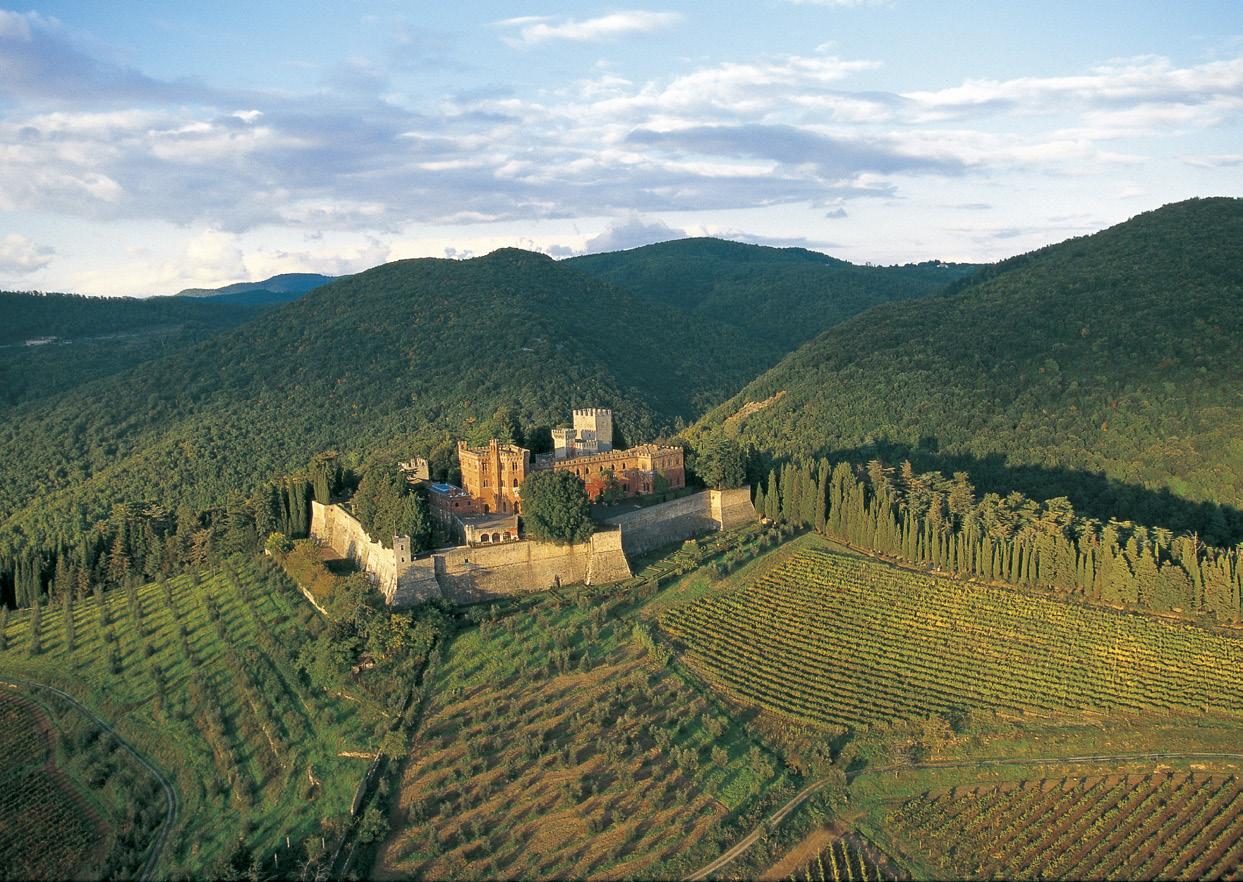
The region’s new UGA classification recognises 11 districts, each with its own distinctive terroir and wine characteristics. Camilla Wood of The Somerset Wine Company reports back on a trip intended to help the UK trade understand what’s happening
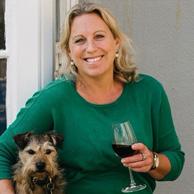
For those of us of a certain age, a few iconic wine bottles conjure potent memories of our parents’ 1970s drinking habits. Mateus rosé in its curved flask; Blue Nun behind its azure glass; and the king of all kitsch, Chianti, in its wide-bottomed straw fiasco, which graced many a G-Plan sideboard thanks to its dubious credentials as an ersatz lamp or candleholder.
Those were the days when, to quote
Paolo de Marchi, outgoing owner of Isole e Olena, Chianti tasted of “lemonade in a sandpaper glass”. Back then, Chianti was a very different beast to the violet, blood and bramble-scented Sangiovese it now embodies.
It was the wine of the workers, the share-croppers who blended Sangiovese with Trebbiano and diluted the mixture with water to drink in the fields and vineyards. No one cared that it was
searingly acidic (de Marchi remembers a pH level of 2.92 in Isole e Olena’s 1976 Sangiovese – lower, he points out, even than Champagne).
This was desirable in a wine consumed primarily as a thirst quencher. In those days, few people in the region drank “pure” wine. And, in the UK, our bell-bottom wearing parents were similarly content with the lean, mean, fiasco-encased Chianti machine.
Much has changed in just a few generations. De Marchi says it feels more like 600 years than 60. Chianti has grown up: it’s shaved, cut its lank hippy tresses and become a cool, suave Gen Z-er, assuming its rightful place on the world’s stage of fine wine.
Chianti has seen the most tumultuous change of any Italian wine region. It was legally demarcated in 1716 by Grand Duke Cosimo III. The map was redrawn in 1932, dividing the region into seven zones, one of which was Chianti Classico.
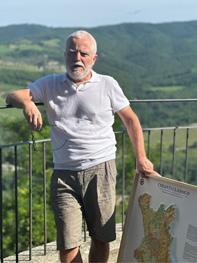
The Consorzio Vino Chianti Classico, represented by the Black Rooster symbol, was established in 1924 and is the oldest consortium of wine producers in Italy.
DOCG status came much later, in 1984. Only Sangiovese was permitted in wines from Chianti Classico, consolidating its position as the leading grape of the region.
Further quality improvements flowed in 2005 with the banning of white grapes and the stipulation that 80% of a Chianti blend must be Sangiovese.
2014 was another big year for the region with the establishment of the Gran Selezione category, adding an extra quality tier to the DOCG. These wines can be made only from estate-grown grapes, 90% of which must be Sangiovese, either from a named single vineyard or a selection of the estate’s best grapes, with a minimum ageing of 30 months, of which three have to be in bottle: the most profound expression of the producer’s individual terroir. These are special, flagship wines and not made in every vintage.
The audacious Super Tuscans are here too (under the IGT category): big Parkerpointy show ponies for the high-rollers, where Sangiovese often plays second fiddle to the international grapes of Cabernet, Merlot and Syrah.
But in Chianti Classico they feel like the playground bullies: it’s emphatically all about Sangiovese, described by one producer as a flirtatious woman with an occasional aggressive streak. The Annata (latest vintage, early drinking, fruitforward), Riserva (24 months minimum ageing and minimum 12.5%) and Gran Selezione categories are where this
Pavarotti of Italian grapes sings loudest and proudest.
The main purpose of our trip was to get to grips with the 11 newlyformed UGA districts (Unità Geografiche Aggiuntive, or Additional Geographic Units) which came into effect in 2021. The initials will only be allowed to appear on Gran Selezione wines, at least for the time being.
A long-term mapping project, run by Alessandro Masnaghetti (pictured left), has just been completed to help illustrate and explain these new geographic and administrative areas.
Greve UGA, with predominantly galestro or shale soils, and home to Querciabella, represents wines with a darker, rounder fruit profile; violets and somewhat austere tannins.

Vagliagli UGA, the home of Dievole, shows dark, brooding wines of power and concentration emanating from its albarese/limestone and marl soils and hotter microclimate.
Panzano UGA, where we tasted at Fontodi, exhibits similar black-fruited depth with liquorice and earthy notes.
Lamole, the smallest and highest UGA at around 550 metres, is one to watch as climate change forces growers to look further upwards to cooler plots. Its lighterbodied wines display a certain tension, as well as freshness and floral notes.
Ripe cherry fruit, lighter structure and silky texture characterise Capannelle’s wines from the Gaiole UGA with its predominantly macigno/sandstone soils.
San Casciano, home to alluvial soils, also produces wines that are lighter and linear in profile, with ripe red fruits and a dancing minerality. Le Corti Corsini’s Gran Selezione ZAC 2019 embodies this beautifully.
Clearly this idea of separating a region into sub-zones according to terroir isn’t a new one. It’s been prevalent in Burgundy since time immemorial. Rioja split into three sub-regions in 1976 with further geographical categories, such as specific villages, permitted on labels from 2017. Barolo and Barbaresco introduced their Menzione Geografica Aggiuntiva in 2010. Now Chianti Classico is catching up, and rightly so.
It's a large region, 47km x 27km, and diverse enough to justify this kind of subdivision. Altitude ranges from 300 to 700 metres and vineyards have a wide variety of aspects. Coastal breezes are a factor and there are various soil types to add to the equation.
As if further evidence was needed for the coming of age of this region, Dievole’s Chianti Classico DOCG Petrignano 2019 was named Gambero Rosso’s Best Italian Red 2023, a title usually taken by a Barolo, Brunello or Super Tuscan wine.
Celebrating geographic diversity is certainly the way to go in Chianti Classico. And yet, as Paolo de Marchi, Giovanni Manetti of Fontodi and Prince Duccio Corsini of Le Corti Corsini are at pains to stress, heritage and local traditions will always be more important than any drawn boundaries. The beating heart of Chianti Classico are the winemakers at the centre of their terroir.
It’s an exciting time for this most beautiful and iconic region, and no raffiabottled past is going to hold it back.
The Bancroft team will be presenting more than 120 wines from across the portfolio.
Several new producers include Marlborough’s Zephyr Wine from winemaker Ben Glover (pictured), Massoc Frères’ terroirfocused range from Chile’s Itata Valley and the importer’s first Croatian estate, Domus Susak.
Email hvansusteren@ bancroftwines.com.
Tuesday, October 3
ICA the Mall
London SW1Y 5AH
The importer will be showcasing 100 premium, artisanal wines produced by family growers from France, Italy, Spain, Greece, Lebanon, California and Argentina.
Highlights include Lyrarakis, Massaya, Brumont, Fourny, Paul Prieur, Vieux Telegraph, Bruno Sorg, The Hilt, Talley Wines, Argiano, Durigutti, Le Soula, Jean Luc Jamet, Vincent Girardin and many more.
For more information or to register, email katie@thormanhunt.co.uk.
Wednesday, October 4
Salut Wines
11 Cooper Street
Manchester M2 2FW
A walk-around tasting focusing on wines from Australia, New Zealand, South Africa and Chile.
Join Murray McHenry, founder of McHenry Hohnen for a masterclass with winemaker Jacopo Dalli Cani as they discuss the biodynamics of Hazel’s vineyard in Margaret River.
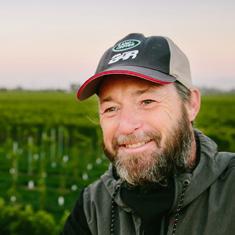
To register and for more information email marketing@louislatour.co.uk.
Wednesday, October 4 Asia House
63 New Cavendish Street London W1G 7LP
The tasting will showcase wines from 15 wineries including Chateau Pinot (Odessa), Biologist Craft Winery (Kyiv) and Beykush Winery (Mykolaiv).
To register, email clare@island-media. co.uk.
Monday, October 9
67 Pall Mall London SW1Y 5ES
An opportunity to meet French winemakers who are seeking UK representation.
For more information and to register,
contact richard@iubentium.co.uk.
Monday, October 9
Noizé
39 Whitfield Street
London W1T 2SF
This tasting will showcase all the key agencies from Italy and around the world as well as launch new agencies such as Benanti from Mount Etna.
Salvino Benanti will be presenting his wines in person. Other visiting producers include Yerringberg, Yarra Valley; Bosman, Wellington; and Tenuta Dornach, Alto Adige.
Portuguese specialist Festa Wines and Polish importer Central Wines will also be in attendance.
Email andrew@woodwinters.com.
Monday, October 9
St Martin’s Hall
Trafalgar Square
London WC2N 4JH
An opportunity to taste wines from the biodynamic Avondale Estate in Paarl, as well as from one of Georgia’s superstar winemakers, Giorgi Solomnishvili. From Languedoc, Le Professeur Marselan, Big Beltie Cabernet Sauvignon and the range of Domaine St André will be on show.
Contact sales@cachetwine.co.uk
Monday, October 16
The Low Wood Hotel
Windermere LA23 1LP
The parent company of GCF Exclusive is showing the highlights of its wide portfolio.
Although French-operated, and with a range of wines that covers virtually every corner of France, the family-owned company also owns or has links with award-winning producers in South Africa, Chile, Spain and Germany, among other places.
See page 72 and scan the QR code to register.

Tuesday, October 17
St Mary’s Marylebone
Wyndham Place

London W1H 1PQ

Around 50 wines will be on show at this tasting, some already available in the UK market and some seeking representation.
For more information and to register for the event, email mbourgeois@sopexa. com.
Wednesday, October 18
Lumiere London Underwood
6-14 Underwood Street
London N1 7JQ

This event will bring together the new line-up of the 100 winning wines from the 11th edition of the Sud de France competition as well as other selected wines from 20 of the winning producers.
For more information and to register, email sebastien.duboullay@occitanielondon.com.
Thursday, October 26
The View @ Royal College of Surgeons
38-43 Lincoln’s Inn Fields
London WC2A 3PE
The event starts with an 11am masterclass with Masters of Wine Sarah Jane Evans and Alvaro Ribalta, focusing on Xarel.lo, its history and the styles of wine it makes.
From 12 noon until 4pm there will be a walkaround tasting of Xarel.lo and other indigenous Penedès varieties, featuring around 18 wineries and 50-60 wines.
Email info@limmpr.com to register.
Monday, October 30

Asia House
63 New Cavendish Street
London W1G 7LP
The Boulevardier is having a bit of a moment. It’s essentially a wintry take on the immensely popular Negroni, where sweet smoky bourbon – or sometimes rye whisky – is substituted in for gin. Though the Boulevardier is often regarded as a Negroni twist, it is thought to pre-date it by around 20 years, attributed to the Paris-based American writer Erskine Gwynne, who in 1927 named it after a literary magazine he’d founded. This twist on a non-twist adds some autumn (not too) mellow fruitfulness for a more bitter-sweet take.
5cl bourbon
2.5cl sweet vermouth
2.5cl Campari
2.5cl fresh blood orange juice
Add all the ingredients to a mixing cup filled with ice. Give it a lengthy stir. Strain into a tumbler. Garnish with a twist of the orange peel.

It has been said more than once –today? Here? – that things get shitter and shitter and indeed they do, but we must be on alert to find the jewels in the shit.
Weird Ben – when he existed – said that climate-change Britain was going to be warmer, sure, and considerably wetter, which looks pretty accurate. Yesterday there were two distinct rains at the same time, Big Fat Rain and Wet Rain. Craig and I watched admiringly as the two rains danced and filled up the Colebrook Lane Lake across from the shop. It isn’t a lake, obviously, it’s a loch, brought on by torrential rain and the inability of Glasgow City Council to make anything work – in this case, a drainage system. (Fun story – in the rush to pretend that our roads were remotely suitable for high-speed cycling preceding last month’s Cycling World Championships, GCC covered every gutter on Gibson Steilhang with tarmac, resulting in an entirely new rival river being forged next to the Kelvin, which I have termed the Ahoy Hoy! Which is quite funny if you can remember who Chris Hoy is). There is something very lovely about watching water slowly rise around a Tesla, marooning it in its smug sleekness. Lovelier still when the driver returns from Furrowed Balls with two cans of paint to find the robotwhooshwhoosh completely inaccessible unless they use the paint cans as makeshift stilts. The twinkling sweetcorn of yesterday.
Today’s high point is that the kids have gone back to school. When I was of schooling age, I hated the glee with which adults counted the days down until our return to school. Now – I vibe that so much. Goodbye kids! Get off your phones!
So really everything isn’t that shit, is it, when we can watch well-intentioned
Phoebe Weller of Valhalla’s Goat in Glasgow knows that while the end of the school summer holidays comes but once a year, every day is Scone Day
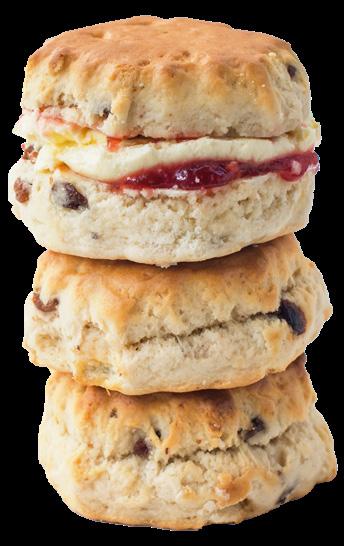
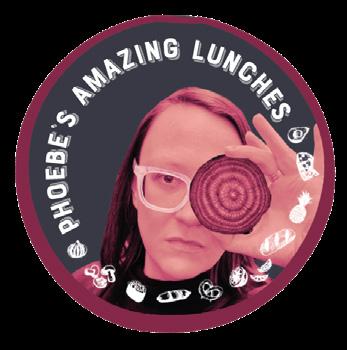
greenwashed cars float eventually away and revel in an empty pool at two in the afternoon without being cannonballed by teenage boys.
And of course, it being September, we can celebrate the festival of the best and the fastest of Post-Amazing-Lunch baked goods, which this year has been grouped with two less appealing products, Toms and Sauvignon Blancs. It’s Scone Week, people!
Someone in the Hippy Shop (we are not sure who – maybe this is what the octogenarian chief hippyowner adds to the mix?) makes really magnificent scones, tilting away to the side all creggedy and sugary shouldered and ready for an even 7mm coating of butter and smear of apricot jam, which we in VG call: Anything but Chardonnay.
Every day is Scone Day here, luckily, as in the local dialect the greatest week of the year becomes Scans, Tams and Sauvignon Blancs. Repeated scans on the downstairs computer trigger the oversensitive firewall, making the linked till system more of an honesty box, but no worries! as we are busy joyously garlanding Tams; Big Tam, who eschews SB in favour of a can of Dark Fruits Strongbow and Oor Tam, who amongst myriad BBC appearances once famously quipped that SB was “the Stella of the wine world, and I don’t mean McCartney”. He is working on a musical comedy with Frankie Boyle exploring Kelvinbridge’s grubby, waterlogged glory, kind of like HMS Pinafore but potty mouthed and miserable. I for one can’t wait.
Of course there is the rival highbrow March festival of Scones, Tomes and Cote de Beaunes of which I will have no part. Wankers.




12-14
0207
enquiries@louislatour.co.uk

www.louislatour.co.uk
Louis Latour Agencies presents:
A Journey Through the Southern Hemisphere Portfolio Tasting

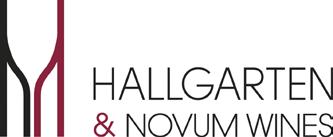
4th October 2023 10am-4pm, Asia House, W1G 7LP

This is the first time Louis Latour Agencies will be focusing on the Southern Hemisphere, and a rare opportunity to experience the family-owned and independent wines from Australia, New Zealand, South Africa and Chile as a walkaround tasting. Producers will be flying in from around the world, with a McHenry Hohnen masterclass.
11am-12.30pm: McHenry Hohnen head winemaker Jacopo Dalli Cani and founder Murray McHenry. Join Jacopo Dalli Cani talking through the biodynamics of Hazel’s vineyard, located in Margaret River, as well as an in depth look at some of the great single-vineyard Chardonnays of Western Australia, and a look at the diversity of the Hazel’s Vineyard site.
Scan the QR code to register.
Luton

The Dutch Barn Woodcock Hill
Coopers Green Lane
St Albans AL4 9HJ
01707 274790
info@gonzalezbyassuk.com www.gonzalezbyassuk.com
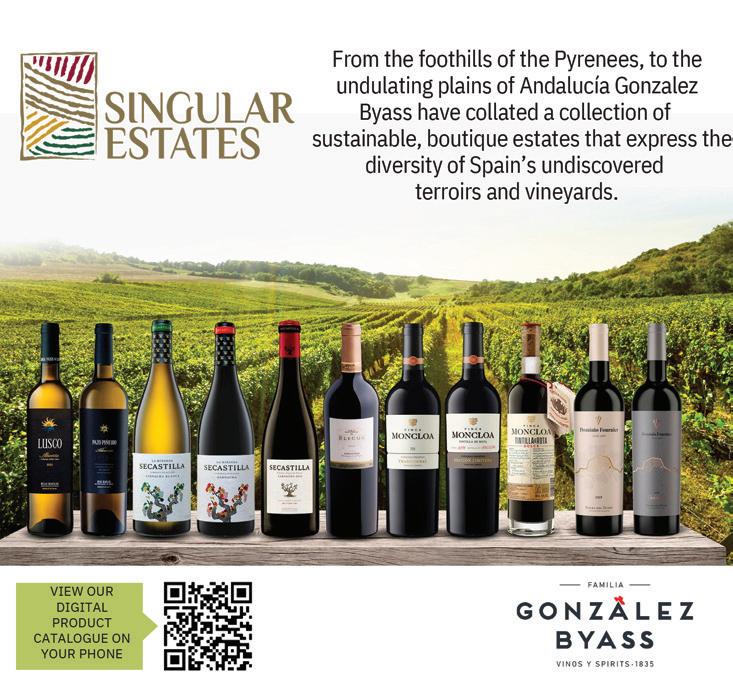
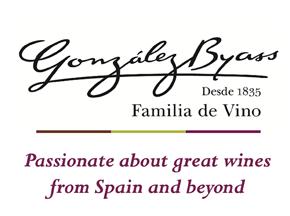
@gonzalezbyassuk
orders@walkerwodehousewines.com www.walkerwodehousewines.com
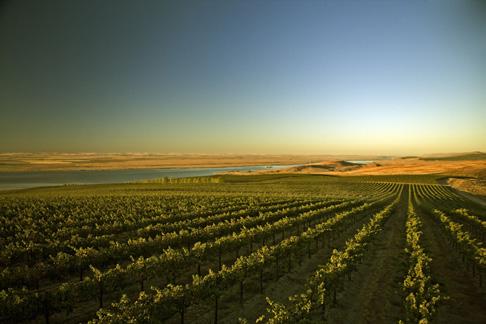
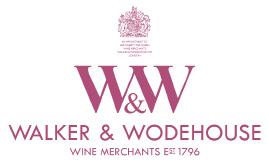
@WalkerWodehouse




Ste Michelle Wine Estates, one of the USA’s most well-respected wine companies, has joined Walker & Wodehouse’s portfolio.
The Ste Michelle Wine Estates portfolio features some of the leading wineries from the world’s most renowned wine regions. This includes Chateau Ste Michelle, one of the most acclaimed wineries in Washington State. Chateau Ste Michelle, Col Solare, A-Z, Erath, Rex Hill , Patz & Hall and Columbia Crest will all be available through Walker & Wodehouse.
Ste Michelle Wine Estates is dedicated to operating sustainably both in the vineyard and in the cellar as well as supporting the communities they operate in. It runs the Chateau Ste Michelle Scholarship Fund which gives four college scholarships to Washington State University to deserving students who otherwise would not be able to attend college.
2 Wells Road
Walsingham NR22 6DJ
01328 641357
sales@martavine.co.uk

MartaVineLtd



New Bank House
1 Brockenhurst Road
Ascot
Berkshire SL5 9DL
01344 871800
info@hatch.co.uk
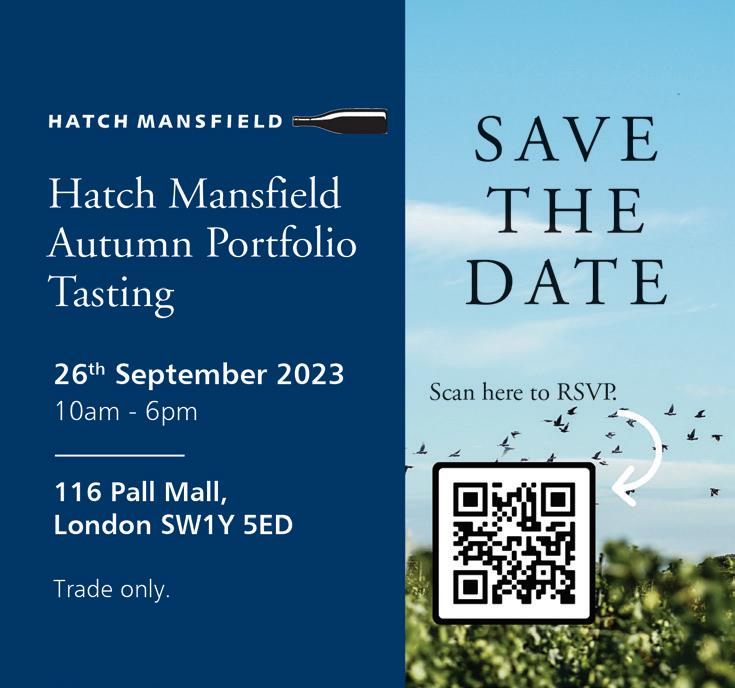
www.hatchmansfield.com
@hatchmansfield


1, rue Division Leclerc, 67290 Petersbach, France
chris.davies@lgcf.fr
07789 008540
@FamilleHelfrich

@gcf_exclusive_uk


Jessica Hutchinson
jessica@vindependents.co.uk
www.vindependents.co.uk

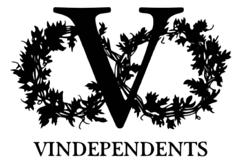
@vindependents
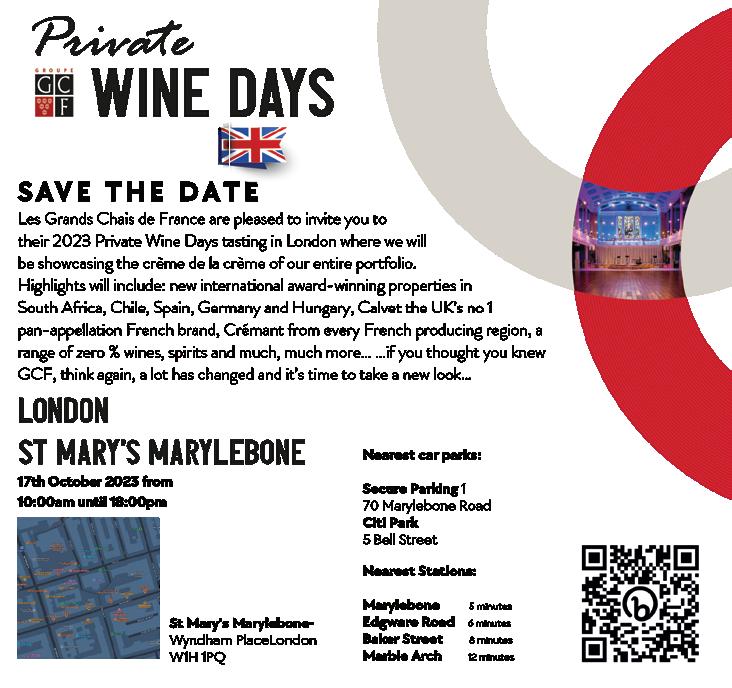

London SE1 3UD
020 7840 3600
info@mentzendorff.co.uk

www.mentzendorff.co.uk


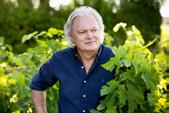


A supple Merlot-dominant blend with Cabernet Franc and Cabernet Sauvignon making up the rest. This wine has a bouquet that characteristically displays hints of red fruit and lovely aromatic persistence. This is a deep, balanced wine, crafted to be kept, which matches subtly with a Bordeaux-style entrecote steak or an exotic dish.
“Sweet, floral notes lift the red berry fruit in this gracious, mid- weight wine. Raspberry, wild flowers, mocha, spice and mint all run through this lithe, silky wine.” 92 Points, Antonio Galloni, Vinous

Unit 5, The E Centre
Easthampstead Road
Bracknell RG12 1NF
01753 521336
info@buckingham-schenk.co.uk

www.buckingham-schenk.co.uk

@BuckSchenk
@buckinghamschenk
Made from the oldest vines growing in ground made up of large stones lying on top of clay, Le Plus de La Fleur de Boüard expresses the full character of the property’s old Merlot grapes which is the only variety to be used. The wine is then aged for 30 months in 100% new oak barrels including 18 months on the fine lees.
“This is very powerful with a wonderful length. Full-bodied, with ultra-fine tannins and a bright fruit and acidity. Mineral. Wow.”
92-93 Points, James Suckling
For more information, please contact your Mentzendorff Account Manager
AMICALE ENCAPSULATES THE PASSION AND BEAUTY OF THE VENETO HILLS IN THIS ELEGANT AND FRUITY WINE.


A SOFT APPASSIMENTO STYLE, WITH DEEP BLACK BERRIED FLAVOURS, FOLLOWED BY A RICH AND FULL-BODIED PALATE FOR A TRUE TASTE OF THE VENETIAN REGION.
BUY 11 CASES OF AMICALE AND GET 1 FREE (VALID UNTIL 13TH OCTOBER)
La Fleur de Boüard LE PLUS de la Fleur de Boüard7-9 Elliott's Place London N1 8HX

020 7288 8888
sales@jeroboamstrade.co.uk www.jeroboamstrade.co.uk
@jeroboamstrade

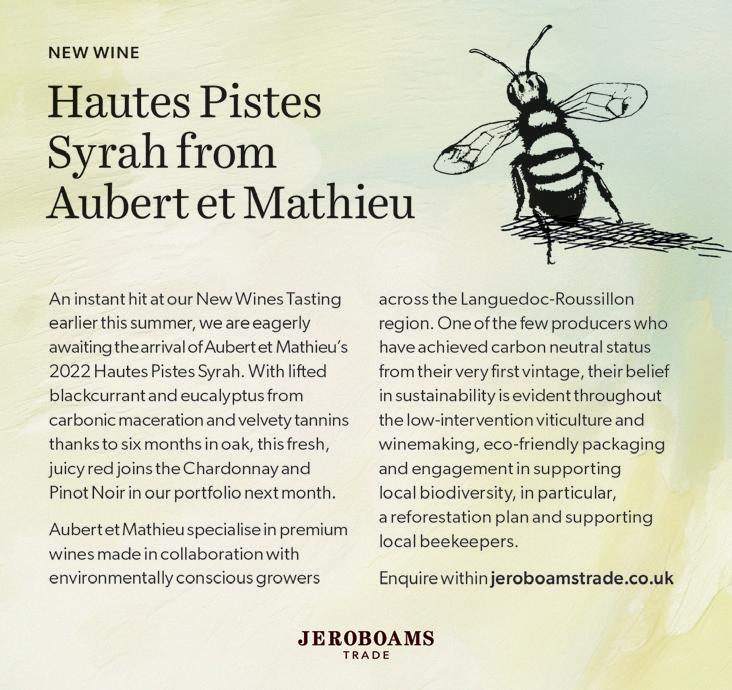

The computer system for drinks trade wholesalers and importers
16 Station Road Chesham HP5 1DH
sales@vintner.co.uk www.vintner.co.uk

4 Pratt Walk London SE11 6AR
0)207 735 6511
info@thormanhunt.co.uk


www.thormanhunt.co.uk
Henge Court
Thame OX9 2FX
07508 825 488
orders@condorwines.co.uk
www.condorwines.co.uk
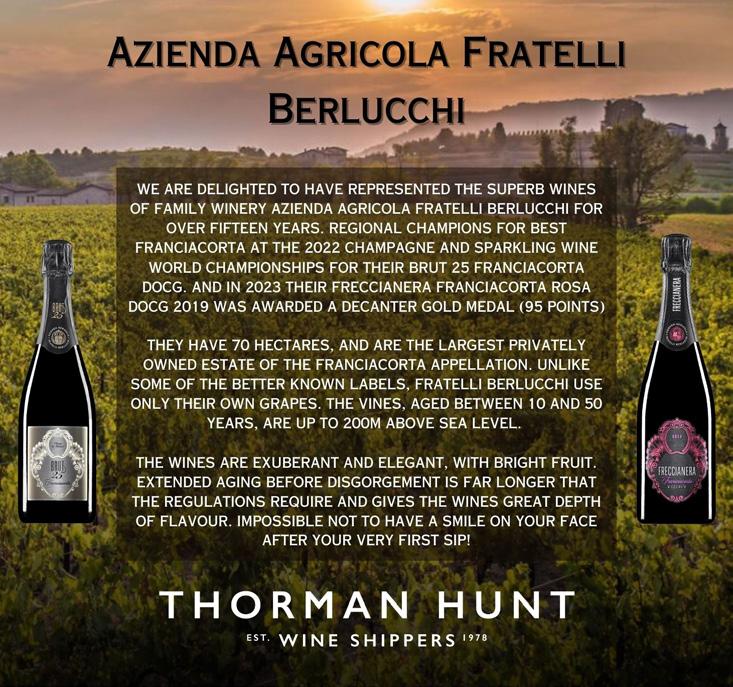
Condor_Wines
Condor.Wines
condor_wines

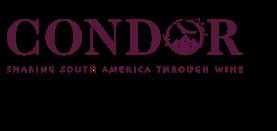

Condor Wines

Fells House, Station Road
Kings Langley WD4 8LH
01442 870 900
For more details about these wines and other wines from our awardwinning portfolio from some of the world’s leading wine producing families contact:


info@fells.co.uk www.fells.co.uk


@FellsWine
je_fells
... is not yet available.

While we work on that, the only way to experience the heady, just-printed aroma of your favourite trade magazine is to get your own copy, and breathe it in while it’s fresh.
If you don’t qualify for a free copy, you can subscribe for just £75 a year within the UK.
Email claire@winemerchantmag.com for details.
Or you can read every issue online, as a flippable PDF – just visit winemerchantmag.com.
There’s no registration, and no fee. And, sadly, no aroma.

The Links, Popham Close
Hanworth
Middlesex TW13 6JE
020 8744 5550 info@richmondwineagencies.com
@RichmondWineAG1


SEPTEMBER 2023
With lots of lovely new wines and old favourites plus our Christmas brochure offers to try, we would personally like to invite you to our 2023 Autumn Tasting.
DATE: Tuesday 26th September 2023


VENUE: The Airstream | Main Courtyard | Paintworks Event Space Bath Road | Bristol | BS4 3EH
TIME: 10am to 4pm with a light lunch and coffee available
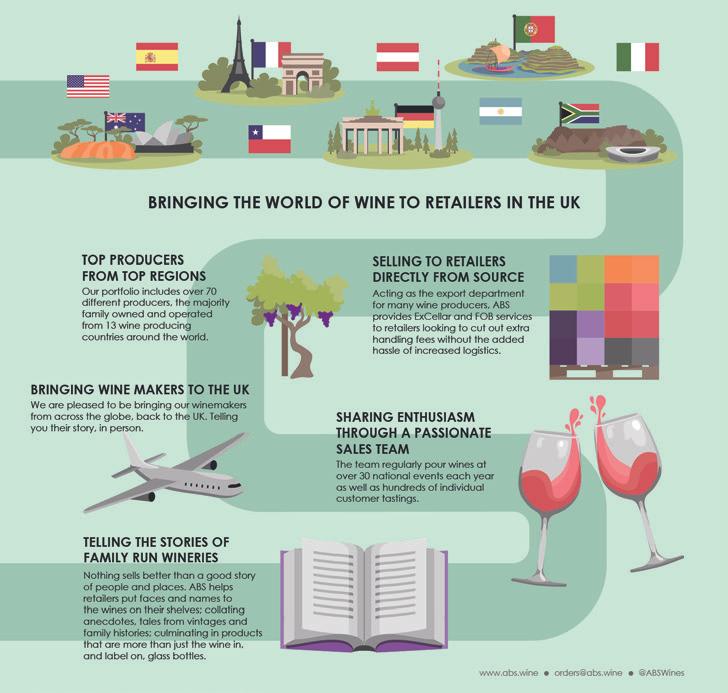

28 Recreation Ground Road Stamford
Lincolnshire PE9 1EW 01780 755810
orders@abs.wine www.abs.wine
@ABSWines
Please RSVP to: tim@richmondwineagencies.com and we hope to see you then!
september 2023

020 7720 5350 order@libertywines.co.uk

South Africa’s wine offering is increasingly diverse, as dynamic winemakers blend traditional varieties such as Chenin Blanc, Cabernet Sauvignon and Cinsault with a host of others well suited to the Cape’s essentially Mediterranean climate.










Widely acknowledged as one of the forerunners of the country’s ‘New Wave’ wine movement, Thorne & Daughters’ flagship ‘Rocking Horse’ sees Roussanne from Stellenbosch, Semillon from Franschhoek, Chardonnay from Ceres Plateau, Chenin Blanc from Paardeberg and Clairette Blanche from the Swartland coming together to “showcase our vision for a Cape White blend”. The Swartland has an abundance of old-vine Chenin Blanc, which adds texture and backbone to Mullineux’s Old Vines White, with Clairette Blanche, Grenache Blanc and Verdelho giving layers of salinity and freshness, as well as Viognier and Semillon Gris its opulent fragrance.
The Leeu Passant Dry Red is their modern interpretation of the classic Cape Cabernet Sauvignon/Cinsault blends of the 1950s-1970s. With Stellenbosch Cabernet Sauvignon giving structure to fragrant old-vine Cinsault (from two of the oldest registered red wine vineyards in South Africa planted in Wellington and Franschhoek) and suave Stellenbosch Cabernet Franc, the wine is capable of ageing incredibly well. At Charles Back’s Spice Route, the signature wine ‘Chakalaka’ is named after a local spice blend and is a similar fusion of flavours, blending Carignan, Shiraz, Mataro, Durif, Grenache and Tannat from dry-farmed bush vines in the Swartland to produce a unique expression of place.
Contact: Alastair Moss


Telephone: 020 3958 0744 @topselectionwines @tswine


World-class sauvignon blanc from breathtaking vineyards in southern Austria.

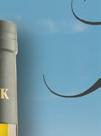
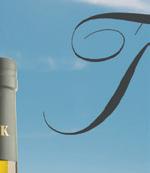
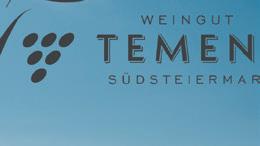











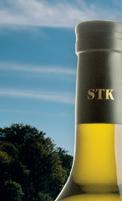

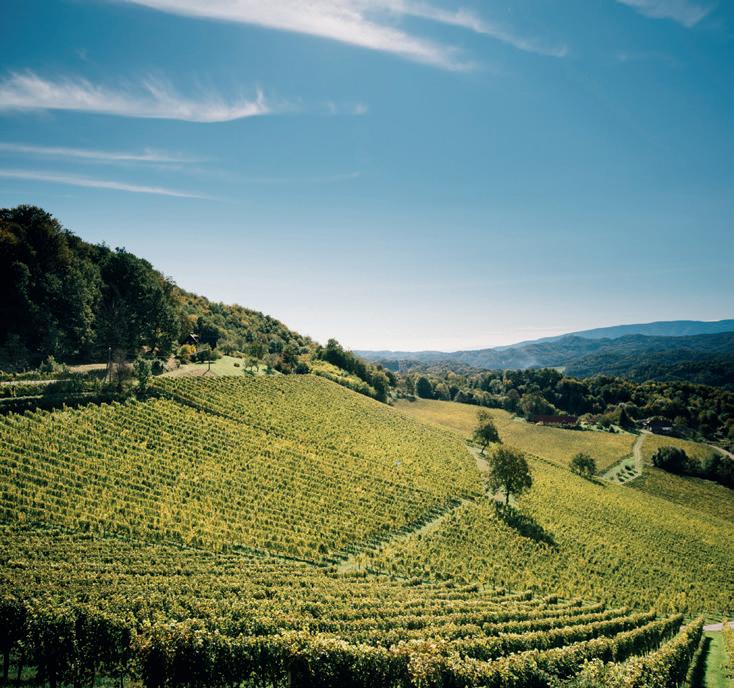
How do you relax?
I don’t. I run 10k twice a week, watch Leeds United, work lots, spend time with my girls and generally run around like a headless chicken. I very rarely sit down.
What’s the best book you’ve read recently?
The Power of One by Bryce Courtenay.
Give us a TV recommendation. Happy Valley. British drama at its very best and based near where we live.
Do you have any sporting loyalties? Leeds United.
Who’s your favourite music artist? My sister – “Eversholt”. Look them up on Spotify. They almost made it in the 90s, were tipped for stardom and supported by Muse on several occasions.
Who’s your favourite wine critic? Victoria Moore. She is local to Ilkley, and is down to earth and entertaining.
What’s your most treasured possession? My salmon rod.
What’s your proudest moment? Becoming a dad.
What’s your biggest regret? I do not have any.
Any susperstitions?
A single magpie has to be waved at.
Who’s your hero?
Born in 1967, Jonathan Cocker started his working life helping run the family hotel in Northumberland before spells in the hospitality industry in South Africa, Australia and London. He then joined Martinez Wines, eventually buying the business from the Martinez family. In addition to the original Ilkley branch, the company has a shop and wine bar in the former Conservative Club in Bingley.

What’s the first wine you remember drinking?
White Graves with my dad. My love of wine started at 11 years old when dad would crack open a French wine with dinner.
What job would you be doing if you weren’t in the wine trade? Salmon ghillie. I was born to fish and am forced to work! I have fished for salmon from the family hotel, Riverdale Hall, for over 40 years. I used to ghille there before my wife and I moved back to Yorkshire. I am partly responsible for putting North Tyner salmon fishing on the map.
Matt Johnson of The The. His music was the soundtrack to growing up. I just love the way he says what he believes.

Any hidden talents? Nothing hidden!
What’s your favourite place in the UK? Bellingham, Northumberland. This is where the family hotel is and where I call home.
If you could have one wish granted, what would it be? To feel fantastic every day.
“I generally run around like a headless chicken”
